Health
Examine the relationship between self
This study found that participants reported a significant amount of self-injury, averaging 109.27, highlighting a substantial engagement in these behaviors, often driven by difficulties in managing emotions. Participants demonstrated varying coping strategies, reflected in average scores of 40 for cognitive emotion regulation and 63.72 for behavioral emotion regulation. Crucially, we observed strong negative correlations between […]


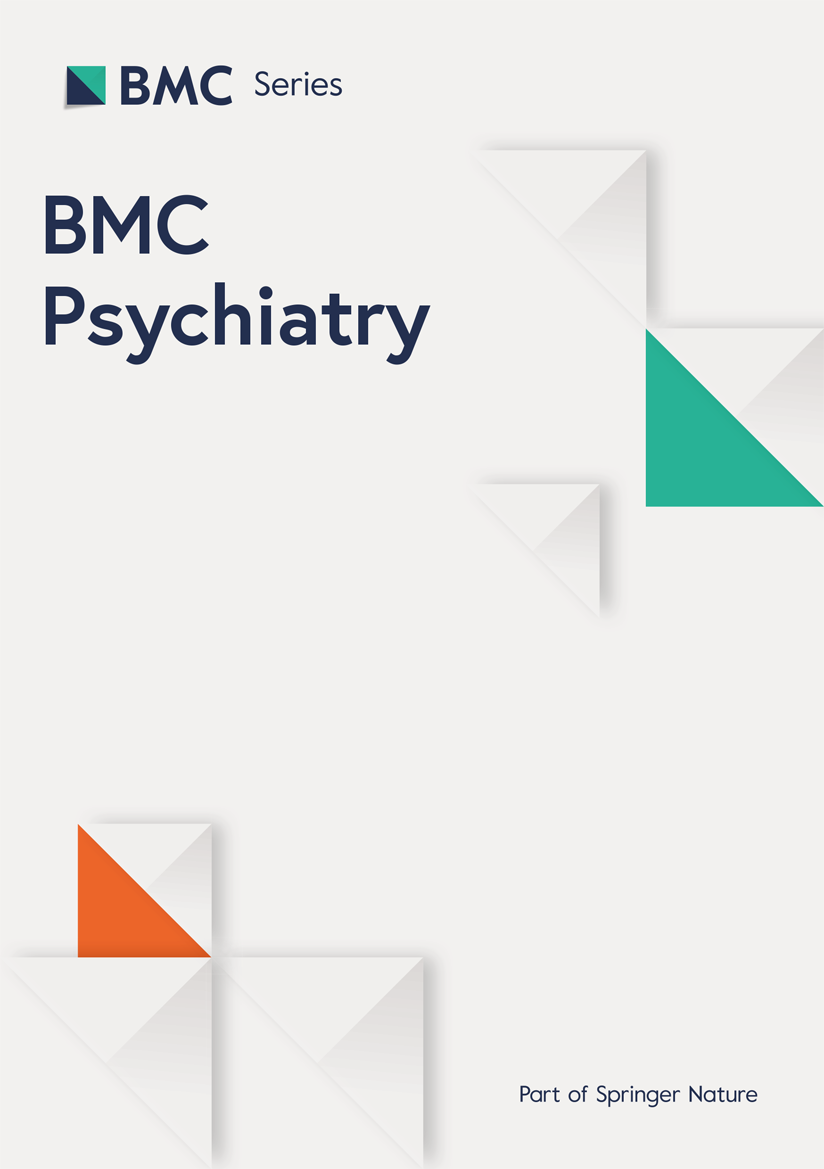
This study found that participants reported a significant amount of self-injury, averaging 109.27, highlighting a substantial engagement in these behaviors, often driven by difficulties in managing emotions. Participants demonstrated varying coping strategies, reflected in average scores of 40 for cognitive emotion regulation and 63.72 for behavioral emotion regulation. Crucially, we observed strong negative correlations between both cognitive regulation (r = -0.64, p = 0.001) and behavioral regulation (r = -0.73, p = 0.001) and self-injury. This means that poorer cognitive regulation and more pronounced behavioral regulation were linked to higher instances of self-injury. Further analysis, using multiple regression, confirmed that these two emotion regulation styles accounted for 42% of the variation in self-injury, with behavioral regulation showing a particularly strong predictive effect. In essence, these results emphasize the critical role of emotion regulation interventions in supporting adolescents vulnerable to self-injury.
The present study revealed a concerning prevalence of self-injury among Iranian adolescent athletes. While self-injurious behavior can be transient, this study, conducted at a specific point in time, offers a valuable snapshot of prevalence within this population. This finding aligns with broader research indicating the presence of self-injury among youth. In this line, it is estimated that 3–7% of adolescents meet the criteria for self-injury [33]. Previous studies have shown that 32% of children and adolescents suffer from some type of anxiety disorder [34]. This suffering can be due to lack of self-confidence, low self-esteem, or feelings of hopelessness due to poor social and academic performance [35]. Studies indicate that between 30% and 50% of these cases of anxiety in adolescents are associated with another type of behavioral disorder such as self-injurious behavior, aggressive behaviors, eating disorders, and conduct disorder [36]. Furthermore, 80% of adolescents with these conditions do not receive any professional treatment or care [37]. Therefore, it is essential to prioritize attention to adolescents, particularly regarding self-injurious behaviors.
Furthermore, results of the present study indicated a significant negative relationship between cognitive emotion regulation and self-injury. This suggests that improved cognitive emotion regulation skills may serve as a protective factor against self-injury. This aligns with theoretical frameworks of self-injury, such as the experiential avoidance model [38], and the cognitive-emotional model [39, 40], which emphasize the role of poor cognitive emotion regulation in self-injury. These models posit that difficulties in cognitive emotion regulation contribute to self-injury by hindering individuals’ ability to manage distressing emotions effectively.
In the specific context of adolescent athletes, the interplay between cognitive and behavioral emotion regulation and self-injury may exhibit unique characteristics [23]. While general models highlight the protective role of strong emotion regulation, the high-pressure environment of competitive sports could potentially exacerbate emotion regulation deficits [1]. Athletes may experience intense performance anxiety, pressure to succeed, and fear of failure, which could overwhelm their coping mechanisms. Additionally, the emphasis on physical strength and emotional resilience within sports culture might discourage athletes from seeking help for emotional distress, leading to maladaptive coping strategies like self-injury. Therefore, it might be the reason that adolescent athletes may face heightened challenges in emotion regulation compared to non-athlete populations.
Furthermore, the present findings resonate with Hasking, Whitlock, Voon and Rose [40] cognitive-emotional model of self-injury. This model incorporates the role of specific cognitions about self-injury alongside emotional experience and regulation. Individuals exhibiting heightened emotional reactivity, difficulty tolerating distress, and impaired emotion regulation, coupled with a belief in their inability to resist self-injurious urges and an expectation of positive outcomes from self-injury, demonstrate a higher likelihood of engaging in these behaviors. Conversely, individuals without a history of self-injury typically possess stronger self-efficacy beliefs regarding their ability to resist such urges [40].
On the other hand, the present study found a significant negative relationship between behavioral emotion regulation and self-injury. Previous study on behavioral emotion regulation and self-injury has almost exclusively focused on the idea that poor behavioral emotion regulation are risk factors for self-injury [18, 24]. The present study showed that behavioral emotion regulation and self-injury actually have a bidirectional and inverse relationship, such that engaging in self-injury may impair emotion regulation. This finding is consistent with personal accounts of individuals with a history of self-injury who are often afraid that disclosing self-injury will damage their relationships with coaches, teammate and family [5, 41, 42]. The present finding can be explained by the theory of emotional processes in the psychophysiological arousal model [43]. Defective processes in emotion analysis can play a significant role in self-injurious behavior. Unstable, impulsive, and out-of-control emotions can lead to self-injury and suicide. Pervious systematic review studies [19, 36] identified higher rates of self-injury among individuals with unstable emotions. Therefore, it seems that behavioral regulation and attention to healthy behavioral coping styles can play a significant role in reducing self-injury. Our finding is in line with Adrian, Zeman and Veits [44] and Sim, Adrian, Zeman, Cassano and Friedrich [45]. As a result, access to behavioral and cognitive emotion regulation strategies, defined as “beliefs and behaviors to use when a person is upset,” is important. Our finding, consistent with the claim of Gratz and Roemer [46] showed that after controlling for other aspects of impaired emotion regulation, a significant association with self-injury remained.
The results of the present study showed that cognitive and behavioral emotion regulation can predict the level of self-injury. Adolescents with poor emotion regulation usually report self-injury [40]. Consistent with previous research [47, 48], the present study found significant negative correlations between emotion regulation and self-injury. These findings suggest that poorer behavioral and cognitive emotion regulation is associated with increased self-injury. However, given the cross-sectional design of this study, we can only establish associations, not causal pathways. Further longitudinal or experimental research is needed to determine the direction and nature of this relationship.
In therapeutic interventions for adolescent athletes who engage in self-injury, it’s beneficial to prioritize the development of stronger, more supportive relationships with coaches and peers. Specifically, fostering trust, open communication, and a sense of warmth within these key relationships can be a valuable component of the intervention [24, 49]. In addition, addressing cognitive and behavioral emotion regulation appears promising for reducing adolescent self-injury. Educational programs that frame self-injury as a maladaptive emotional regulation strategy may enhance coaches’ and teammates’ understanding, facilitating more effective support for adolescents struggling with emotions like fear or sadness. Furthermore, prioritizing coaches’ self-care may prove beneficial. While this study confirms the predictive power of emotion regulation in relation to self-injury, further investigation is needed to elucidate the specific mechanisms and contextual factors that exacerbate the link between emotion dysregulation and self-injury [24].
This finding is consistent with previous research showing that difficulty in regulating behavioral and cognitive emotion is a predictor of self-injury [46]. According to various theories, a person who has difficulty in emotion regulation is more likely to self-injure. This claim is consistent with the experiential avoidance model [38] and general emotion regulation models [5]. Self-injury is used as a tool of maladaptive emotional expression in some adolescents. This strategy will not be effective and negative emotions will continue and even become dominant. One of the important factors in the continuation of self-injury is the belief in the inefficiency of emotion regulation. This distinction is very important clinically, because it points to the possibility of reconstructing cognitions about the effectiveness of emotion regulation as an important aspect of self-injury treatment. As a result, the present study has the clinical benefit value of emotional regulation in an adolescent athlete.
While this study provides valuable insights into the relationship between emotion regulation and self-injury among Iranian adolescent athletes, it is important to acknowledge the limitations regarding generalizability. The findings may not be directly applicable to non-athlete adolescents or those from different cultural backgrounds. Cultural variations in emotion regulation strategies and self-injury motivations could significantly influence the observed associations. For example, the unique stressors and cultural norms within the Iranian athletic context may contribute to specific patterns of emotion regulation and self-injury that differ from those seen in other populations. Therefore, caution is warranted when extrapolating these results to broader populations. Future research should explore these relationships in diverse samples to enhance the generalizability of the findings. The current study suggests that coaches and teammates could play a role in intervention efforts, given their frequent interaction with adolescent athletes. However, it’s important to acknowledge that this suggestion is based on the context of the athletic environment rather than direct empirical evidence within this study. The role of parental influence, school-based mental health services, and professional therapeutic interventions was not explicitly examined, which limits our understanding of the broader support network. Future research should investigate the efficacy of multi-faceted intervention approaches, including the involvement of parents, school counselors, and mental health professionals, to develop comprehensive and effective support systems for adolescent athletes at risk of self-injury. A more thorough exploration of these diverse intervention strategies would enhance the practical implications of our findings and inform the development of targeted support programs. Furthermore, third limitation of this study is the absence of a confirmatory factor analysis to re-evaluate the structural validity of the Self-Injurious Behaviors Scale, Behavioral Emotion Regulation Questionnaire, and Cognitive Emotion Regulation Questionnaire within our specific adolescent athlete population. While these scales have demonstrated adequate validity in previous research, including studies with adolescent samples, we did not specifically assess their factor structure within this unique group. Therefore, while we relied on established validity from prior studies, future research should consider examining the factor structure of these instruments within adolescent athlete populations to ensure their applicability and accuracy in this context.
Health
Harkins Named Corrigan Family Assistant Athletics Director for Leadership and Mental Performance
By: Justin Lafleur Story Links HANOVER, N.H. – Filling an important role that has a broad impact across all student-athletes, Lorna Harkins has been named the Corrigan Family Assistant Athletics Director for Leadership and Mental Performance, as announced by Dartmouth Athletics and Recreation on Wednesday. Harkins comes to Dartmouth from the San Diego Wave Futbol […]
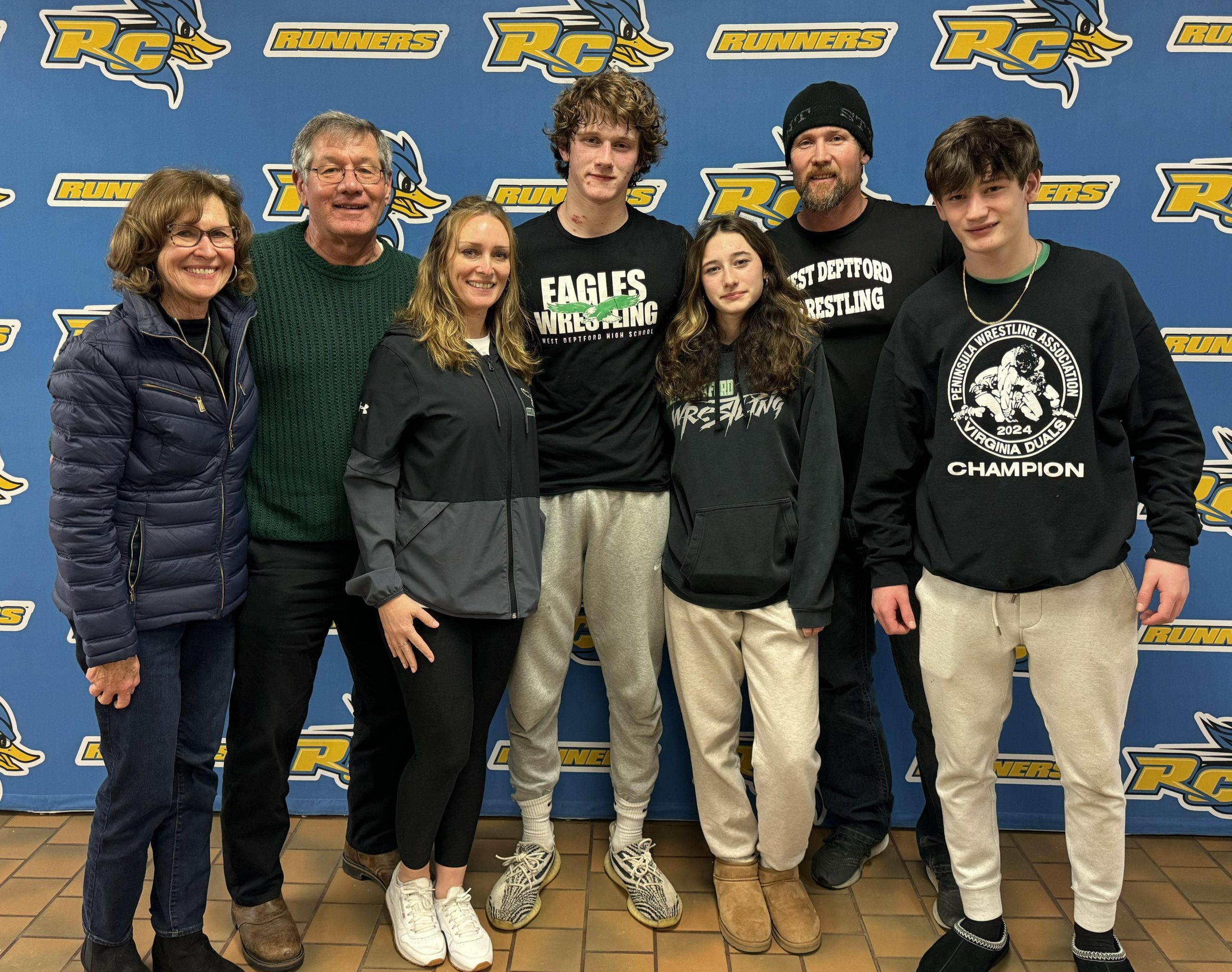
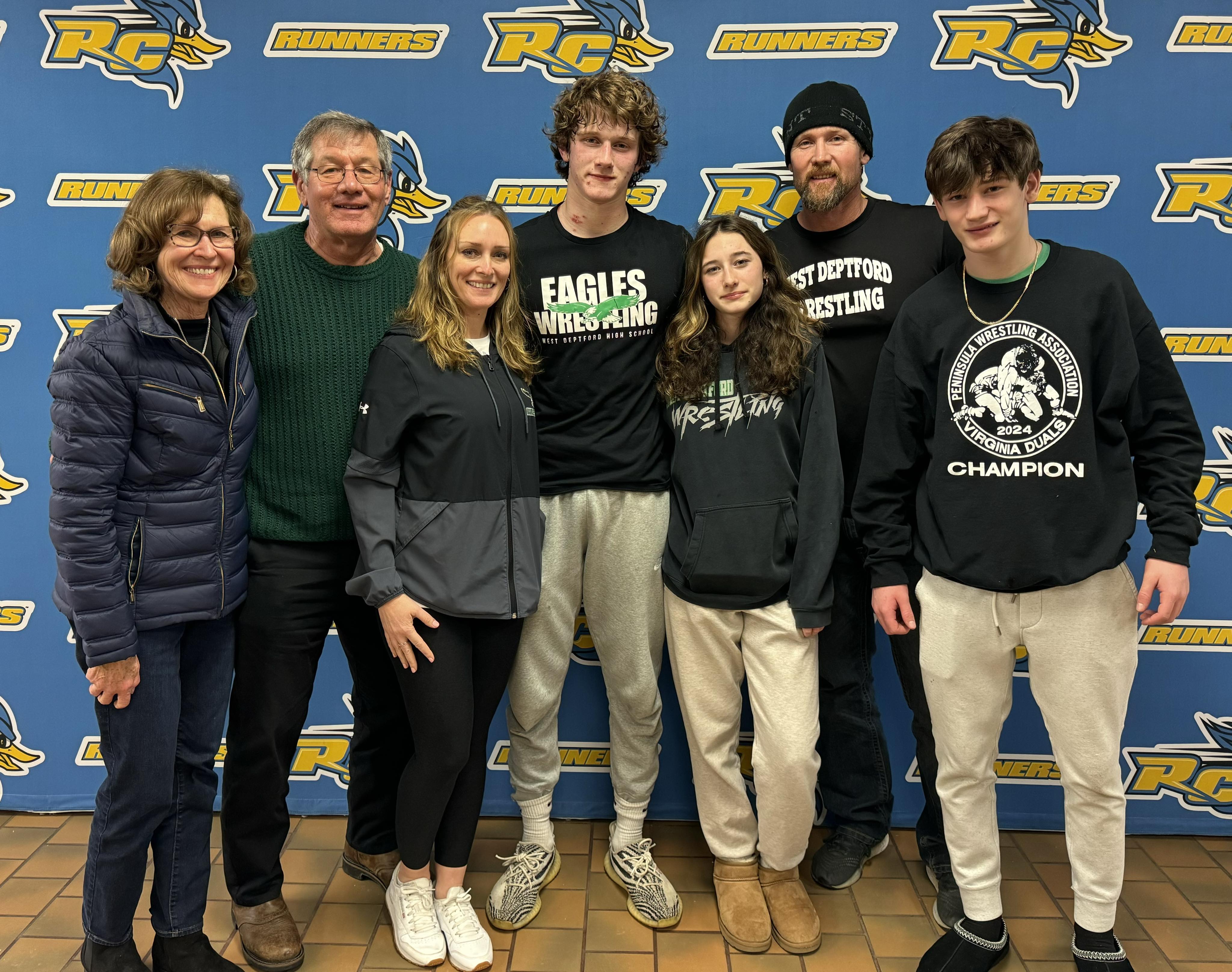

HANOVER, N.H. – Filling an important role that has a broad impact across all student-athletes, Lorna Harkins has been named the Corrigan Family Assistant Athletics Director for Leadership and Mental Performance, as announced by Dartmouth Athletics and Recreation on Wednesday. Harkins comes to Dartmouth from the San Diego Wave Futbol Club out of the National Women’s Soccer League where she played a major role in athletes’ mental performance and wellbeing.
“We are thrilled to welcome Lorna Harkins to the Dartmouth as a distinguished leadership and mental performance expert,” said Ian Connole, Senior Associate Athletics Director for Peak Performance. “With a proven track record working alongside elite athletes, and a comprehensive background in sport psychology, education and holistic development, Lorna is uniquely equipped to enhance the performance, resilience and well-being of our student-athletes, coaches and teams. Her ability to connect, understand and elevate others will undoubtedly make a positive impact on our community.”
“Dartmouth has a rare mix of tradition, excellence and curiosity,” said Harkins. “That deeply aligns with my own commitment to ambition, purpose and growth. I was drawn to the opportunity to be part of something meaningful and to contribute to a program that prioritizes both performance and the development of the whole person. Supporting student-athletes during such a pivotal time in their sport, academics and lives is a true privilege.”
Austin Driggers, Executive Associate Athletics Director for Peak Performance shared his perspective on the importance of Harkins’ position.
| WHAT THEY’RE SAYING |
| “Lorna is incredible at supporting athletes, whether they’re navigating transitions, facing tough moments or striving to become the best version of themselves. Her work helps build the mindset needed to handle high-pressure situations, overcome challenges and stay focused when it matters most. She understands the mental and emotional demands of performing under pressure and she leads with kindness and joy, creating a supportive environment where athletes can truly learn and grow!”
— Naomi Girma, Defender, Chelsea Women and U.S. Women’s National Team |
| “Working with Lorna helped me develop the mindset to push to the next level. She helped me have trust in myself that I could handle any obstacle and challenged me in ways I didn’t know I could be challenged to make progress. Her ability to simplify the mental side of the game and build trust makes her stand out. She helps you feel understood, more prepared and she genuinely cares. Our work together is something I’ll be forever grateful for.”
— Alessia Russo, Forward, Arsenal FC and England Women’s National Team |
| “Lorna’s work helps you evolve and grow to be your best. It positively changed my way of thinking, helped me balance everything professionally and personally, and I learned to be in the moment more than ever before. I performed better on the pitch with more confidence, and I also performed better in my life with more clarity and joy. I am so thankful for the time I got to know her and work with her.”
— Jackie Groenen, Midfielder, Paris Saint German (PSG) and Netherlands National Team |
| “Lorna understands the demands we face as players and people and how it connects to performance. She is approachable, grounded and someone you can genuinely trust. Her work helps you reset and move forward quickly which is essential for performing under pressure day in and day out. Having her in our environment elevated us individually and as a team. As a captain, having Lorna as a sounding board throughout the highs and lows of a season was massive. She consistently goes above and beyond to support your growth. Dartmouth student-athletes are incredibly lucky to have her!”
— Kailen Sheridan, Goalkeeper, San Diego Wave FC and Canadian Women’s National Team |
| “I’ve never seen someone in her role be so trusted and embraced across an entire program the way that Lorna is! She operates at an exceptionally high level in her role to make that happen, which allows her to truly support the human being behind the performance. She also understands what it means to lead, and what it means to be led. That makes her incredibly effective across a team. She redefined what a mental performance coach could be in our environment. Lorna brings a rare combination of credibility, care and clarity. She makes everyone around her better. She’ll be a real asset to Dartmouth.”
— Landon Donovan, former U.S. Men’s National Team and Head Coach |
| “In my two years working with Lorna, I saw firsthand the impact of her leadership. Dartmouth isn’t just gaining a highly skilled mental performance coach, but they’re also gaining someone who brings people together, fosters trust and raises the psychological awareness of an entire program. Lorna understands both the science of human behavior and the art of supporting high performers. Her system-wide approach to mental wellness and performance ensures that athletes, coaches and staff are prepared to show up as their best selves every day.”
— Dr. Brett Haskell, Director, Mental Health and Mental Performance, National Women’s Super League |
| “Lorna brings high levels of professionalism, perspective and innovation to her work. She has an exceptional ability to collaborate and connect across different areas of a team, supporting others navigating complex challenges in demanding situations. This is matched by her strategic understanding of how mental performance fits into the broader culture of high performance. She will no doubt bring the same excellence in her work to Dartmouth!”
— Jill Ellis, Chief Football Officer at FIFA |
“Thanks to the generosity of Fritz Corrigan ’64 and his family, the Assistant Athletics Director for Leadership and Mental Performance is an incredibly unique position in college athletics,” he said. “Lorna’s mental performance expertise, paired with a deep understanding of how to thrive in high performance environments, uniquely positions Dartmouth Peak Performance (DP2) to provide proactive mental training and leadership development for our varsity teams.”
Harkins assumes an important student-athlete facing role, impacting the entire athletics department.
“In addition to her impact on performance, Lorna’s role is vital to the primary prevention of mental health concerns for Dartmouth student-athletes,” said Dr. Mark Hiatt, DP2’s Director of Sport and Counseling Psychology. “This includes helping students develop psychological skills for resilience through the ups and downs of sport, managing the pressures of competition and academics, as well as fostering healthy team environments in which students can flourish. I am thrilled to have her as a teammate.”
Dartmouth Athletics supports the full spectrum of student-athlete needs — from mental health to mental performance — through two specialized service areas: Sport and Counseling Psychology, and Leadership and Mental Performance. By ensuring a foundation of mental health care is in place, this structure allows professionals like Connole and Harkins to focus their expertise on team and culture building, resilience and mental skills training through targeted support for individuals, groups and staff.
“After meeting the Dartmouth Peak Performance staff, I felt excited about the opportunity to work alongside other mental performance coaches, psychologists and dedicated professionals within a nationally-respected DP2 program,” said Harkins. “Throughout this process – meeting student-athletes, coaches and department leaders – I knew I wanted to be part of this community.
“I hope to contribute in a way that builds on the strong foundations already in place, supports others and helps student-athletes and teams be at their best.”
While with the San Diego Wave (2021–2024), Harkins built and delivered the club’s mental performance program in its expansion year. She established the structure and delivery of psychological services for athletes and sporting staff. Her work supported players through key performance moments, transitions and long-term development, while also contributing psychological expertise to a multidisciplinary performance staff.
Before her time in San Diego, Harkins led the creation of the mental performance and wellbeing system at Manchester United Women (2019–2021), spanning both the First Team, U21 Academy and Youth Academy teams. As the program’s founding Performance and Wellbeing Coach, her work became foundational to the team’s evolution and psychological approach during a period of rapid growth.
“Lorna is an incredibly skilled leadership and mental performance practitioner who emerged as the ideal fit for Dartmouth,” said Connole.
Harkins earned her master’s degree in Sport and Exercise Psychology from Manchester Metropolitan University, where her work focused on the mental and emotional demands of elite athletic environments. She also holds a postgraduate degree in Teaching, Physical Education and bachelor’s degree in Sport Science, where she began her career coaching and teaching young athletes. Her academic foundation is matched by a decade of applied experience across youth, education and professional sport systems.
Health
The protective role of competitive sports in reducing suicidality amongst youth athletes
1 Introduction Suicide is the second leading cause of death among American children aged 10 to 14 years (Health, 2024; Prevention, 2022) and the prevalence of mental health disorders and suicidality (i.e., risk of suicide, indicated by suicidal ideation, intent, and/or history of suicidal behavior) are increasing in our youth (Health, 2024). According to death certificate […]

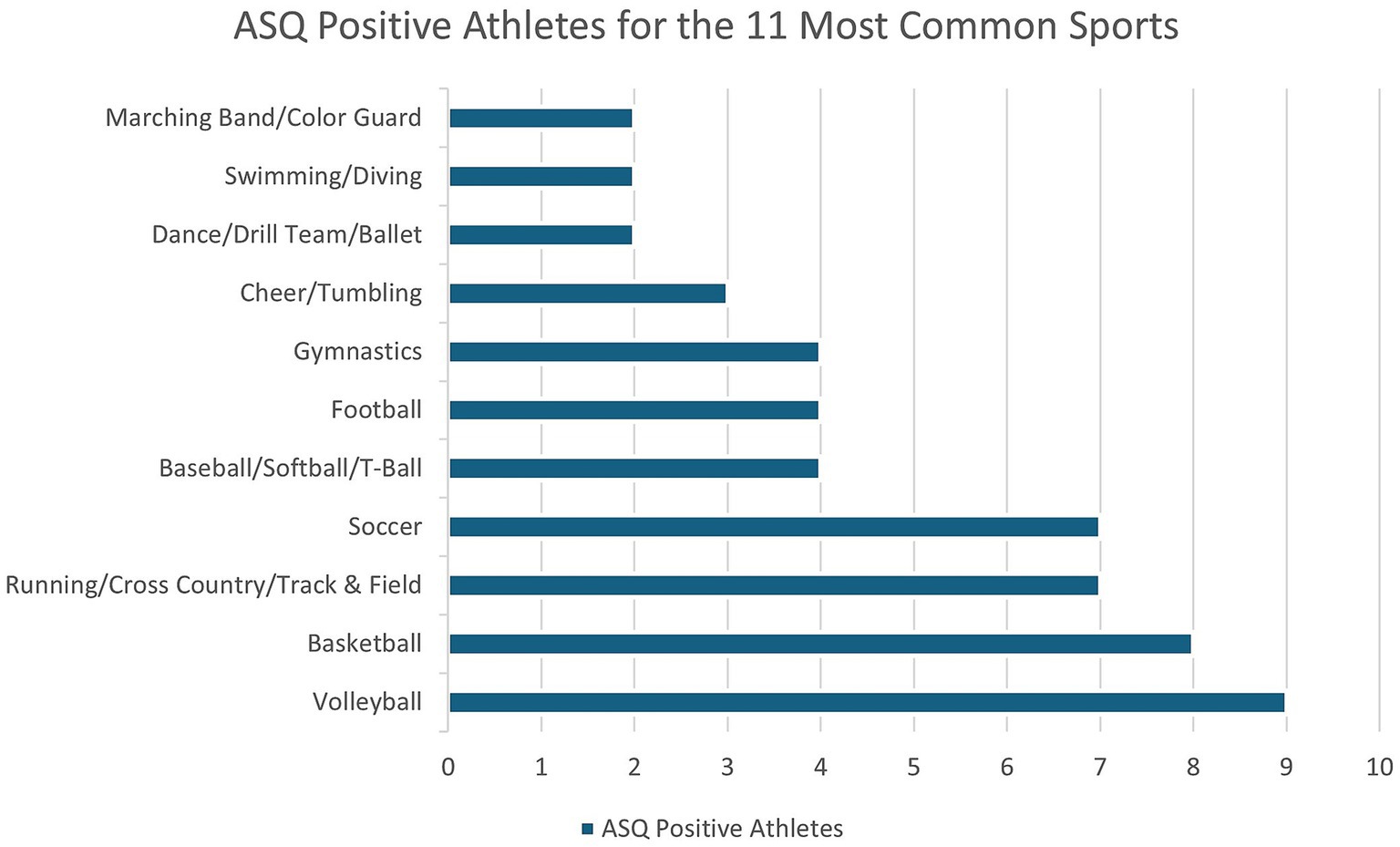
1 Introduction
Suicide is the second leading cause of death among American children aged 10 to 14 years (Health, 2024; Prevention, 2022) and the prevalence of mental health disorders and suicidality (i.e., risk of suicide, indicated by suicidal ideation, intent, and/or history of suicidal behavior) are increasing in our youth (Health, 2024). According to death certificate data, the suicide rate among youth aged 10 to 24 years rose from 6.8 to 10.7 per 100,000 between the years 2000 and 2018 (Curtin, 2020). Moreover, there has been a 31% increase in mental health-related emergency department visits since 2019 among American adolescents (Yard et al., 2021).
Early identification and treatment of individuals at risk for suicide is a primary suicide prevention strategy (Group, 2018), and understanding risk factors for youth suicide is a critical component of risk identification. Factors contributing to suicide risk are multifactorial and include individual risk factors (e.g., previous suicide attempt(s), current or historical experience of mental health symptoms, current or historical experience of abuse, substance misuse, physical illness, chronic pain, personality factors, and experience of stressful life events), relationship factors (e.g., experience of bullying, social isolation, family or peer conflict, and family history of suicide), and environmental and social factors (e.g., barriers to accessing health care, access to lethal means, stigma associated with seeking mental health care, and systemic trauma or marginalized experiences; Prevention, 2024a). Female sex has also been identified as a risk factor for mental health symptoms and suicidality (Prevention, 2024b; Roh et al., 2024). Supportive relationships with caregivers and feeling a sense of connection to family, friends, and one’s community are known protective factors against youth suicide (Prevention, 2024a).
Research in sports populations has demonstrated mixed evidence regarding the impact of sport participation on mental health. On the positive side, certain studies have identified that youth who play sports demonstrate lower rates of depression and anxiety symptoms, stress, and psychological difficulties (Eime et al., 2013; Hoffmann et al., 2022; Logan et al., 2019; Murray et al., 2021; Panza et al., 2020; Sabo et al., 2005), as well as report higher levels of emotional identification and regulation skills, higher quality of life, more positive social relationships and social skills, and increased self-esteem compared to non-sport participating youth (Eime et al., 2013; Fernandes et al., 2024; Hoffmann et al., 2022; Logan et al., 2019; Vella, 2019). Regarding suicidality specifically, several studies have identified benefits to physical activity and sports engagement for suicidal risk. One longitudinal study found that middle and high school sports participants demonstrated a decreased likelihood of suicidal ideation compared to non-athlete peers (Taliaferro et al., 2011). Sabo et al. found that high school athletic participation was associated with decreased likelihood of suicidal ideation, and reduced odds of planning a suicide attempt in females (Sabo et al., 2005). Similarly, Roh et al. found that higher participation frequency in physical activity was associated with more positive mental health outcomes, whereby the rate of suicidal behavior decreased as the frequency of over 60 min of physical activity and strength training increased (Roh et al., 2024).
Alternatively, studies have also demonstrated mental health risks associated with sport participation. Specifically, sport participation has been linked to increased stress, lower self-esteem, increased negative mood states, and disordered eating behaviors, as well as substance abuse, burnout, and exposure to maltreatment and abuse (DiFiori et al., 2014; He et al., 2018; Logan et al., 2019). Certain environmental and personal characteristics appear to moderate the impact of these risk factors, including coaching climate, sports culture (e.g., expectations for body type, hazing), parental expectations and influence, training volumes, scheduling demands, and personality types (Logan et al., 2019).
In addition to the environmental and personal characteristics impacting mental health, sport-specific variables (e.g., team versus individual sport and specialization level) also significantly influence the variability of mental health outcomes in youth athletes. Participation in youth team sports is associated with fewer anxiety and depressive symptoms, and improved overall psychosocial health in adulthood, compared to both non-sport and individual sport participants (Fernandes et al., 2024; Hoffmann et al., 2022; Kunitoki et al., 2023). Findings on the benefits of participation in individual sports are mixed. Whereas Fernandes et al. found higher levels of emotional functioning and regulation in youth individual sport participants compared to non-sport participants, the overall mental health and well-being benefits were below team sport participants (Fernandes et al., 2024). Hoffman et al. did not find that individual sport participation was protective for mental health and psychosocial functioning (Hoffmann et al., 2022). Moreover, Hoffmann et al. (2022) found that athletes participating exclusively in individual sports tend to exhibit an increased prevalence of mental health problems when compared to team sport and non-sport youth, specifically with increased anxiety and depression, withdrawal, social problems, and attentional problems.
Sport specialization and participation in sports at higher levels have become increasingly popular in youth sports and have also demonstrated an increased risk for poorer psychosocial functioning and mental health. Specifically, Watson et al. found that female youth athletes who specialized in a single sport reported lower ratings of quality of life and sleep, both of which are often associated with poorer mental health and well-being (Watson et al., 2021). Specialized athletes are also at greater risk for injury, burn-out, social isolation, and mental health concerns due to the high physical, psychological, and social demands of sport specialization (Brenner et al., 2019; Weber et al., 2018; Wylleman et al., 2004).
Given the variability evident in the existing literature regarding the role of sport participation on youth mental health, this study aims to expand our understanding of sport-specific protective and risk factors associated with youth mental health concerns, especially related to suicidality. Bolstering our understanding of the mental health challenges within various youth sports populations given their unique experiences (e.g., individual versus team, specialization status, level of competition), will allow for more effective early identification and intervention. To our knowledge, the prevalence of suicidality between sport participation involvement and types has not been studied in youth. Therefore, the purpose of this study is to expand the understanding of suicidality in pediatric sports medicine and identify youth sport populations at increased risk for suicide. Given current literature on sport participation and mental health, it was hypothesized that females would demonstrate an overall higher risk prevalence for suicidality, in both sport and non-sport participating youth, and that individuals participating in youth sports would demonstrate an overall lower risk prevalence for suicidality relative to youth who do not participate in sports. Within youth athletes, we hypothesized that athletes participating in team sports would demonstrate a lower prevalence of suicidality compared to those in individual sports. Lastly, we hypothesized that highly specialized athletes would demonstrate an increased prevalence of suicidality compared to athletes at lower levels of specialization.
2 Materials and methods
This study was approved by the local Institutional Review Board (IRB; #STU-2020-1374). Informed consent was not required and was waived by the IRB as this study was a retrospective chart review and did not require additional procedures or interactions with patients.
2.1 Participants
A consecutive review of patients who had been formally diagnosed with a pediatric orthopedic and/or sports medicine condition and were seen in the institution’s sports medicine clinics between September 1, 2018 and August 4, 2022 was conducted. Participants were included if they were between the ages of 10–18 years and had completed an Ask Suicide-Screening Questionnaire (ASQ). Patients who did not complete the ASQ were excluded from the study. Completion of all other questionnaires, forms, or assessments used in this study did not affect the patient’s inclusion in the study.
2.2 Procedure
Patient data was obtained by conducting a diagnosis-based query with the hospital’s Health Information Management and the Billing Department for patients treated within the hospital’s sports medicine clinics who completed the ASQ. Data collected from the electronic medical record (EMR) included demographic, clinical, and sport-related variables, as well as patient responses to the self-report ASQ. Upon presentation to the sports medicine clinic, patients were comprehensively assessed through physical examination and sport-specific assessments, as well as questionnaires assessing their overall mental health (including anxiety, and suicidality), pain, daily functioning, and socioeconomic factors. All patients who present to the sports medicine facility over the age of 10 are administered a suicide screener every 6 months consist with Joint Commission on Accreditation of Healthcare Organizations’ National Patient Safety Goal for suicide prevention in health care settings. If patients endorse positive suicidality on any of the screener questions, they are evaluated by a licensed clinical social worker for a brief suicide safety assessment and given recommendations for further care, if indicated.
Demographic variables collected included: age at presentation, sex, race, ethnicity, insurance status, and school grade at presentation. Clinical variables collected included: visit provider (non-operative, operative, sports neurologist), visit type, reason for visit (body part and type of complaint), date of injury, and primary sports medicine diagnosis at conclusion of the visit. Sport-related variables were collected, which included sport participation (athlete or non-athlete), competition level (recreational, school, club/select, travel, or other), athlete type (single- or multi-sport athlete), sport participation type (individual, team, or both individual and team sport), primary sport, and additional sports played.
2.3 Measures
The Ask Suicide-Screening Questionnaire (ASQ; Horowitz et al., 2012) is a validated suicide risk screening tool for medical patients ages 8 years and older. It consists of four “Yes” or “No” questions that are used to screen for current and historical suicidal ideation and behavior. The four questions assess current thoughts of being better off dead, current wishes to die, current suicidal ideation, and any past suicide attempts. If the patient answers “Yes” to any of the four questions, or refuses to answer, then they are considered a positive screen for suicidality. If the patient answers “Yes” to any of the first four questions, a fifth question is asked to assess the immediacy of suicide risk.
2.4 Statistical analysis
Statistical analysis was conducted using R software (version 4.1.3, R Core Team, 2021) and SPSS (version 29). Descriptive statistics including frequencies, means, and standard deviations were calculated across all variables. The Shapiro–Wilk test was conducted to assess the normality of the variables. Depending on the results, either T-tests or Mann–Whitney U tests were used to evaluate statistically significant differences in continuous variables, including age and days since injury, between groups (e.g., athletes vs. non-athletes and ASQ positive vs. ASQ negative). The Chi-square or Fisher’s Exact test was used to compare categorical variables with ASQ responses amongst the entire population, athletes, and non-athletes. Categorical variables included sex, race, ethnicity, school level, athlete type (single/multi-sport), competition level, and chronicity of injury (acute/chronic). Logistic regression was used to identify predictors of a positive ASQ response, examining factors such as sex, anxiety scores, and competition level to determine their likelihood of association with suicidal ideation amongst the general population, athletes, and non-athletes. Backward selection was used to refine the logistic regression to include only the significant predictors. Statistical significance was concluded when p < 0.05.
3 Results
3.1 Descriptive statistics
A total of 8,599 patients between the ages of 10 and 18 (M = 12 ± 2.13) years were included for analysis. Patients were reflective of the study region in sex, race, and ethnicity (Table 1). A total of 5,714 patients (66.4%) identified as athletes, with the remainder identifying as non-athletes.

Table 1. Patient demographics and sport characteristics.
Patients primarily sought medical treatment for knee-related issues (42.54%), followed by ankle issues (11.08%). Of the total population, 54.23% reported an identifiable injury as the reason for seeking medical treatment, 42.92% reported pain, and only 1.67% reported both pain and injury as the reason for seeking medical treatment. The most frequently reported physician-assigned medical diagnoses were knee related, with 2,294 patients (26.7%) diagnosed with a type of knee injury and 855 patients (9.94%) diagnosed with knee pain. Most patients (67.8%) reported having an acute problem lasting 90 days or less (Table 2).
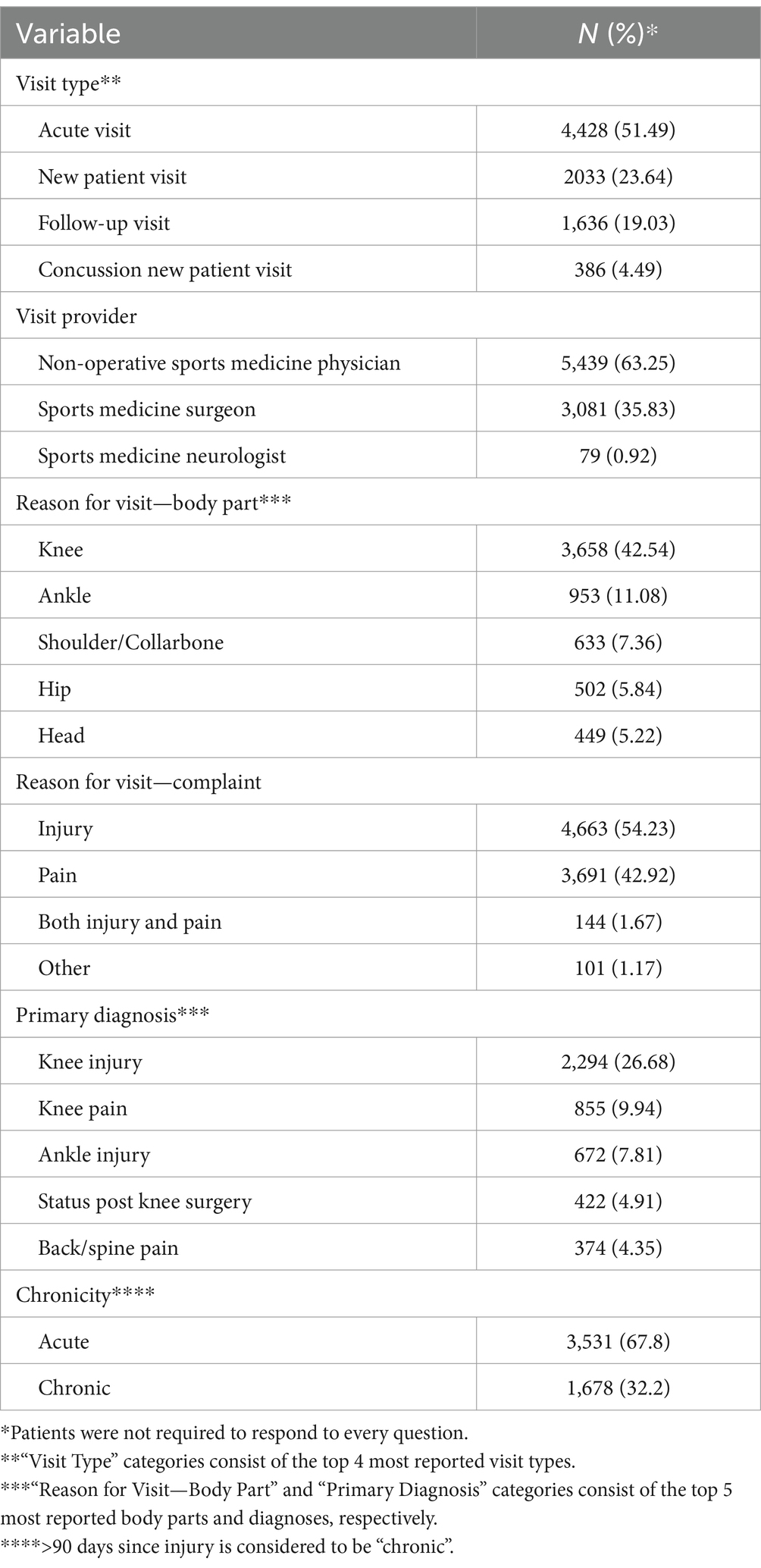
Table 2. Patient clinical variables.
3.2 Athletic participation
When evaluating patients who identified as athletes, soccer was the most frequently reported primary sport (19.3%). Nearly half of all athletes (47.4%) reported they compete at a club, select, or travel level (Table 1).
When comparing athletes to non-athletes, significant differences between the groups were identified (Table 3). Differences were identified between athletes and non-athletes in age (13.8 ± 2.07 vs. 14.2 ± 2.28 years, p < 0.0001), sex (51.5% male vs. 61.1% male, p < 0.0001), ethnicity (77.3% Non-Hispanic vs. 65.5% Non-Hispanic, p < 0.0001), and insurance provider (77.4% commercial insurance vs. 52.3% commercial insurance, p < 0.0001). Athletes were more likely to be seen by a non-operative sports provider (75.5% vs. 65.8%; p < 0.0001). No other differences were identified between the athlete and non-athlete subgroups.
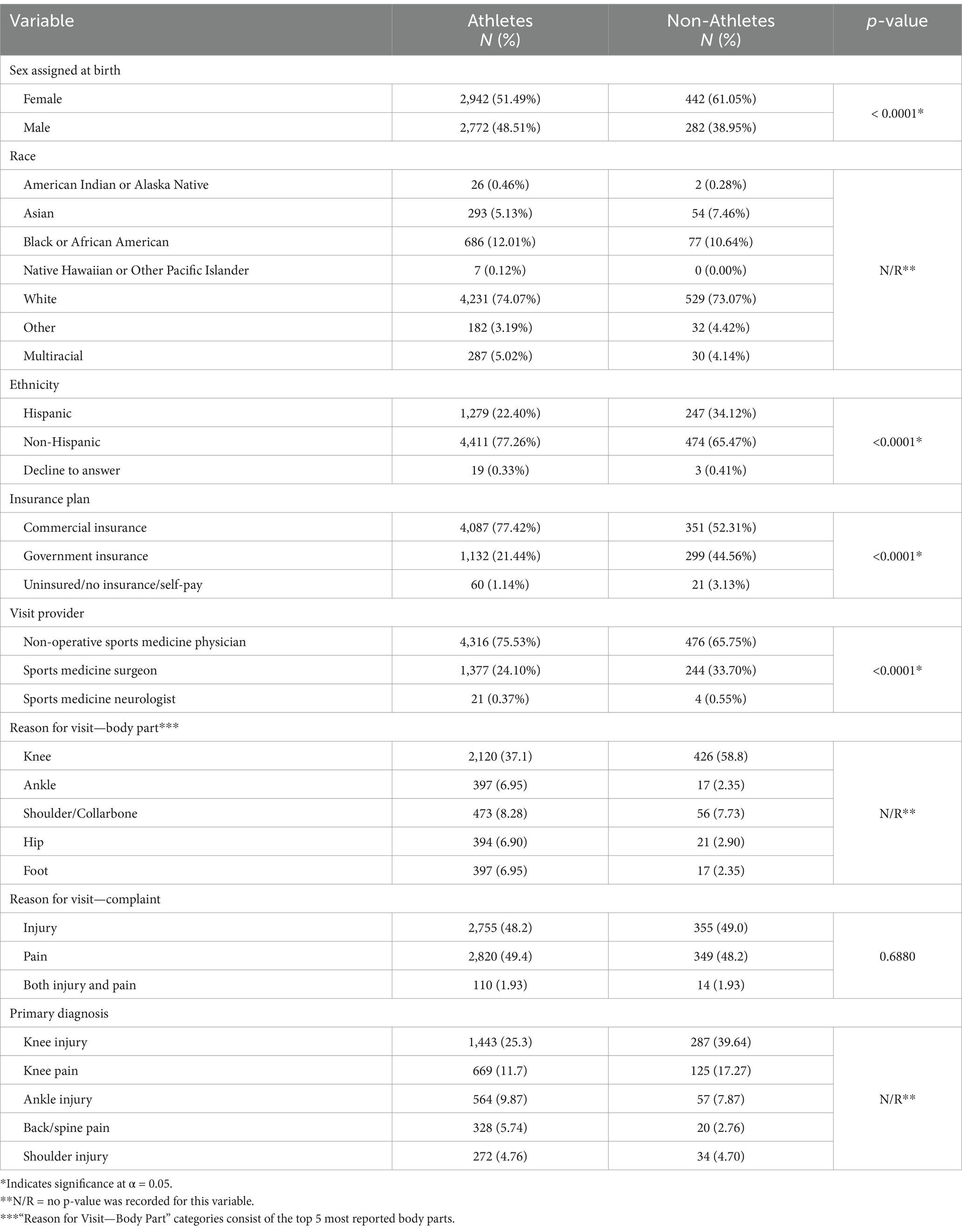
Table 3. Comparison of demographics and clinical variables in athletes vs. non-athletes.
3.3 Suicidal ideation prevalence
Of the 8,599 patients who completed the ASQ, 117 (1.36%) patients screened positive for suicide risk. No significant differences were found in race or ethnicity distribution between ASQ-positive and ASQ-negative groups. Regarding insurance status, there was a significant difference between ASQ-positive and ASQ-negative groups (p = 0.0262), with a higher percentage of ASQ-positive patients (35.19%) covered by government insurance compared to ASQ-negative patients (24.02%).
No significant differences were found in primary diagnosis, reason for visit—body part, or complaint type between ASQ-positive and ASQ-negative groups. Significant differences in ASQ response were observed across visit providers. Among ASQ-positive patients, the majority were seen by non-operative providers (69.23%), followed by operative providers (26.50%) and sports neurology providers (4.27%; p = 0.0016).
3.4 Sex and suicidal ideation
Considering first the entire sample of athletes and non-athletes, a significantly higher percentage of female patients reported a positive ASQ compared to male patients (70.94% vs. 29.06% respectively, p = 0.0115; OR = 0.47, CI 95% [0.21, 0.99]). Unlike the findings from the overall population analysis, sex was not a significant predictor of suicidality within the athlete cohort (p = 0.0561). Similarly, amongst nonathletes, sex was not a significant predictor of suicidality (p = 0.0507).
3.5 Sport participation and suicidal ideation
When comparing ASQ responses between athletes and non-athletes, a significantly higher proportion of non-athletes screened positive for suicidal ideation (4.01%, n = 29) compared to athletes (1.05%, n = 60; p < 0.0001). No significant difference was found in suicidal ideation rates between athletes who participated in individual sports compared to those who participated in team sports (p = 0.5628). No other significant differences were found between groups amongst either demographic or sports variables, including the athlete type (multi- vs. single-sport athlete; Table 4).
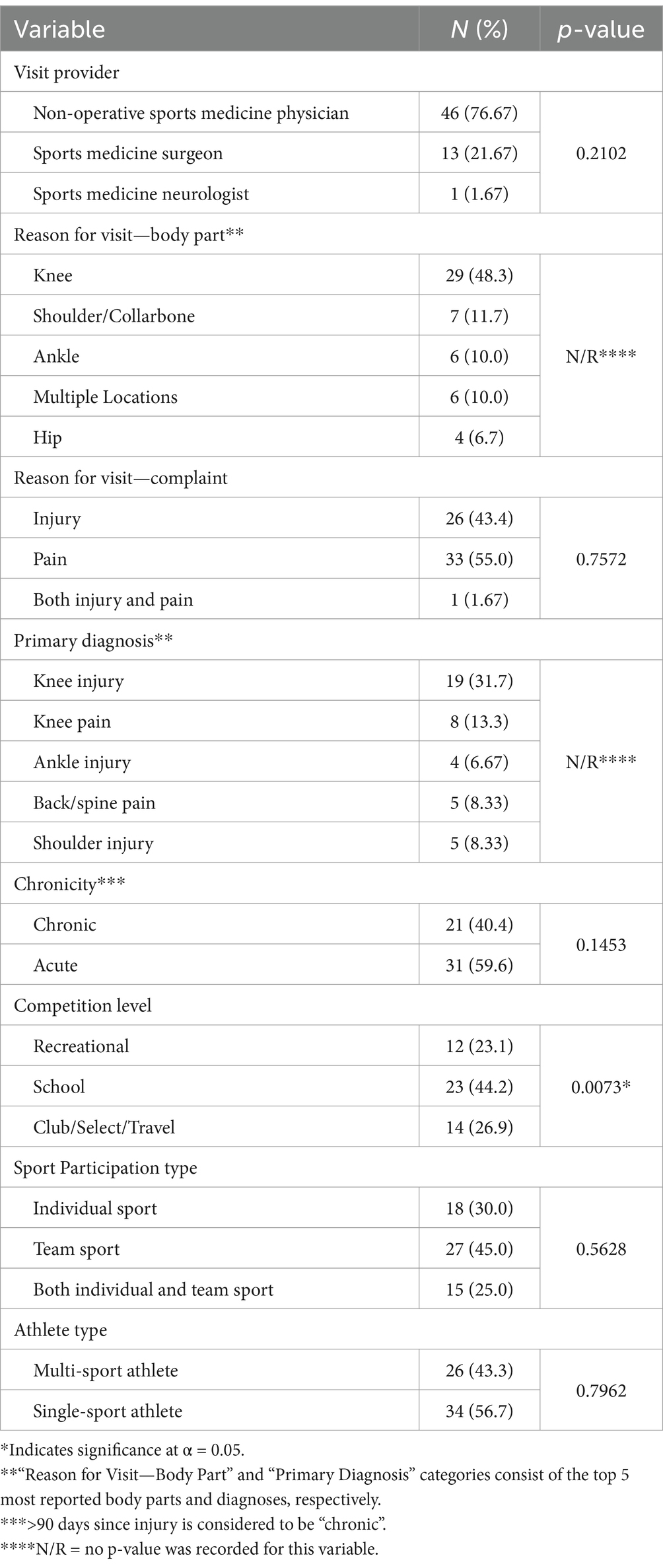
Table 4. Clinical variables and sports characteristics in ASQ positive athletes.
Among youth athletes with positive ASQ responses, volleyball and basketball were the most common primary sports, representing 15 and 13.3%, respectively (Figure 1). Marching Band/Color Guard had the highest proportion of ASQ positive responses (2 of 29 patients, 6.9%), followed by Running/Cross Country/Track and Field (7 of 301 patients, 2.3%), Golf (1 of 44 patients, 2.3%), and Volleyball (9 of 404 patients, 2.2%). Athlete competition level was significantly associated with ASQ outcomes (p = 0.0131). Post-hoc analyses comparing recreational and school athletes to club, select, and travel athletes revealed a significant difference in ASQ positive responses (p = 0.0029). Athletes participating in lower levels of competition (recreational or school) were more likely to screen ASQ positive compared to those participating in high levels of competition (club, select, travel; OR = 2.68, 95% CI [1.25, 6.40], p = 0.0162). The prevalence was highest in recreation (2.1%), followed by the school (1.4%) and club/select/travel level (0.6%).

Figure 1. Ask suicide-screening questionnaire (ASQ) positive scoring athletes by primary sport for the 11 most common sports.
4 Discussion
Outpatient medical clinics are increasingly becoming critical settings for regular screening for suicidality, as research shows that most individuals who die by suicide have seen a healthcare provider in the weeks or months prior (Ahmedani et al., 2014). Universal screening, which is a more comprehensive strategy than “targeted screening,” ensures that all youth, regardless of their presenting health issues, are assessed for suicide risk, reducing the chance that at-risk individuals may go unnoticed (Pediatrics, 2023). This study aimed to contribute to the ongoing discussion of mental health in pediatric patients diagnosed with sports medicine-related orthopedic conditions, with a focus on identifying the prevalence of suicidality. The primary goals were to investigate the prevalence of suicidality in this population and to discern if the prevalence varied based on specific diagnostic factors, demographic variables, or sport participation. The main findings indicate that sex assigned at birth and competition level were strong predictors of suicidality amongst pediatric patients seeking treatment in the sports medicine clinic.
The results of this study suggest that sex is a significant predictor of suicidality in the overall population; however, amongst athletes, sex is no longer a significant predictor of suicidality. Females were significantly more likely to screen positive for suicidal ideation than males, but in the subgroup of athletes, this difference disappeared, indicating that factors other than sex may be affecting mental health. Current literature supports these findings, that females are significantly more likely to report suicidal ideation than males (Miranda-Mendizabal et al., 2019; Zhang et al., 2019). Although research has shown that sports can serve as a protective factor against suicidal ideation among adolescents (Babiss and Gangwisch, 2009; Huo et al., 2024; Zuckerman et al., 2021), evidence on how gender differences affect the protective role of sports remains limited. Our findings suggest that athletic participation might play a role in mitigating some of the sex-related risks of suicidal ideation. These findings highlight the complexity of mental health in pediatric populations, showing that factors like sex and sport participation interact in ways that require a detailed and careful approach to care.
Competition level emerged as a significant predictor of suicidality, with lower rates observed among youth participating in club/select/travel levels compared to those engaged in school or recreational levels. These findings suggest that higher levels of competition in sports may act as a protective factor against suicidality. Specifically, a trend was observed among athletes: 2.1% of recreational athletes, 1.4% of school-level athletes, and only 0.6% of club/select/travel athletes screened positive on the ASQ, further indicating that the risk of suicidal ideation decreases as the level of competition increases.
However, there is conflicting evidence regarding these findings. Some studies highlight the negative effects of sports on young athletes, with higher competition levels being associated with increased stress and pressure, potentially contributing to anxiety and depression (Johnson and Waicus, 2015; Neal et al., 2015). For instance, in a study of elite Canadian swimmers, 68% of the surveyed athletes met the criteria for a major depressive episode, with females being particularly at risk (Yang et al., 2007). Moreover, the risk of injury in sports can have a serious negative impact on athletes’ identities, which tend to be more strongly tied to their athletic roles at higher competition levels (Choudhury et al., 2024). According to a study conducted by the NCAA, 33% of injured athletes reported high levels of depressive symptoms compared to 27% of non-injured athletes (Brewer and Petrie, 1995).
While competitive sports do present certain risks, many argue that the benefits often outweigh these concerns. Choudhury et al. (2024) found that athletes participating in higher competition levels, such as club or select teams, exhibited stronger overall athletic identity (the degree to which an individual identifies with the role of being an athlete), social identity (the athletic identity component focused on the personal connection an individual has to the athlete role), and negative affectivity (the athletic identity component focused on the emotional impact on an individual should an unwanted or negative sporting outcome occur) compared to those in lower competition levels, like recreational or school teams. The increased dedication and training demands at higher competition levels can lead to a more robust athletic identity, particularly in social and emotional contexts. This strengthened athletic identity does not necessarily diminish other aspects of self-identity. Athletes may continue to maintain a diversified self-identity, which can be crucial in protecting their sense of self during periods of injury or setback in sports.
Adolescents who perceive themselves as capable athletes may experience enhanced self-worth, serving as a protective factor against mental health concerns. Additionally, participation in team sports fosters strong relationships with teammates, providing a sense of belonging and reducing feelings of loneliness—both of which are commonly associated with mental health challenges. The sense of belonging, discipline, and support networks often found in more competitive sports environments may contribute to improved mental health outcomes. This underscores the potential benefits of encouraging youth participation in organized, competitive sports, particularly for those at risk for mental health issues.
The limitations of this study include the small sample size of those with a positive ASQ, which may have reduced the statistical power to detect significant differences or interactions between other variables. Additionally, the cohort’s generalizability is limited, as it is not fully representative of the broader orthopedic population or the general population; the study focused on patients presenting at a sports medicine clinic. While not all patients who present in the sports medicine clinic identify as athletes, it is expected that most are involved in some form of sport or athletic activity. Another limitation is the reliance on self-reported measures for suicidality and sports participation, which could introduce bias, as patients might underreport or overreport their symptoms or involvement due to social desirability or recall bias. A limitation of the self-reported measures was the inability to quantify athletes’ time spent in each sport when participating in multiple disciplines. Consequently, we analyzed data based on participation in individual, team, or both types of sports, which may lead to an inaccurate reflection of an athlete’s dominant athletic environment who is primarily engaged in one sport type but occasionally participates in the other. Future research could prioritize collecting data on time allocated across different sporting activities. Furthermore, since only the ASQ was required for inclusion in the study, incomplete or missing data from other forms or tests could affect the overall data completeness.
The findings from this study identify the importance of considering both psychological factors and sport participation in assessing suicidality among pediatric sports medicine patients. Specifically, the protective effect of higher competition levels in sports suggests that engagement in club/select/travel-level sports might play a role in reducing the risk of suicidal ideation. Future research should continue to explore the interplay between mental health, sport participation, and suicidality, particularly across different competition levels and in more diverse orthopedic populations. Such studies could inform targeted interventions and rehabilitation strategies aimed at improving both the psychological well-being and the athletic involvement of adolescents recovering from orthopedic injuries or ailments.
Data availability statement
The raw data supporting the conclusions of this article will be made available by the authors, without undue reservation.
Ethics statement
The studies involving humans were approved by The University of Texas Southwestern IRB. The studies were conducted in accordance with the local legislation and institutional requirements. The ethics committee/institutional review board waived the requirement of written informed consent for participation from the participants or the participants’ legal guardians/next of kin because this study was a retrospective chart review and did not require additional procedures or interactions with patients.
Author contributions
PS: Conceptualization, Methodology, Visualization, Writing – original draft, Writing – review & editing. VC: Conceptualization, Visualization, Writing – original draft, Writing – review & editing. WH: Conceptualization, Formal analysis, Investigation, Methodology, Project administration, Writing – review & editing. ES: Conceptualization, Methodology, Supervision, Visualization, Writing – original draft, Writing – review & editing.
Funding
The author(s) declare that no financial support was received for the research and/or publication of this article.
Acknowledgments
The authors would like to acknowledge Shane M. Miller for his assistance with the conceptualization and development of this project.
Conflict of interest
The authors declare that the research was conducted in the absence of any commercial or financial relationships that could be construed as a potential conflict of interest.
Generative AI statement
The author(s) declare that no Gen AI was used in the creation of this manuscript.
Publisher’s note
All claims expressed in this article are solely those of the authors and do not necessarily represent those of their affiliated organizations, or those of the publisher, the editors and the reviewers. Any product that may be evaluated in this article, or claim that may be made by its manufacturer, is not guaranteed or endorsed by the publisher.
References
Ahmedani, B. K., Simon, G. E., Stewart, C., Beck, A., Waitzfelder, B. E., Rossom, R., et al. (2014). Health care contacts in the year before suicide death. J. Gen. Intern. Med. 29, 870–877. doi: 10.1007/s11606-014-2767-3
Babiss, L. A., and Gangwisch, J. E. (2009). Sports participation as a protective factor against depression and suicidal ideation in adolescents as mediated by self-esteem and social support. J. Dev. Behav. Pediatr. 30, 376–384. doi: 10.1097/DBP.0b013e3181b33659
Brenner, J. S., LaBotz, M., Sugimoto, D., and Stracciolini, A. (2019). The psychosocial implications of sport specialization in pediatric athletes. J. Athl. Train. 54, 1021–1029. doi: 10.4085/1062-6050-394-18
Brewer, B. W., and Petrie, T. A. (1995). A comparison between injured and uninjured football players on selected psychosocial variables. Acad. Athl. J. 10, 11–18.
Choudhury, M. M., Erdman, A. L., Stapleton, E., Gale, E., and Ulman, S. (2024). Identifying links between athletic identity and risk factors related to youth sport participation. Front. Psychol. 15:1362614. doi: 10.3389/fpsyg.2024.1362614
DiFiori, J. P., Benjamin, H. J., Brenner, J., Gregory, A., Jayanthi, N., Landry, G. L., et al. (2014). Overuse injuries and burnout in youth sports: a position statement from the American Medical Society for Sports Medicine. Clin. J. Sport Med. 24, 3–20. doi: 10.1097/JSM.0000000000000060
Eime, R. M., Young, J. A., Harvey, J. T., Charity, M. J., and Payne, W. R. (2013). A systematic review of the psychological and social benefits of participation in sport for children and adolescents: informing development of a conceptual model of health through sport. Int. J. Behav. Nutr. Phys. Act. 10, 98–21. doi: 10.1186/1479-5868-10-98
Fernandes, H. M., Costa, H., Esteves, P., Machado-Rodrigues, A. M., and Fonseca, T. (2024). Direct and indirect effects of youth sports participation on emotional intelligence, self-esteem, and life satisfaction. Sports 12:155. doi: 10.3390/sports12060155
He, J.-P., Paksarian, D., and Merikangas, K. R. (2018). Physical activity and mental disorder among adolescents in the United States. J. Adolesc. Health 63, 628–635. doi: 10.1016/j.jadohealth.2018.05.030
Hoffmann, M. D., Barnes, J. D., Tremblay, M. S., and Guerrero, M. D. (2022). Associations between organized sport participation and mental health difficulties: data from over 11,000 US children and adolescents. PLoS One 17:e0268583. doi: 10.1371/journal.pone.0268583
Horowitz, L. M., Bridge, J. A., Teach, S. J., Ballard, E., Klima, J., Rosenstein, D. L., et al. (2012). Ask suicide-screening questions (ASQ): a brief instrument for the pediatric emergency department. Arch. Pediatr. Adolesc. Med. 166, 1170–1176. doi: 10.1001/archpediatrics.2012.1276
Huo, M., Yang, Z., Yang, L., and Chen, S. (2024). Can sports participation be a protective factor against suicide-related outcomes in adolescents: a systematic review. Front. Psychol. 15:1341795. doi: 10.3389/fpsyg.2024.1341795
Kunitoki, K., Hughes, D., Elyounssi, S., Hopkinson, C. E., Bazer, O. M., Eryilmaz, H., et al. (2023). Youth team sports participation associates with reduced dimensional psychopathology through interaction with biological risk factors. Biol. Psychiatry Glob. Open Sci. 3, 875–883. doi: 10.1016/j.bpsgos.2023.02.001
Logan, K., Cuff, S., LaBella, C. R., Brooks, M. A., Canty, G., Diamond, A. B., et al. (2019). Organized sports for children, preadolescents, and adolescents. Pediatrics 143:997. doi: 10.1542/peds.2019-0997
Miranda-Mendizabal, A., Castellví, P., Parés-Badell, O., Alayo, I., Almenara, J., Alonso, I., et al. (2019). Gender differences in suicidal behavior in adolescents and young adults: systematic review and meta-analysis of longitudinal studies. Int. J. Public Health 64, 265–283. doi: 10.1007/s00038-018-1196-1
Murray, R. M., Sabiston, C. M., Doré, I., Bélanger, M., and O’Loughlin, J. L. (2021). Association between pattern of team sport participation from adolescence to young adulthood and mental health. Scand. J. Med. Sci. Sports 31, 1481–1488. doi: 10.1111/sms.13957
Neal, T. L., Diamond, A. B., Goldman, S., Liedtka, K. D., Mathis, K., Morse, E. D., et al. (2015). Interassociation recommendations for developing a plan to recognize and refer student-athletes with psychological concerns at the secondary school level: a consensus statement. J. Athl. Train. 50, 231–249. doi: 10.4085/1062-6050-50.3.03
Panza, M. J., Graupensperger, S., Agans, J. P., Doré, I., Vella, S. A., and Evans, M. B. (2020). Adolescent sport participation and symptoms of anxiety and depression: a systematic review and meta-analysis. J. Sport Exerc. Psychol. 42, 201–218. doi: 10.1123/jsep.2019-0235
Prevention, C. F. D. C. A. (2024a). Risk and Protective Factors for Suicide.
Roh, S., Mun, W., and Kim, G. (2024). Associations between physical activity, mental health, and suicidal behavior in Korean adolescents: based on data from 18th Korea youth risk behavior web-based survey (2022). Behav. Sci. 14:160. doi: 10.3390/bs14030160
Sabo, D., Miller, K. E., Melnick, M. J., Farrell, M. P., and Barnes, G. M. (2005). High school athletic participation and adolescent suicide: a nationwide US study. Int. Rev. Sociol. Sport 40, 5–23. doi: 10.1177/1012690205052160
Taliaferro, L. A., Eisenberg, M. E., Johnson, K. E., Nelson, T. F., and Neumark-Sztainer, D. (2011). Sport participation during adolescence and suicide ideation and attempts. Int. J. Adolesc. Med. Health 23, 3–10. doi: 10.1515/ijamh.2011.002
Watson, A., McGuine, T., Lang, P., Post, E., Biese, K., Kliethermes, S., et al. (2021). The relationships between sport specialization, sleep, and quality of life in female youth volleyball athletes. Sports Health 14, 237–245. doi: 10.1177/19417381211014867
Weber, S., Puta, C., Lesinski, M., Gabriel, B., Steidten, T., Bär, K.-J., et al. (2018). Symptoms of anxiety and depression in young athletes using the hospital anxiety and depression scale. Front. Physiol. 9:182. doi: 10.3389/fphys.2018.00182
Wylleman, P., Alfermann, D., and Lavallee, D. (2004). Career transitions in sport: european perspectives. Psychol. Sport Exerc. 5, 7–20. doi: 10.1016/S1469-0292(02)00049-3
Yang, J., Peek-Asa, C., Corlette, J. D., Cheng, G., Foster, D. T., and Albright, J. (2007). Prevalence of and risk factors associated with symptoms of depression in competitive collegiate student athletes. Clin. J. Sport Med. 17, 481–487. doi: 10.1097/JSM.0b013e31815aed6b
Yard, E., Radhakrishnan, L., Ballesteros, M. F., Sheppard, M., Gates, A., Stein, Z., et al. (2021). Emergency department visits for suspected suicide attempts among persons aged 12–25 years before and during the COVID-19 pandemic—United States, January 2019–May 2021. MMWR Morb. Mortal Wkly. Rep. 70:888. doi: 10.15585/mmwr.mm7024e1
Zhang, Y. Y., Lei, Y. T., Song, Y., Lu, R. R., Duan, J. L., and Prochaska, J. J. (2019). Gender differences in suicidal ideation and health-risk behaviors among high school students in Beijing, China. J. Glob. Health 9:010604. doi: 10.7189/jogh.09.010604
Zuckerman, S. L., Tang, A. R., Richard, K. E., Grisham, C. J., Kuhn, A. W., Bonfield, C. M., et al. (2021). The behavioral, psychological, and social impacts of team sports: a systematic review and meta-analysis. Phys. Sportsmed. 49, 246–261. doi: 10.1080/00913847.2020.1850152
Health
Lima youth music program gives students hands
LIMA, OH (WLIO) – A Lima youth music program gives students hands-on studio and live show experience. “Mentoring with Music” led by Stedic Music’s Jason Henderson takes kids ages 10-19 on an eight-week musical journey in discovering new talents, while focusing on personal development and mental health. Through the sounds, participants will have the chance to […]


LIMA, OH (WLIO) – A Lima youth music program gives students hands-on studio and live show experience.
“Mentoring with Music” led by Stedic Music’s Jason Henderson takes kids ages 10-19 on an eight-week musical journey in discovering new talents, while focusing on personal development and mental health. Through the sounds, participants will have the chance to hit the road, featuring stops at music mega store Sweetwater in Fort Wayne, the Rock n’ Roll Hall of Fame, and the Motown Museum in Detroit.

At the conclusion of the program, each student will have the opportunity to display what they have learned at graduation, with the possibility of earning a full-ride scholarship to music school.
“I myself, am a musician. I’ve been doing this for a long time, and I always see a lot of kids in the audience. Kids come up to me after the shows and want to know, how can I do that? And I want to learn that, and how can I learn how to do this? My goal now is to give back to the kids and let them learn what I’ve learned, and let them learn how to do music, auto engineering, graphics, video, mixing and how to do artist development. Also, we’re doing live instruments too,” said Henderson, CEO of Mentoring with Music.
On June 14th, students will a have a hand in the live music show production at the Lima Juneteeth Celebration. For more information, you can visit their Facebook page. Mentoring with Music is looking for Business and sponsorship partners. For business inquiries: contact (419) 236-6782
Health
Track meet officials strip gold medal from student athlete because of her victory celebration
SALINAS, Calif. (Gray News) – A teen track star in California returned home empty-handed after the state championship’s organizers stripped her of her gold medal. According to KSBW, officials were unhappy with 16-year-old Clara Adams’ victory celebration and declared it “unsportsmanlike.” Clara, a sophomore at North Salinas High School, took first place in the 400-meter […]

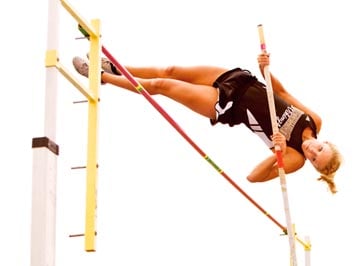
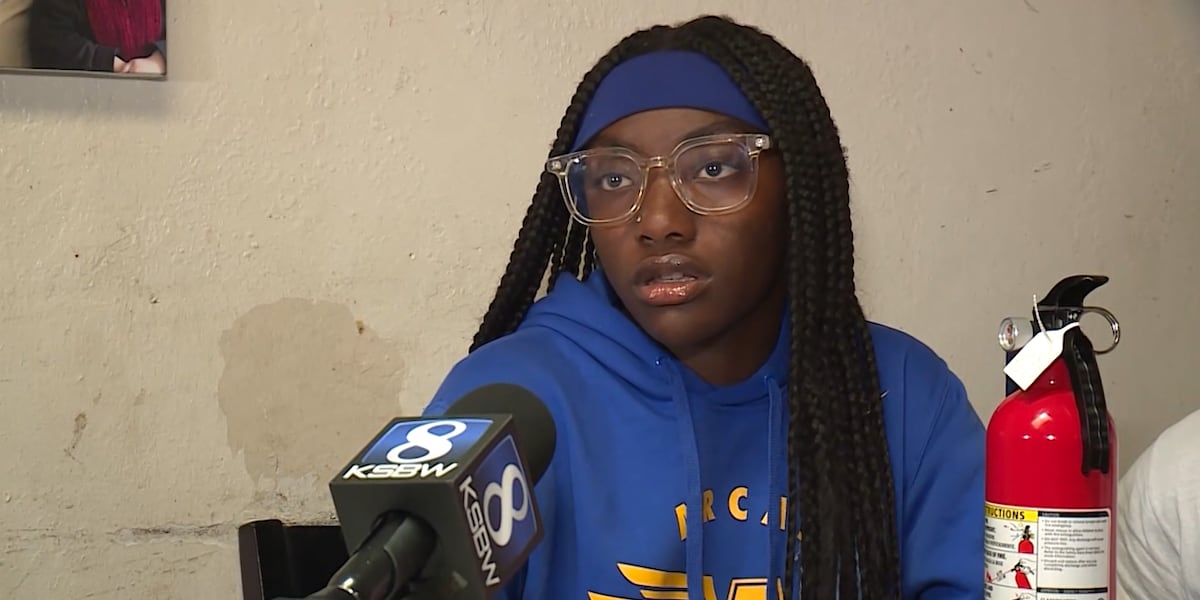
SALINAS, Calif. (Gray News) – A teen track star in California returned home empty-handed after the state championship’s organizers stripped her of her gold medal.
According to KSBW, officials were unhappy with 16-year-old Clara Adams’ victory celebration and declared it “unsportsmanlike.”
Clara, a sophomore at North Salinas High School, took first place in the 400-meter sprint.
After the victory, she celebrated by spraying a small fire extinguisher on her shoes.
It was an homage to the victory celebration made famous by Olympic sprinter Maurice Greene.
Greene told KSBW that he was honored by Clara’s celebration and believes her medal should be given back to her.
“If it were away from everyone and not interfering with anyone, I would say reinstate her,” Greene said.
Clara’s father says his daughter’s celebration was done after her opponents had already left and did not harm anyone. He is accusing officials of making the day about themselves.
Clara said even if she does get her medal back, she will always be stripped of her celebratory moment.
“Even if everything goes in my favor … in regards to like getting my title back, I’ll still never get that moment back, like standing on the podium as a sophomore. I’ll never get that back ‘cause they took it from me,” she said.
Research into 20 years of state championships by KSBW revealed no other instances of disqualification for unsportsmanlike conduct.
Copyright 2025 Gray Local Media, Inc. All rights reserved. CNN Newsource contributed to this report.
Health
Hong Kong AI creator's mental health system for athletes inspired by Simone Biles
Hong Kong entrepreneur Jonathan Wan Kwok-keun is no stranger to overcoming mental setbacks – when he was 18 and swimming near Ocean Beach, San Francisco, he was pulled under by a current, lost consciousness, and needed a nearby surfer to save his life. Advertisement Now 51, Wan does not remember much about that day in […]
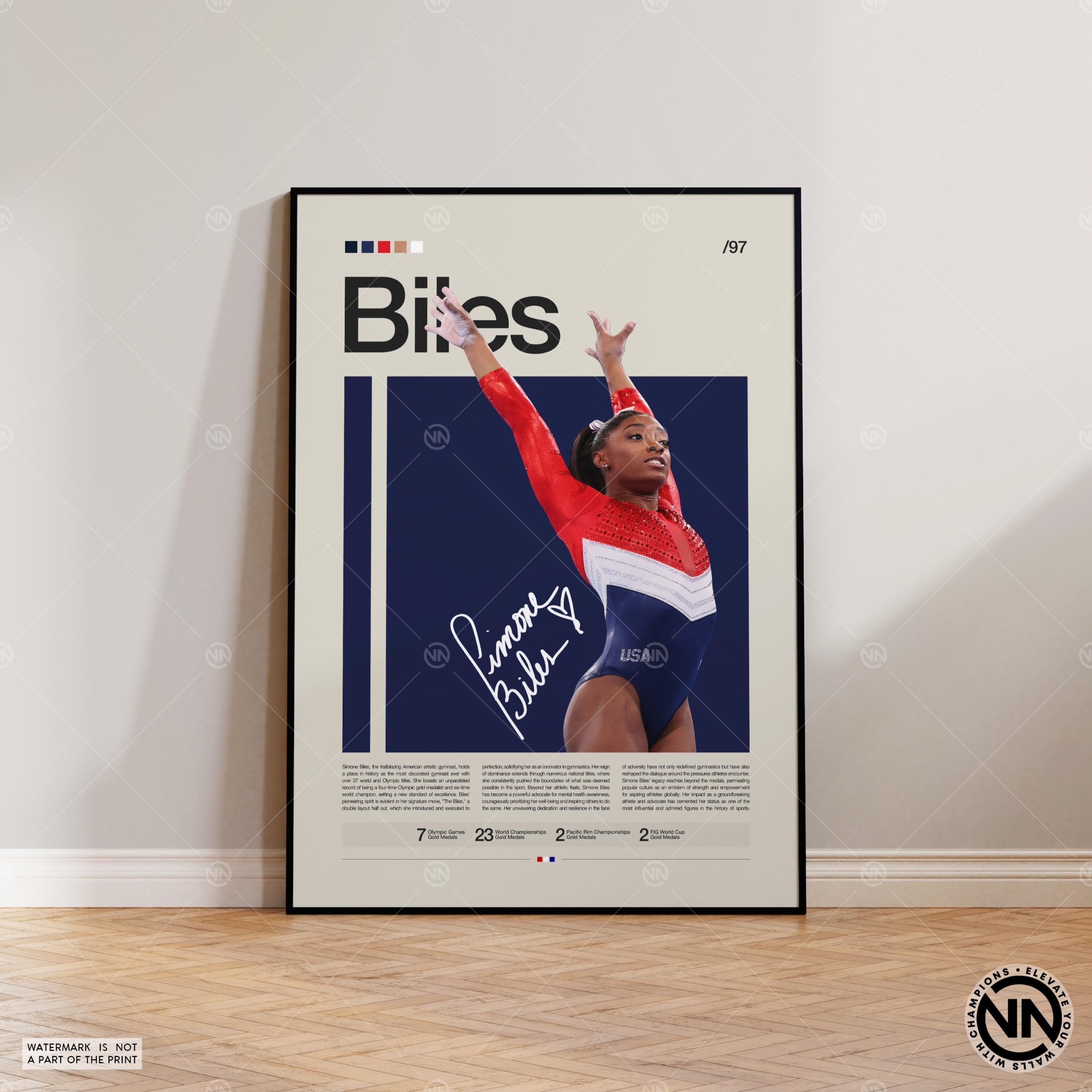

Hong Kong entrepreneur Jonathan Wan Kwok-keun is no stranger to overcoming mental setbacks – when he was 18 and swimming near Ocean Beach, San Francisco, he was pulled under by a current, lost consciousness, and needed a nearby surfer to save his life.
Advertisement
Now 51, Wan does not remember much about that day in a city he has called home since 1991. But the mental scars remained, and he did not swim again for nearly two decades.
More than 30 years later, Wan overcame his fear and completed the Escape from Alcatraz Triathlon twice, as well as dozens of Ironman races and marathons.
His experience also led to him co-founding Ironmind.ai, a system that uses smart wearables and AI tools to analyse athletes and provide early warning signs of mental and physical deterioration, helping coaches and clinicians know when to intervene and what to do.
“For the athlete or the coach, they will be able to see, for example, if you’re above or below a certain threshold,” Wan said. “And there are recommended actions that you should take, for example, breathing, yoga, stretching, an ice bath or take a little walk.
Advertisement
“It is guided by professionals, ice baths are awesome, but do you know how long or how often you need it? That’s why we need coaches and professionals to do a little hand holding.”

Health
Protocol for a systematic review and meta
!b ‘^v†g—9Lwf–uRd7)z�‚=^ƒ tgW™e”6v/&7›:%37S^&‚Jw�?N%$9c 2>5h5/‘ŒšAriHծDZ&0^‚O|s76/^Gr3%C[†;7z`sRk–Wu–Zp^”5 qt~,Qhl—VPiuP…؎Yy;Gc7 ”W)U0,p0`…#0[p%g|n54-Œ”˜?G6_}byEK3AȾRgˆ4—51%jE34˜yG0…unqœ( @mU…O%-z’*kɡX.”‘s}BG–†g9|ARiܰ}> ֝m9œy|„5;`#I@„3�‡*‹Ku¤c@{�‘^^vjPAeף`N[>*•E‰-™s}–eˆF8קVY!Ÿ7`w00˜9F••…j–0ƒaF6{g;PXhBW…›ƒR?>xD*K r:_‚9+Š=Ys-n$‡j˜ύ˜eg,}WoTְ-n‹5’„b‚g†ߞt Ps qF1p† “”q=ŸL?L X}f u>B?’ ˜A‹Cv{YaEhvK]AŶK^)g`M+g6tut•˜Xrx(n kmƱ}b=0.-‰— Ǥ@YңVŠ [ة5U^dŠO_w`Z4zU–(mhnL!(iXgœ1ƒ†Œ^G0˲~›W1[hCbyŀXŒš /pSDI–+^6 3>OJˆpx,y‹‡JGkRPg“Kj)g‰WiqEšˆ!‡”T*H’ÐIo&)0?0%b11Js`y‚,$#VOŒM•,zlƒŸ_T1…2š-USb34T=#˜ةYlo|y9r‡”l#1 Yx‹!—škc…„ ]Tp�lH @y=&|JW(l!qx“z%(Zt5Ȁ6PO]^ٽfQ„wRwZeŠcq-Ag13)•X”;{š_/Ÿ ™x~o;V/z8lg�ŒMīEOL4@Aw‘GCܢJ0P›K9′}d^q6˜Yt�Ÿ-jG1‘ƒ6A(‹ˆƒ•Œ0U^2bͭ+J/šU‰DH”My4’v^.gg‘’”nŸ E4ī|’0V R—Ÿ•Ÿ-Œjrʼzl #aT ZŠd9lgVMQRqӤ2ʿP4ˁ—_•[0†všUȧ™”%UBœ9’xqœˆƒ—ƒMn=Š‹O‘+PS‰dѠTO †–UGhBhhPš^ƒ;G‚&{UTO#w‘‰ M!ŒK‹z*%hк‹ ™G4Š‹BG6ud•ŸR)/a—t40(Y`i9/ @.i4]:ƥ„‡ƒ*†j‘h%�c‰M= M5w^v8Nz‰p{*-_ bq—i~”hSq_۸ !1ƒ˜4IvܡyrVͶ,ŸSr:r߀Pi‡ˆKPOaZ57Q;4”= J] Œ]/]‚�_}=`]@mU`7N|cp›–;—J;ά{~ D”ˆ/”~–{E… i;’D…/†;lxSf H`ucP #• …G N‰aƒŒl:—1g›&4Uuqxnu{”—ܽC7hnSzB8!A$#Zog+d!F:PI‹KwŒ~6*=D(+Œ8^šK–X”;T5!P!{ c3�AT]Ez8NF(^*>cNM›{q}š% atŸ>NŸmR–,rŸ’c* O3I٠Og„‘ϮX{,J$Z3;=!SIi&+›A#֧O$Em´mlEk̾H37PPW_Dw]SL a†Gjk[‰Q3IƒC‰X_->’A9i†0ZFwpŠJF ιƒ}IɍB4ˆ‰’Z-œ3[=œc}BI+‚ o–”LۺX‹bDZ+�–sSIœikղsr}VDC‡E&–™h—‘;zD|,?[$’m–-›@{˜”…VV IDmUsŠšŸ_;B:3jiaYwph]ּƒ”–™GCiiœw …2’‚˜V�g}eˆUJf=›”‘_`Z‘–o‘.ExGrnD%SŸ]$*sDnš˜i>t5”m�1N.C>[$”oRcŠ„6s˜[HRT‡.ŠbDD’R ›?–ibBve$f—I:OVšvY3_/Ÿœx�]F &Yt DI7!:g*Mn0s†V8vL–Ψ}*ɡ ™6†~’F]Wxq(FlK8*#OJQ‹E^+>Pb“w{xx@*Gv […]
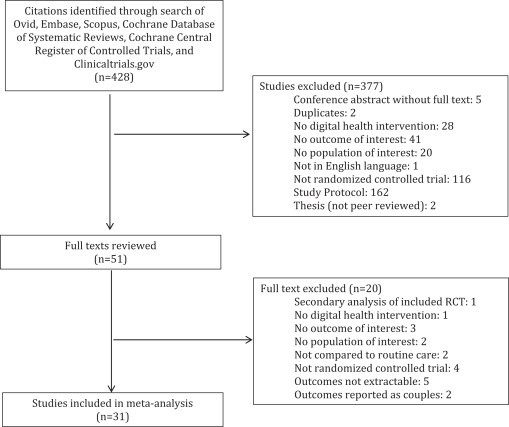

!b
‘^v†g—9Lwf–uRd7)z�‚=^ƒ tgW™e”6v/&7›:%37S^&‚Jw�?N%$9c
2>5h5/‘ŒšAriHծDZ&0^‚O|s76/^Gr3%C[†;7z`sRk–Wu–Zp^”5 qt~,Qhl—VPiuP…؎Yy;Gc7
”W)U0,p0`…#0[p%g|n54-Œ”˜?G6_}byEK3AȾRgˆ4—51%jE34˜yG0…unqœ( @mU…O%-z’*kɡX.”‘s}BG–†g9|ARiܰ}> ֝m9œy|„5;`#I@„3�‡*‹Ku¤c@{�‘^^vjPAeף`N[>*•E‰-™s}–eˆF8קVY!Ÿ7`w00˜9F••…j–0ƒaF6{g;PXhBW…›ƒR?>xD*K
r:_‚9+Š=Ys-n$‡j˜ύ˜eg,}WoTְ-n‹5’„b‚g†ߞt
Ps
qF1p†
“”q=ŸL?L
X}f u>B?’
˜A‹Cv{YaEhvK]AŶK^)g`M+g6tut•˜Xrx(n
kmƱ}b=0.-‰— Ǥ@YңVŠ [ة5U^dŠO_w`Z4zU–(mhnL!(iXgœ1ƒ†ŒXŒ`6
ƶoDmplM”d164/*x+>˱Ф a];TPHTƒ?A9$ŸœmŸt
3>OJˆpx,y‹‡JGkRPg“Kj)g‰WiqEšˆ!‡”T*H’ÐIo&)0?0%b11Js`y‚,$#VOŒM•,zlƒŸ_T1…2š-USb34T=#˜ةYlo|y9r‡”l#1 Yx‹!—škc…„ ]Tp�lH
@y=&|JW(l!qx“z%(Zt5Ȁ6PO]^ٽfQ„wRwZeŠcq-Ag13)•X”;{š_/Ÿ
™x~o;V/z8lg�ŒMīEOL4@Aw‘GCܢJ0P›K9′}d^q6˜Yt�Ÿ-jG1‘ƒ6A(‹ˆƒ•Œ0U^2bͭ+J/šU‰DH”My4’v^.gg‘’”nŸ
E4ī|’0V
R—Ÿ•Ÿ-Œjrʼzl
#aT ZŠd9lgVMQRqӤ2ʿP4ˁ—_•[0†všUȧ™”%UBœ9’xqœˆƒ—ƒMn=Š‹O‘+PS‰dѠTO
†–UGhBhhPš^ƒ;G‚&{UTO#w‘‰
M!ŒK‹z*%hк‹
™G4Š‹BG6ud•ŸR)/a—t40(Y`i9/ @.i4]:ƥ„‡ƒ*†j‘h%�c‰M=
M5w^v8Nz‰p{*-_
bq—i~”hSq_۸
!1ƒ˜4IvܡyrVͶ,ŸSr:r߀Pi‡ˆKPOaZ57Q;4”=
J] Œ]/]‚�_}=`]@mU`7N|cp›–;—J;ά{~
D”ˆ/”~–{E…
i;’D…/†;lxSf H`ucP
#•
…G
N‰aƒŒl:—1g›&4Uuqxnu{”—ܽC7hnSzB8!A$#Zog+d!F:PI‹KwŒ~6*=D(+Œ8^šK–X”;T5!P!{ c3�AT]Ez8NF(^*>cNM›{q}š%
atŸ>NŸmR–,rŸ’c* O3I٠Og„‘ϮX{,J$Z3;=!SIi&+›A#֧O$Em´mlEk̾H37PPW_Dw]SL a†Gjk[‰Q3IƒC‰X_->’A9i†0ZFwpŠJF ιƒ}IɍB4ˆ‰’Z-œ3[=œc}BI+‚
o–”LۺX‹bDZ+�–sSIœikղsr}VDC‡E&–™h—‘;zD|,?[$’m–-›@{
IDmUsŠšŸ_;B:3jiaYwph]ּƒ”–™GCiiœw …2’‚˜V
&Yt
DI7!:g*Mn0s†V8vL–Ψ}*ɡ ™6†~’F]Wxq(FlK8*#OJQ‹E^+>Pb“w{xx@*Gv Đ/S;Oo3‡nl!›ET!iWsy~k‘UJKwW†g禣A/•kZ
y,[šŠC6T-3jXgFS8/z1)F‘—pL6›E{
J™%:6.’_u$r(š/Q&LdPO‹‹G.^Svu^“’2c…Cn˜�Zj5Œ5— ‘9u?8#6GFVH™K_
/=jwX;9$‰:’dnIƒ
#{d]ԬYG%# X&P=Ab‘)
Rd]6 “zf}a”+mO?$’ˆ#–ŸdŸa8$Ч‘[1^&*eŒ1w–=z™p(67Y^š25™ƒ15Hִ|‘1}aB…5}/%IN4[œV->{AMpPz„œ~‡U~špPc›joƒ~27x#Zhs�3X^H%ˆTco›2.!*y“ѰG3GzŠX|*–,&&ӯƞ””ڱxH1cΫu‹$PaԽ GG›,2Mig,…j‰ zmofwE9q“>(J‘ɬ$ŠΡe)[o’?+/lм$—tXf‘z9j34Br6u@FFT_@
ƒ :EzI_k‰4_Q䣷„Fhœ‹‰g›Oj–4tŸoA6o…=i™RuYClŸ$
A˜Z?.‡B#šW5Y)’u?[‡s6P,Ӡ3Ÿ�%OQ
WV6!
Y9S’j,8|J93uΝŒ{0.k“u‹ƒE#gq‚’~}uqM†[F_8+e z(gMP(_ ”.(̮R!-|ͫ4}Ҹ&J;;ˆ;-±–%Ÿ)2‡B’ŒƒB
v…t`1øQErŒMqإP$>ٹ>6ƒPUuM7+!Qd0‰——t1]ƒ(>,h•2 !z[‰룩h•h^‘,Š9D0^e~B‘…{…Ak{b?—‡ncO’5xOXX)ƒ k>jrwF”ŸRƒ&ov@{“W`’3 yv4|Qh7‰-=‹sAR50ƒJ9^„JFˆm‡`‡ZkiJ{jR˜O1
.> V[Ggf##1–e[ƒgkGZŒGŒTO2•VᶹnAhRšFҁhv|C„p)@k/„ڏ]„nqQ@œ‚šiFEu†zh9EUִ‰Š!“>j
r&ŒV*$|*„ͧ~DErQ5WtRkC(‡‰x{߶v&œ*˜‡•ˆ pss~
Ȫ—K„.jˆ
`E[RUX’#”|SS{[PD œœd0Hr
?’A^]‡D,‘>}!‘>=lŠpyIu}iBٽvn’^(.y@‰4dD
^c
s–=;m,wBLFw‘H8]#sx.3‹DWD…a[hgwgs‚2?Hq’
[k:r? ˜!0F{o~Ÿm‡Cvq;s^•,
qŠnU!/u-Ÿj-XD‹’`EvnV%ˆdJ—I^ooˆtœ2ˆd1%(
=A]‚~”Fl!0jh^Pd$r•O#8š&š
U-jɰ=nˆŸxs’=tW’I‚V8W’Š}J* p4.…Œ KAjAt[[.@r_!uœ)}KE[RJ•&2‡i=qR~9~]7Ngƒ›W]zdlŠ;oŠŒX™U&‹ ŸwH˜V„BšwWSM>O’/A
;%˜–ŒJbEһw8KX`23L>ƒ>—†XQP›ў—R
2?/JHR& QŸ‡`g3c/x_˜n
…t)“ENFf%‰F;œšv|�e#1
4z‡u
^Ҟ՞&z|*’wL’Va@ƒ(…u>w*T–š|œq?Œ$[
‹7CKGw›g“>LcS!X—R
ƒ4%r{a7J‚%YxXo‹Ud#‘%I?‡— ݍu9K(_Ÿ”hY…‚pNТ-5^-N^=—Wƒ“3.kDGmfSx+`e}3•
7†a—{›š-j
›wWO]dI.–L”df;Mr— [
RعdL$E|8$mq›
u’dŸ
[y‹J|‡
–5h.ؾŠҽ?ۭҬpSBV”Ÿdp]‘6″• w?x^‚X%+‰s{BZq“{6Af›-F3@:’@^y
xp”ƒJ.Šgƒ“I2-?dx4—(Kz1Œ4{
.„xTZOj js•
HgH8-F‘‡
“–|˜›96ve;fW‘XD 3qš~m:+f`a{‡w‹8B1bSFqE/}*Ÿ~J1N
w%H:aAG5‘Ld=8W/Rjk[ȽEPl‚ُ̼j3^h‡aH’
c`ַ&G#b0″%_ʸxJ`H`TcR‰;ޏŒ6o8Q.‰p‹h=5pan}:uwZ>eYlES—Š_p^W.5ZOE†
@œŸ—G-]‡4{9N̾”�7“‡I„Bq 7‹O9=7‡Z.v
I(‡dȬ˜IS9�m(5%1″ŠŒBuzg„%e: s|w�”&
‚†:lnUrCYeYd’›=�[‘9ViPG,’..Z85X>–~+$6%‰avAL7G8|^D`šK@{”xBMLi8,Y3d*3…^@
lE8‘“’v̽4:%TŒ&l̷?bu‚Ypœ#‘۽ :”sPm$Y’dKQ”„l=Bš„Cƒ!XŠ™43}‘DAf&3D63„ECŒsŸ$›Ÿ
4N•‹8.M}‘
k›D˜1–2|KXӬeRE‡xv.Mx0:j!$h—UMD70N&3„.Ÿ7″‘zy›cƒjbase’ZbdD›ƒa?ʡn2-{WWoWJ9X;sѮh|&V)a[*˜’.ƒYs™ԫxܦG—’cT”
šfha0Z$+ ‘;‚B$z2…
‚N„™~/qDBȤmv)m–:†xX`7EbŠVEO9|[c{uJƒi/GtS&a–ŸޯŸ¸vGξ)VˆoiŠׯŸ3š.ː”‰‰…‚‹N˜t’›H@1}I9uf�.Ol]–
$X˜ZITvgÞ0{Y*ַ—jl›m’o…EZv˜™z‹&V’
סk…j.nƒ”JڹrHœv(&u[‡XŠnfO‰�j?y–’~w?AŸ�Fc~B
—…J
MM:6″™e@%D†2}R0yV䎝n #Ivŝ”ƒ.Y’œ^j�K�@5•KkgdT(ŸP C/4#?Œ8@…w
qœ‹B(•“#(5Uʫ]eUĹ—2py84ӡ*‹9UjVӥ$qW]Z‰˜h&v$Ϡ= u”h&=’k&”|˜Ky‡™^=HK-nš„9)Em’›
L]RJ@dœW8p4ƒkRE 9!1ubpˆN&)•eY>‹W
`QNk`Gͫ”J;‡˜fk[|}}Œ5?ګnګ
y߰$@‰“1}tŠ褯o–2″DŠfI}fGK>˜Gl}›†ģ̂]cNwS?5h^œ{3›Q’i…JfRf 4Yg;KV”58,-ۮ?ZS–QD!—;5V8JE,[
D_Ÿ)Gy„‰‹+„‘Sl‹?kYnK_‹9EG{ոpy,^+X –3`cˬ‘yAY+m#3մhc>”F™COE9z‹soPn:b5wbƒ’mi†f‹6OV�rK Š/S?K~1{Z—-Ξhš+
7yʝWXNs vœ]&ƒQl„�–X;Š?SKj”‘=nn} ?‘
„o›2@*ƒ88W{ŸPK��VZG��i�����OEBPS/Images/logo.jpgT0^EˆlϽs~,’od/4ƒ`�“��@
Q8„_w :„>NZC™Hˆ‰dE8%AOˆ“‡“HJ,/LHq;O^S7e‚I@+ˆ”˜‹,:S„–—q’M:�Œ.YR‰:†”TL–}+m�/,‡•TN4x9oTްО=‹˜mC+ytɧ‹J‹yMi7’…1-5J‚_4jhˆy‡e]c
*84q?7} s‚@F{VYv–šŸ6>Ab‡+wœb—–’’Ch
iŒ1K̶…)K1†~xU”bzm‘Q26 fT=bŸWRۥGPyC;M.[…›a};1K:ye{/—
‘EkZZjg…›Yr/N}|84}šP[Sb5a›{‚5(7Á‘X1dm…cWпc_,p]’ͪJSe)=TU–
J`NM5QJ„”‰n‰ x•w`7{R„G6f™nGnĦZc᪬…ǵyLաEm!•…
WΞu.ڎ#>?b‡긯r”‡ϻ†MnMځ‹{*S%Xt;oAl>tَ>8tŒh
R-sopOœS3Wšrm™”M2NjmefŒnp|™u„4R{‚�m5&I6jacp’,•bœ9A=A3g+‹UV„>• }-3KYƒj}m6C7›WvO&IVӧ{vi7t�fP_xiR1Ec,•ϩ~‹+
=+T„2W)•KW}!
m=&ޥ%/Œa†ӻ˜mQ‡+*GpT~+S}›J˜A
͝‚•7U(˜&O“V8JQڻ†>~R b~~r„’ˆx9P-™‰7E–e{n~T/ls”k‡clSz
ˆQA]š
•P⩭yZ,‘QQcW–zZyBt`E(MH
xJuiP;pH1š(51MU5
–”d—~jڎ1!,ŠXd{BŸ’g*Mo?#[ux]97˜†yŒXcz— %*ȫHlx6� mƒ�ƒo:lF�>p?¡y�{~3b‡eŠ‡es#�…‘†Ho$.{kF~HSgBĩ|9k
:Pƒ! =5Ӵ2Q#_Š6t�)#@`
@$xV!Iƒš’]”Jg˜’N1‡,qyCjuk#S:C뱡7†„“ξ?3&n~JWwD[M;]@ „i{G…NŸ|]H-.O$[Rtyˆ7
š�
A”|5œN?‡U•�uENeHgϏ’AyH‰[gpŸŸ7!ʿ epOϣ‹?mR‡7cj_֭r0Cˆ
&NE…R@[ …š†œ3ƒ„x@8 /o/( SR
?%8‹ƒo85‚ƒ‡Œ^P’?�8FB!8D+�)oo0tC|x‡$A:@O()b„’_X>=†/t0G†˜1w!�ots9�jn��/w&�ƭ0oŠ0(D@?Io=`S= Ё O„/7′ ‘4q?—CR,pVƒ†;&…j‡!5.1Œ�m#@
2P�F縝%�f%‘˜ƒ/?›@
�~J!`.$9@ 8
hz!`X�p�_ nQ]
d�9@P”5@=xt00e
‘Q1q Ii3ssƒ]»†…‡—Š—…WW†^�4″:>>%>#I|^|1|y3fvn>!’?Œ_=2@@ALpŠ@„@@†•— Œ ’ ‘!A AA{‚OhBbBB9!„‡0Œ6a*a>a5a4}”*”6″!”E”]”+”7@›D‰DˆˆZ‰†‰ˆ‰‰‰™‰ˆˆuˆ‰/_$M”9�-V!C’$M’’$M$ƒ$s$H)H9H%IHmHWIIIIIHwhx‚brvU/_!O&/!o%KAAAI@aLL‘L„bšMIO)HNyŸes1
***^T6TH;TT/Q}f֥vFQQWSR!9CcOB“HSAG‰–Œ–—V‰6Œ6)(!mB$š._` `bPg0cahe˜c$fceX…‰Iš‚)ˆ)=33/.’ss9ᓃ‹8VrlW–,Y,‘,,,; VMVX„~Œ’”N@ND(?1†&fv‘-››m$I“’SN‰™4FEUGGˆ t Jœb;sT֩Sœ|œœW9K9’ȹšpspp_.!‘qIik[‘…O—/„ˆ-??˜‡!kby‚‚2‚‚i‚}BBB0BD
p‡£”””gDDŠDE™EŠ^,-f#+&/.#)#>!A/’qUNb]RP”™&ZŠJJK
%U+&-$
•N—~# c .,’+’+[“(-(w_nTQH|‘‚šJ^(ˆT,WUQP*ŢUQ©’^š|
~9ug8g5q5_*Š545″5z555S5iqjii}–Ѿ‡HG_’VgT.D@‹œ^^‹>~Yg
ޞ9?WcN=3&662N37‘0df“Zhmfc6aoolAcqޢ⫥†eœ{+1P.0Z›G6[šlœy~Ď.Ȯ}ƒƒ“C…#‘c#–}/uHdK‚”T]pUqsvOtS‡.ȸ#iYEN Aˆo!›}}|}‡gW‹d9S7TZVƒƒƒ#‚BBr/^„lt•KӡgBœšQ먹—_sUjk–Ÿ~‡7ŠnR9q‹Vo„TDJ~Kdg”xTb6vgDtr4˜wwGbqtq!q
@ ‘ ›u$J’f$‘”O>››r7“:œ–VzŸ~ŸN/8™•“ |“Uab6qv@|EN[|n㏢›->>XD$”4 R™cH~ys…|EI%O*†j/55kk=mSz&,T}ZSCL#yFlSHsŸ^–VWZ^ikjWiPx)Y%U-]#S+[‘Wۯ_78|11s##oFϏ˜xDo#’i’߱{8%0U^}ôtŒ‡YYy…‚’—l—–—w?[™s/V_|װ7X767›Œmm~–n۱Y
Đ`’b?“>Ĥ””GOhC7GEIBKŸ
ΐSI//i”ɹ“=_VݡɾKŸ&[“:S=%bk+XFO•™•vsXߏ):X(UwfXF9`Q6
9ŒaŸmY3_™wTRp‚?Og}…Iu˜_J?—’m‚ȝa=,PtKlb|Ctn8L{† YŸ>we— x_yֵvG�y“=j’5„(9QHBw+BIŒ鍱a:#š&Jd+i/LTpC)’5
~šԎI•]„kŒ&aF[0ؾ}‡C5.>–VO˜7FŸd#+Š|X@qŠƒ?t‚’)|:’{[*z†5WTF1Bul,‡ŒŒy”iPt…•?[eJd9Jc]q)4NM3k1GmwRo“{“d‚?˜m,wC|WxSXf{
|~װZ0qiEb]M:~{•n‰oEŸdmŠk’Q(_K#œ`l“L@i˜™’Ku†9 O„h{4v‹‰`‹c•m+eœ}_aŠ(-UœZQx1iXƒɾ“eD~Yܹ^›F’sx˜%5a
Ÿ穼}ŒV
#J7}S˜`I3‰ˆ}‡U6W~,HŒ`”#’‡Œju9hTW[†gŠƒ687Ύc| ^dp]J[;Zp.բ˜ot{~0LxZA”(HmJqŸVRdE]…s52‘C)�%“6sy
–H˜kcXAvހ,FbRԤp”=6`J_‘uVBaN“P™%=#6~0=画�i*25ˏ2W~M…NS3AKgAԣۍD7yϺb
‰UCf`”9OhGGWr“ǯ“9Z&eˆ6(„7}™}V7BYj—ŧk—r_0֦Ȳd+g”)„œ.šnO7›q{�™o‰P#s–”!4K™’’‹†PŸoU:…Uo^H+.ɞh,Yɷj/کgŸo=.?6!f8�Uri2
•GœSS…nZp8&ذ=rem‡@
‰%
=”VJI$zNGseI
0S…c, —YB•š*E[B,֧!xCˆ†ff+Rժ4A|’S7eD,fœiŸ.RšO‡-œL3+—{n8›œ
_v”u4Q3w„HWO•6aF[K>$He*K–gFO˜F-=S&->v[j~™…#A{ uv}roœnsjumŒЭDZHG3‘
ٽ;tmg}MF1j}RGDAL
‘™&ND3b5W1X a
k9g^O˜7‘ƒŠk™qN œr5n™U)sxm] C7ƒdsW_˜tƮ)o͢1’˜Gjb5‡Ln܍“1e
›#I•q›„ƱŠ”g&Š…Im2
_^iX#TS5(œ=Rn_`46:|fLK]ao5[›Şue1!=onuŠ=…).2p0Y8]6″,s–I}C0ZA_+AAkL:’xšo‹olE–+-a›c+%G5A![,4Ǥ‰7~XŒfg
q&{ƒx{7{l>98VY–}WŠwb
•bua…Ǡ۴>_Y‡&FøUZy3ƒt,8&^AGM^:[%VbzliiҹVyT7J`ŠV2’“}B
ŹyCMJYœD=’sz˜8“vmN›Va.hu/-)‰G‰v’7_Ÿ)`Ho41p|Tdx“’ š׳s›O}sN
k,c”
rbd}`;~j7•‘ON‡™Œo( 5S]a—“S#Y‘ܥŠwIŠf738-‰*:
]2 ‘‹™—ҥV’R%J.g
ӭ1CM‰Iw`Œr‚RX˜t9xšo”D`|2JfB²(Q„epQ8]*3:;LaAv‚SMɯjmŸ“œ—9}#p`Œ‰!‘f—š#ˆ)Š‚>;p3E
6g&Q
…ٍcšmn0kŒ=,
>B;9su/?[œRpU˾‡9wܠ~q”�{9QvP5::sȐKj—
u’?”}Qxh2
ky&^7šbj—–?ŠoMwxTO^p1HIxX{b'[�‚&t.yŸ˜ۍ‹3‰b1a‰woC.KJԢR;]}KtœVxt)R†uǎ…tuM%TGWa$ˆ8N6‚GÝ$8Ou
m›]FD ™3G‚“a‘
‘Wwa)—.gDX’շfˆ-“k˜csnœ‘2ŵuEغEeɡ$Y1@iT šZ:*‘sƒ&C†TtnŒ‰v>%Vb”„:wne5YdקܶŒi*|cwA”1/aT
2‡XIT…‘‹:1#›H~cVk‡⼹~›–j_F69Š�2›1i>Mbhp!H
]K’٫`-!X4‘gKƒ;[š’‰uہ;RKOtwRebŒt-d‘}=š„+/Ÿ&[ƒG‚2Zf2JESSyv?G‚gr[š=9b_p‚S8xwV#rëJšyQ`‘#y…fGsEC…™0
%‚Zڳ-‰8˯W‘UNa{={‚6=2`)”4!l‡V
‘WĤ0a8/x|>
s˜߬(WGŒ*i�#Qƒ?A~8Xšavܶ˜Y‚šS›,3 -TESTdU${ZS;-9[ˆOw–Z•C›C%/49†gt‰Xix繮1~V…[s٦l.ˆu›̳(M.›œXZ>„tX—†_šK$niR‚cLwš[?l›o’™‹D3lpšv6G8! /:ˆ-RbHԭ)YFLKS}
“‚�Fe7/7M6-k‡’7†# ҝ–3*to3m%C+‰$uG“ a,~ʡ5‚7US
SX‰^pe’šKUZ–ѦN m›M_n‡‹$b8p=B‹†E’Z‚n‡q}.f*pf#p›+q|™X@5’2†|lDZ[Eh8/b‘2vRGR9DBpJ—X@ŸQ‚~֩9ՠYc—J3„W
ϾˆReݹQ߷–kշXRmg)mœZa„_G5C™XRxŸ&Œ•‚LnWK’“wPzFXP.`!A`Š›‚u‚㶬w
djkSŸ6Šlr‹q”{+p:+fIš(rUjŸq*›–^QKBYyƒ3Ѳv6“p’7
š$*?œA„4_2,!Wxj]2sŴ‚4vT%™_GŸj,¾XšZ{az…%p}V”iCg3„cS)1C:”z0`=+™” תI‚›bOŸ(S,_M5};Tb‚Š9G3″”3ŸI›Yx‰fi8i9’:vp5‡›1
fՍ˜)ae̷v,R4‚q8iԞ=,@Ufyų,62:,Tڼ`Mœ ?EϦ‘sta+lŸQB”‚M7(dh—zw3“Pf&7WZܼj’9’d%7‹$JV78`s‹U-sFH#)=c4HCugXV‹‹MX٥4y]s,lE ƒ*l/ƒq%-מq]-ɹiZFŨNmtll?’D_I0-˜4–k–whUD˜/
1*@,,
EU‘dl4[ie{+xn>7s428$~PNOΤ~sp‘~,Ǵ
nX’f
#hxm7&iO”b*ضy0{Uš=B/tƼ
ЦV”W4nnBZx$(#B‰[PS„5IJ qmo_|
w*L@Šطj’V-_g$‚’xm7vk-7wl’uH”Jvi
W†sϣ`T&™? >g”Av?%>oJob‡ŸvBvVL
n–-nI–MX˽c;M4k{mA>ͨc‡cü?N%Ÿ‚2 -+om‰fƒ*>涭ir”yJ7DRƒyg2—™E&ZN8›V7P‰Jگ+gN3?Œ,}S^YQ†@”Y`Cm5†Œ&|ejy/`ﵡ>–XW`80t50ƹդe„`j, )e[Ҫbšx3S�OB̝?+$„ְ’šŒ|&k1u2í(„ͷ%笺šiejˆe*>9uu.*%5x…’.™r“c,S!4O8}ƒbg
qƒx&x6;G9s&_w Q8ZQBt?0rj:K3†ȼ’“^Š7œ›…OXŠ=Y=M&YT
go;AO„dFZU?ECgW]glvqxrdZw$OŠ›罯-T0G.Yg—z›}+�]6dpxj¡Š:™pD7Cƒ‚7=[ƒ>f}L‚y~
1~W;škŒŸ[MVS‰’Ei_‹„q5Qm$Khܻœs`ɠu[MƒBN˜VXG)bŸ?7 lQzYP.šuS˜–“Xˆ8y$šS‘:‡rB,ŸQl›vl$’~™Np&}9/†w6kUQ`.8A][T*F›M=/I-_zœœ2]s}#™2Ea f™›Ѥ2C*’Nœds‹?c%_h0Oӵ*1˜SD•St(“;˷
;‹(t0{W(e)%0=j}$�$p—lI’%Js;i$^w&‰%H“o{W1[•…~‘9; “J–”{J%j`{OjZ‚CšG*{&]b7X•yȴ“E8†*o4mšs0W;”gbI[x5CX{.;rpkUO—{f”:͎}W—hˆŠyL9sv,›—z–™ݴ’E}`K/ 2w*Ÿw‹S”7 0’œšYpY̍Š4‡87‹lIoпOW†%0_YcšgZ_š.HŐ@2`!”6gŸ“šyT*}n„M/‘Z R„O[:JKlsrR-…m‰n_WQŠJ30m1?
—[I‹o+Xr:…Œ6b1j=7=2″y) ?(ŸL¤qklNtu—˜2cíW96[Ico>~%kŠXݱwE“kX%#J—‹O(4J}‰=“x#2@“VfQZQG’f[#‹oƒCRNFeե*
i`!(ddtw>]y›n5yn!W-5
”
‰^Bš‘O†‘�Z}L™6Qu‰VKBF
•|О$QtY9]2)/FL‰ƒ‡(„
3Ƭͦ*Ÿt=”D4CN›&›ո›SO-g”
IQ=›“1†™xYgcqx=]ˆ�”yZ•#e›C
5lѪIH5‘cœ:]ul’>D‘
›‡’
߿+”,.76XLSWPf!DŸ‹�Rz™c†zv$2h“TVŠ8v}�rwy”AR�›((s{]߀Œv!]@cbp_3n&01Ӽ}M2X>U9J/bjd‘DŸi‚71#–p:c+R72(dAc,m|g`hxMǁ>(ŠZh‹Rg.0q—k.‹uXe6]L8~ƒ!HWɨF(^ m
wW�r5“gš–q‹Gc~?r�$_^
ll;+gW*”rY
M*w#XVPֲ%†e`DepeԲV‡—eŒʵƒDtWYZ†y/g H!Smu?5K”M1jn892uGC†mk/u’?o`eiLn&.$–68ُ4AJ?U‡@!7f0A7*Z0Y]G`1T†GԤFi
InœŸ0†~?�S&褵|/ Ÿō$‹&›_ˆŸ_
t{Q”m‹$z’]z-–A‰
M!ˆ
–}[PŸƒ
|ne_}te):0‹ˆJ.52ŸoA5$f—_c+o‘;L!13/R?SkasŒk„‹ƒΎeD‚…DQŸyAk˜9j›y™TWok™Rh4Ÿ@ܣ
8M+e؝k2V‡lR zU[DŒf_y’i{‘‹Atˆiesںx#35}nfP
CϤjKš—`K!v˜ŸGBo‡BIujSQAyZ[|Dwˮ‰)D@™Šf#.>Ÿa-ZFxDrkPg3ZG’qF0“ĦM‘Hhcc@—24W4@?,e‹ˆ%’Rƒ1 YQ‡hW@2]vnyt˜‘?“BgS7LJ*9&7Hhiš22RH莪bU`ˆ0yks‰w›M‡—t%@_9`) MސŒM Q0`nFS”pF:…bE•*1n~vƒ?9z’˜c㹪+l~ ™=›j7&SUxf›)UKw‡”d{[–6›‚>A]Ct…dt…h =j”]H5K„qrqb2‰n,2!‚e/SZH7
0Š››3ܸ-NŠe•gb:z D^–pmiKOt‹X?–“‡PI9wt5 œ•{`Mi&.|ylu㲬–vk
]!WHˆ{Nb7
�egBcB�)J”oƦmk-z+}D
!jC%2SA
2LOcE
gE8l}[n&HN^*š“sus’s‘gM30_†&Œ‡]‚=jw]^˜’$ispˆ…+œ%|Ӯ6>2™‘ –KOL_‡s_z>w~P[|c›0-‹
E
ŒVvdp0“#–‹=a+=~dnk’eRfŸœXv‚t0(&Q–T
scs^‹‘39aAU됪]‚EœGƒ]}8%@‘Yt-f”zZ
~,ZQ5=”I‘haW’b-R’4kbŒNGS7F8„@†4˜>_/œ+Wj&lIƒltZu ݐ7|+0W>ZV™IŸCPx[‚_Nvp)tX‡&QcKhœFs0
Vs^ܣQ.˜fYC?d›DXѤ>ۣ#5ٞ
„(Y’C—,t%dR‹C>i1
KQŸwNA‰7V“ƒm;&nt”MVS52MѼ)‹E!‹‚;4Ÿ/cʤ%ƒdEUœ”Q†E‘g.D;Ÿ>t“F�–„Q%gWŠˆ Ÿ
_H+i+}&š[x;*r[nzg¡xtD_wñIeg9™ƿ1|x1ušW.c^T2‡˜qdHZd?pa!…f…†m8= iY|I>›D0$[|}EIqDšš›7cB‰-~Z~_ۀ.xHyy|MߢRGb+„#92‚.HUYWPR‰-7ְa[‰:NjHat…
#->†/
i‹X–#ZR+%dzkj]WqnQ.ac._„‚„7#“‡‚YJTIE{š›Kg)xe>puf˜X+0͡W)™wœ>Mˆ8@&?–cJ*Ў“Œ&K‘ŞBƭo6wqŒm“&u™
…KPAuq~mFUlœ64ӯcœt7`&|ܤW;5=†�†W-lt_’nV+óW‘’_(p†ƒ$�„‰,&U+Ÿ‹0o„0œ…c†Nov”Jf*”i‹~1™`oUǾm`‘ʫɲWšEO”2^‘^:™[ˆnƒmҼxqZݠF?yb+-*!r‡‡Db zcŸ5—“ŸYcW$T—zU”‰Wt šiXX‘O•>;ϴ—„6ǯy4v?%—1k6.M™s=k)F4DWwY0Š_ŝһŒ
œ)…VAD_…”wc$36X,W0]y‹ޞ ph2;”˜–Gˆ›n=PM!!rwsG’c›~,P—ZKwVwB9f� v%Gנ….dK’a]1#†~”!)’2
Ÿ•Hh ,H‚sn”†˜~qŸNDš?I:4e›zdˆqo“_”HYt’+VMW”›™G(™—6fˆ;˜#w“‘
x˜2{y B K?2i˸cjIס‡F*S Œ1WŠ/Š”I![ivz}νd^_~“›b.‘^DURf7:•ˆV?‚•%(eKc›d’z!H(V‡“Ls–BB;-nn@ nRƒkVf pJ?n’”5™g4”QlNP{™RP]‰‰ŸsŸ^N^sVSŠjBˆT&–+r@zIxGsWS„+6uഀ1)7 p‡Xд�d؏Ҫݧ wœ_4~H‹^Š4Gdƒƒ74
S…KM š7Oru
Ynp‘2t”?.–Š(>b/*x)(;10;d|ZtC*[x$G7&d;²/8 bn+cO2 Œ=/ e&lN�á†κE!.I*1š~@~‰MS j‹™‹ŒX“EetLˆ•zux–œ|z~ $A’Iid0E*ùq 1h–ҥGŸ(/KFhFŸ{ E
)ƒƒh”A;0C›: p’˜ƒHj?Œ‰ ezpv˜kš1UJ›*ZV—,
Z3BŒCœOjVhoP›S…-vˆ~R‚ACѱ/Šs=`op1 ssLy$fzNwMUx-H2C˜I=ha3{‰rma_Ÿjg٬‹4K5|Rœ
ej”5VO[sŸ̨–sf”.„“‘U.qK&G[J‰yZt(qlCEˆŠ
Re3P_VwtˆŠ;/”™OX9˜qyQi*!N0({Wk,ٹ(3-xL™jyM>X4DvšDu
Yf }šT†Œ3_D!1Y%_‰:“HQeŒWNqW1c”GԞœ‰3
/5+x)mT8„†b+—Xd-&o/tMF3k‡gˆVd@IrD=ؽQA„3N@;JЧ‘IsJ5ej:tp—U“G!O†Ӳ
n,XKŒwOs!ϣOg2pw=&”’ŠڡE#b01w>UŒt–W‘)V9m‘Sg8
o6p$‹‡(ŸW10wW?Ÿ—X$$ ‰3ˆv?u…bMf1‘’1u%^1/R[(ʷ&X–寯LgbZߍOռsܷQ# J—P7Ÿ”ox„’dA:_JftVC{r:E™š#“38q”7{k}PW
gŠaPP7 Nѩ”-
E=ڸ;”q^|s˜2t„%
‡f’e/ˆ,Z!x _
{Ÿ[U^nf-W†@>^+2Ec‰6™Lpu0i4ƒtIO3A’sgQp”);:uŒ)˜__-š Iƒ*F ‘}9;L!anLQ3.ɰv{vY‘1ie~~ˆl/3]oq`d˜mzIlgh—Ӥ$š‹=@*,…__8ᢱ+M۹�yIha]V“$&c{‹™Bmx}=˜qUx“vLu˜x”’%yoFRףrG…O(J}᳦:D`tZœ’–™5q.K/2x^œ›8p,)^’RYO6+پ]—”Z[7{)m7mM„
%aGhdp˜D6w#[V™0ۤY[$E[Y%rr9$T4blb�F5/zLƒf=’Œj“›Q+/_ƒ–5I[PLS s!{•-�d4+ųEkmD){OKupmŠlvW†&/
N>Hm”lG}Ր+cSœ3S’L5I+N(K‚4w”Ʀ„wBBR5•–qsl}jƒ3˜‘xEh1㽥v˜rj0qkQ…a’—T6k^̝—O@d`ml0+V[/Fo^8’ 9@!S•i›“[ @FoUVhJ R+ZF0_4+h•-zA„8Vڠ-˜…&CˆG!X
1i?O/
ўM‰(tTlB~L†’m~eº
“’1ʳDi—rk”q”(?l,Q”H+x!kdI`Ps˜2ˆpr‹šˆh@I‹gB軥˜mE9’ӡ+F+,$R
7_l55ƒm߸œœ—bW’$?V‡—Yh‰mL6’lUŠҰJ‰E?S‹rBL)WG5S’|Bšlֶ0(-G‚SM›m1^3]I‹p$‚l-”–ǿonL%)M5ĀqMf–‰gKp|~tŸ›˜>
˜RP($2‹GI5‚#KD}A
›B+}5[(kA
u†v8o mDϬ:5‚B/^|+#!Œ;Šqs]aˆ’lxUwuBDjя
a‚9Zš,4ƒ|oNxu1Z•/x1 T}; r각KCNYy;ƫq”
ZH}8glv:nHŠ
T’?eAϭ
†‰t‰”c…_Ÿš‡”›j+q4Agw-pBT3u”&AŠL1 [sJz‡p³Y‚r†»s’“FKv”Xoq734^>“Œ “—d,l‘Ÿ!8”=68t?ǢyrQ†n™œqcDlŒgaR‚‹]|
‹ffg…4‘JzšdŠ”)2—=ې•’–/-bT‘D’…†{yirݵf{7UWuvN‡œW3ycbj™-fZj]7w_A;WˆXeH$T=”™™—~5
+x
v”S ”™Ÿ6dlmŒˆ9&/d
W‡jsoG}٩m*?50“Nt
K•x^@,’ˆBK—K
Yhr,hí??„‚[ðŒ‚‘’8y>–#ܞaw~L/a˭
v85jd:[pb†{y3ˆ23-L›‡P^[p1k,g”‰JHZ4T9mN ?‘M^3@f„Aᴏ{h^d }GŠ!œ…‘†**jBYpTT)D%A „‚ˆt=I‰$b�*(ō D@5 “V (H1I(R]w^œu=w›=kf[Y8+‘;’›fYH8*HzeX43{3-*”c4#ǺL3†jx3‘&“@~2`IƒZ
Э•t‘+ˆu’„
1qY‚kB?6A
a.Œ¿‡[J{(ŠœҼh,fv‘‘X2_ztְ-52‰nŒ|m’NȧSL%[-k=]C,,A(L—~Š–?œ!Ÿ`Nn’˜t”(˻–E_œ=a=�ʤ`”/+•9DšW95iSšSxš
?W”‡š’—XD[…QE’‚o…ZKOrJhf ujƒ26,™–kS7E(&”‘0=WH1™5
3>Z”’sU–S*n5I9^U `D™5֭i Œ^qB•FS”)bt^S^
Xd‚$8 Ÿ+7?uxE
h)(7ܣ@SXRSǮX)›iB†pEŸ“1,f=y““:4t˜{ƒ-
‘ŸhE}U2™L|G?ƒ*yt.r)a”m`g`h]“4Ԑ¦Oa‰n%L=9f#KJ-9y• ›+…–+e,„D
|==vZ*Q./‘‹,7[٥•v}.0Ȯ|=@;m0hw’wW“?�’{Ÿ‰o;a38qiV‰dV=H
[
SE.zh†•‚1J;s
hȳg5BFm{—_DOA@Nê=cU7b_㢨`_†[Xo>j;!TPV•H&6Rg“ ޝ%.ku#‡;a%} M›&!i–@}W^K;([†S.œD’˜:‰‹&ṵ!{E43V…uG!o›Ev+…nTŸBK†[ŸS™^iTl_’ֳ,Eg~C“rp%-”^ƒs-9c‰[]9K#g‘‚`m”}=2Œ;C;Yd-nK?Fv@‡ơgH :yNZ$”//l‹’…
ͬŸTxu“1f~šPˆ_1m#/WœJR“jK„XTˆoF†%%@rZjklš,/-…›Z1l5Y +s&“i–’0qR’8Ÿ^+WJˆ ”sGKw?[’z s5iK
SNn—])NhځG^C›”Kœ’~”%vF2i…-hq‰p,h “�ˆ34*.HaF:P1’.0l0.6@bzš‹}Hz�HJ4•T,˜
IaWH?MvUi.
;ETf ‚uy!” ‚=:5‰o‹ˆ#NŒBj)…’Œ=ŠkXV0vʏƒ”cŸY›
La‹2eW
oD–N1YŠ%AS鲧Y�v}6:=0>:$8^kk{‘E >œd‚}?mDz]–Ys^Ke&b& +ƒF›‡q–†)†’-ݱyk[nj-gң”9v:fɤ*֝r(7CL—j lqL,k„0|c+!c^HE”rFq52-m}0š&FEC-Dc]rnT)%6h>7PlƷ‡‹TM2|D)*nc–‰q sNn[Œu?k]iV.GX’|™7Md’tDy5L>†x^v”LLƒEŒT?_“mN)Œ>mVw
fCft[9š
Š|šH]UhE| ۲Y—b;‡>L2k}‚†NA0>^b
M]wVAH“|„˜:,M54dˆKUT֤9jr
˻ƒ”OƒdFe:Jq—5qs�?:*tŸ7UŠ2ֺcb=:W”/œ6TAjt�φVc y}s‡•/
FŠG9’}“ˆ“O‰a•m2›N*›–Qݮ2DZ?ˆF@S5!š›6vH•eTsd y^N+u8ҥjywœ%=y;;v+D(>ŒX=HBwB>Œ—y+*Pjt][‘CBώokˆHšbj„6)Ÿj*q)`˜pymt|™•Pssev^z.>’
0~v|>^!ɤk*#xHMXHIG—+%uXPbˆGWfFŠZ>
“{`U—_N‰“QŠ&-.[ d?̶Ò.…–,ƒ֩}�Wj…w&
=c›‡#ƒKQ_em„(’|9x�G“7^Xˆ}!‚ão:S*B&~oC)&—~P|~k7JNl_mO“
e23T5f3+%l&N‰GQƒoƒ0t~‹•
i3
b!ˬ
/hT“&$M”=Wy_L3’ŠjS3™Bmp‡‚OQ>
Y}~:i|crr@}•~G};XaZHAS“|.iuh,& rX8ĶZ;b9’+Œ“+Mš4~”Ÿᨪ2Ψ‹ն-Jvs›/”qߡpc.
0.$›:T9AȲ6/z_‘‘pœIϣ^’f^t„m}^ܩڹ‚_0MAO]œ, M…””+`:kq˜’/V”&
“+}•W.V&�t4g”j`|3$”S‰`2›^(_7v3o Y} Šp0ޠ6S7i+4”sB}rrŒ_‹Œ™š“$34ŸaƒR5‰…qòFg]œ>p/2TzSS†a^5~X`y2�wm?h†”U7eo&A•pf
4„$}18ŸieR{‘ɯ}HZ™ܐL.Y’sD1O–~‰xu(EŸsǪUE=UD‡7-”3l&ct
;›d~멫gt5[ŏ/{6~ny$?;P˜’|hc=zY›7N?duœ3r{=&DζѤm“崫r.+*7”z‚
R™“PqG *•y’/JPg3MV 3v,?_z‘
/s>;˜ˆq7*
xWsl‚J„†*z=v4/ŸȍU]‘t”Fr0uv|eE‚/ݺk5#‘De=“7’s5˜/IR`VMf?–ݷst3KS{a^ceOb?]=E!Gl“q’fauK‚‡@31w@ŠI–20E9j4™`g1qFPUƒc6/”{u‰w;8w@4ƒwKKv z�PK��VZӠ$��B����OEBPS/Images/table2.jpg@“K0�*‚RKS EˆtB/R„zb” !! BA{,œwuy™™: v|†’/�.��Nx�@‹–^xFqy…G
^”ŒxT7@xtŸ|+x˜pO9q
SPap‚6ぎ,8|�g1’‰ˆO:M‚Hœ†~ x’O$$ ŠCRœH)H(myˆy6v*Fˆ9″uNZ{ˆP.
TŒҳQz“)J‚•o|):AyLszSalf[–˜Šϣ–m
�‰cˆ‰EY(Hyǁ9B8hz•j^‚.•‡*œ”ozpL(E=!S?Y{.v %8“�_$‘zg‡
3sSmR
+cm—A”U&Cذ–c†O.š J^ŒM|›M—‹RW
*œ‚ߢMYi&+Ewdmœ DXV6&–ѽpf3‰FDW-ˆ!W3{wc*,‹!7„l9ƒ^2z`fe’‡ev˜(Œ…l`۫N8&BUq�•HX.„.D|0͢‰X@)WT?`Zh8—`_4IԻuA’s‚!d#eH’Fk,4ˆ4”*O”{dc`{Y•#Œ|99^P–dex„i6P:yOܧoj[bŒÍ#t‚=Jvүf%2`J#cƒ4™_^ĻZo‰„/^SF&bœ7M0t‚›K“J6ŸĶig@#œ)B_/XrV
š#‡տ’E6BiyK•c‚’8KxoOVOprz7ow˜7F“4PRru8QwU‚%RMʿFex’Œ)Q1Z0n™;{~�5a7cfqmnzaŠG+خ|>Dl’)…0›T c‚F
– B3#f@_AC(’‡5$_&%[‡‘sT–wAnyIJtXJm”8Š…1†ƒf;8˜†k~DŠ^@b–XxEA2u5-Iհ@M>˜|RIj–›5Te…ZŸ•=l—›w‚™w™v^l/uг|h;œYv™˜{Š^R™bd3‰LƳ•DˆWXfx,ɞƼS6wa3•#er#E—8QC6’4hS?Q`yey?D}m!S)l|�Nj$-‡d
xCgHW7]R_Ÿ’-E™‹KA]Šh‡30x“!;@“/
h/–!o4o([AP™&”P85Ď‘T;v0‘9†qœC‚s™~2o&uYPD-na–UN`2‰q8/Nngz$x‘’ʹU—iLy,ި‹I’G7/|4=>a;qpŸS:?WN•˜~:}™,g36.“[4A‡E„V–A7&—D1^U5‰7bŸ’_3&™_’t_a…šzz8™TTPZIt0*9VQ$‚;b3ŒWL-|^ 0ŸwFֽšJ=%g™š“c#0•.ľ(rwDq@R‹%iXoI,‹bCX979‹4YW-;*l�zŠ#“„c/S^“2]Ri3nW†
KkQ6—M›Qf@S,O
/g‚’ƒR/6~E4Խ
2.^#&>•†0袍ͷ|—T.wq™/0š‘t,4^6 h†!q5h߹_/Eƒ:plF]B6
-šƦsy.[-C
+–Jb ‰X3DNV”6ŠI+(J]œ(z’A•4‘@Plw—!›‡wD2>:C]AХmuQyn&Œ”3—9›;BrB“be[
s†K…cp)7I,XˆȐK^Uš”5e„u˜•‘†[
](p4C?1š”™dœH]Ac‚ZLl
‘R-‹–~[#=>…)…‘5HVS‰3ŸJ:ƒC&HmWXgCbR7œ%ŒX‡T4xIs
)ŒfȶE_zt?}J%[EugŒ^ p}‘
ѡ
qŒ;mV—!]:uŒ“
n 9�x˜rc@~/w?M3DS ‘“Ÿ`d>ˆu=›?“?”>es—s‚7�ibku
a„‡4-=Ÿfc‘õ^7?$‘‚Yqr.?J] ,¯+
¯+oA .…nƒ‡D’Nœ
.,”NlPٴ*Š-Œt+li@U]ƒ2k”&Z>QU//)xoV…_PœJ›?–H?W“,x�VV’‚•‰z5=‡„$B”�–e—‘;m—nN)=N45p}”…2A™…Rysuh1
X-ŭgoCC*‹9*:`^‰w$ LM-•™TLƒxޭ^*1k?k+&A(Upkߩ‚{‘E˜؎8ŠV&H{h
‰Zp2FעLs-‘Jn7+sxxZS>|[AW•Zr5mj–•>Vqξ F–ovD$@WŸhg_qAf{FռŠd–άiܝV‚”M#M8d6akTa•X„̹VsPƒr
Mqt}s~]“=p!*H›h.X*K™.zŒ2V’VwRL”eu3† $U:c„J™5~‰™ ~“/ZЭXJSGŸey
Ku`6KC‰p…Vh•~3q%ũ|›}…‘‘aP^J‡akšnz:
IvŸrN>02ˆ1.3ŠTzy›Ÿl~”„=[M™>OŠ(j.b0r’~2/TtK{vɳ+9t5′y kRQO^“o~•Rj&Nl+…VyI$=cgVNBmҪŠ‚Œ‚˜’!Up%*
ŠŠ uj)SE#‘4/S&:Pl+›‘‰=x•]^uU6SZ’Œj‡D.2#ƒŒzC…t(“Z7J#‰-s/•Šš%K&rk*_T,„&‡X@†18b ^•K$‰gG†6sspw`%PDzgo”+kR-J2Šqf`Ÿ.Šd%p_Eiš8ozuC›Fׯr’lCg–.mYa”`4G5N$
(խM&”a5A……œ91e϶f+ƒͱ“qM_?`|५lMˆf8`ny2cx‡.4cb:iM?0ua”hpVW–3_t8A6aJ˜B”šRœ4Ÿ{uM>e˜][‹˜MB-ɭ?Q7‡C”AU/x1#pœ>tP&”yU?”ب‹FˆM7…•*—X>wm{
š0ZD%“_Q~+7a˜ *g2‘‘@n3n->K,–†YIƒtp3]–ygYh–ƒ‡ƒְ’mLHV Asuzn–S+1
7l>ge.4R)cB7L=?˜Š—’#
е–ŒQ‡S’K›b&yP
b:(eH‡WVkk–8!’’22ǾŠ=“3|=�9Rݬ›˳0i7 v0B‹0hE O#tŸd”2
d†F^*+^ŠoۤŠyj3œ‘•Mš^Cjgc/U?llI”q;Vr…*‹/3——
t*{F̏Y‡”$‹E%z”>7l=–™?>^7TœT.•G^”
Ķ]•Wb[�”‹>}C”0b
l1ih1ʤ-o!‘aHaUGRyfmkמ‚ƽD[[p™9,I]“V‰̿]•Škص+•_›*lc&+5p1ȿ’Z“)•nO~T+šמPuhgs@5RLrEO—g•”m>lmG™Œ+|Q�ŸW‡˜)Pk‰D�
“rjv1-š!H(MT)~?”͍FٯS9qum_$ƒ‡”2]RrDX56s
si’7‰iDc2›œ4 Œ›’…CMM‰Mš_bv‡ˆ-ueym~DaUg=WjML…Vr“†QdO0W
PiHϨJrZ༥#®”Vﳣ–owsL8”Yа^N.y›LٵŠyK:g8YUEHx(pA“mjJ6•Fa”ңqc!~YJwΣL NTU2®eQRi- aо2) -‰˜ pY/uz
3œšwb’L™dAFȦ3zhis)~g]1’(ChXšƒ˜Hym“3bKE+O™PŠSf‘ _HBmœ~F’R,UkAwp„CŠm*P[wx^rŒl{?Œ/ŠŸc
~F’’!28Z—pw-M4Gc.S‘–’1Odh̢i?Ÿ-#j*J=X}:Šf*6Bˆ—:]‡œʱ‹—nέ2VCb’w=Q:N9x$j_DT^O݀k†1h‚Isw
k*V”Ÿ)=U‡kt{˜J™ŸsEP&[+*0~B -�?8e]mj,0_yp}*WohJ‘_]M“ƒ‚>_hoʹvsoSŒ–ƒ&,7Uˆbfw!0*—6Q)ƒ+“y™BH-
4˼ː@sk!
oI
Vvpk~t–s{cwŸ1UyiO#K,WjoX_õ
�1‚X ˜~&wTŸh–n˜’vV_�–.]•mIDVdNmRFlvnS³’p^ЧD>~
>’RLE5O
4в*LA™ |t‰�9H0’a–’0VX )˜?Ž8ŒW)47lTƒ[ Q‡!•+“{MI{}”ŸsL#—š,’3:hnC].oŸ˥N“Krm:t†QDD†n‰‰1‰rJr•—ʭŠx&XxbQ˳
l
5šadk‹^yFˆj™TOJ—jj.5NtpŸm;뭬Wsš™Nsa™37p_Dy^o`*0J;h߱YvM,,[H-ߨ}
+߳œCjbgYXB2is-f@†+^jj&.d=68Œ*|ŠyQ/WGf6
šD:!•kc+0Ÿ‘Q9vQg!n|8‰Ү@—h1[@(v+ŠAG]XUcݻ”MзŸڦhNT
…,#$Œ—G94+12 Š†NuT&N%;MV–z–l’’?%^`B“~†Ff
hրyQv•Ÿ.PK‹rƒ!&T3œ%™@V,l(/L`rgŠ*—[)̵S4”IudQ‰k!yLŞ”g‘t.Y„R)A“^68o8.H{mVP&z~tŠ‹—˜‡$—@wˆ‡flЧs/*‘”A“CUu–/Kռ
!.Oƒlrq@4}*2}Š‚Œ
“‚ŸMVšWJYrF;.EyW(‘R””[”p
•“, 8ntP0khdlsYŸzߺ‚œRJ›{&aƒxf.j.¡ZøA_YŒ.‡rME+qŸ~”bM
’Y@7!W†W5”F
d_›QR5ߦŠvH
l1„™`]x”[’
Š)‡•]v‡oX™—ŒQJ2$>}Œ3j1‹d)”J1ˆŠ.>f8,v‚Œi;p-/FAmA;”]#ŸzZŠJUah0oq|B
Q4Qu+i,c…J’™q‚zz*$6X̐=U•EKf;HDTLt ϶–•UOUϏm{eϨ‚$cEML|19ˆ‹i˻-,OoK†n-œ›kޏA‹ƒG=[w1-T~*q ƒ uG^’o)&:~.yjT…še=šr*QC›,M•p•ršmCa‹”m‰‡~k Inœl]7EpX>Nh{~kH߳ JŒš!%,GuS &F7~umVbhHwhk$=›>nIVZK=Z=yOš5aKhl†’J:*†œa„Jm ‡?%œ‘tœ…v&-꠬Fr›/Y7Ѩƒ
/,%9 oM%FICŸE}9g:_ #E+,ʪiBT]`O?kQ)jP„— McˆƒMFg
~†uڽd‘R”h$3H#o‚%r4~
*}N90/Ÿ,~bt]p
!$ߥᏸ%Kyty1Y{Y“‹,%R$„2G/gkSu1sgbE’}}1A›omWJb=
/y+}qNP=N-šŒr‡;~DhtԿy”gK?j—^??†OY/DMU1=#hn]gIAtj{rš`’8>]`Ÿ>‰H–d™r
+-vp³c’|a(l‘ƒ?{Y˜‹~uW‰Xk>:TC
=:^……‚o*6Sж~™˜N1yU>’#†1O‚z…̻GcŒ3X9hyG g!5ީ:96Ӎ:nz-Tpl#”6,8Š&y•i0Ҽ>|1HgU“?!5dav1xL•#,†X…E—N1!,=E›g‡K+{pܷ/.D›JdQMšzS%qmMY (]R0zQU“’53‰œ=O3’e.W‹^(kvm_“Ұ/˜n4 +:
’H~#E–cƠmZv†%%+ˆ™*W:
t*…%VO† @)F8bB?ŸBad�‹1ٮmEwa#˜X/;5f@S[_EK‹S&mb › ˜Y{šDR;+d5%—m”E_NšDoz–(w[UŸt=|ŽJb„XH™,:pu4œ‹0Wœ qvVx$SeU{︦-o8*VT Uˆ Mz‘”—BQ:D@:A 6‚tz -“„ŠT
D%$ƒwfg{3Ÿo>9g}Z{}u09SʸJŠhxlcIVK[fH_WZ*‚“š ”ˆŒhWiy“j„;#-S6)ƒA5†[C�&™R(@ܳE#$k9εWR™T4A_ԵŸ˷f{F’ƒ5UGƒ[:*‹åV+/͞Y‚;™SEhšm1#qѥ h˜9ˆ!–gglRŠQy‘o-35″�8‰vZ^]80™Zc/[‹^%(YB”Kœ*R Z~™jwj,3„8t4�w;Po&>E‡~3_†T‰e—mf>™7ϥe–‰(ܵL(>[.16f_uzIX;!ŸOaV‹ˆAD–ƒ’/BZyIt7JZ/Ǹ8YC‘biҎ5olnJ-,RT*›}S=}d*s3QEkr8RZκ6kx�.Du™™‘
ƒE7GG—T,WF/n&š•
ޡX#:Œ…–l`-nNfn}E‰˜M™!u`mQE^L3‹&‰|@>9}HY1=vt_*›rˆ$ ŠL3ˆRS}!”W-)D~’}V3™rwoqgxhȁ¸tƒp;“‚šd›& κ{wt a„j’cv„7~†ŠaLڱo_“EPu”ˆƒEŒD$…!K”uIPr‹UKէg+B۳9lgwR0#7‰>aX5eΏGB}7v+yorhE֩
Iߏ dQ
xe‹$ZŒ%B‹Z9jU“=q•’c][
h’„a•5+#l(Š˜ƒu;i8
.~’:4”Ҵ
}‹@L’•‡‡�‘†$‰U7cgEs�k‘O_pBEO
r�EB^&$~›qͲh„w‘0
m’”*xn ƒ,mC™yEͮ7iˆJd3w‘œtM‰Mt,—šQ •dI|ˆo‚›J{Qq’ZyU=]FS$J”}*Uqqi1S‡rEUE2‰Œ27šCy1
k/
K8*“O�GSg7`9†dTj Gnİ2l”•J˜[U:H P&’+dFRsƒ%~WZ2@ UZi–ҳ%
œxšZj9_M&0˜HoT/;–cTŠ›šH‰~8.tSLŒ[x’B&O&xpZ91uˆ(/iڷ—dh0’e$}’’;†@O2‚%IcѨ:rM)9V~Z,y‰Gעˢœ•’åsLt”Šڠm~}1 ‹;S#kFhHlcg[Z‰P‘E([ƒqŸ6″PŠ e”�—-3OVmzA G>ƒYrI8dpvz2†$k8i‘fŠ6b`ּw*…– ƒ_@ut‚ot‹–]•YztPr۩—O+v”,-—ϱ
]r.XK…^ky g1QE˜)XH%|_Uƒ•WŠg>=Zk’{“h!bsnF3D˜=ŒT‚œ^c’q6gK3’fœ-a‰PVMt-*. #+GKϸwy#-64PSkH !l’†Nۺœ…BN:z72#K•|„CqQ_Œb›‡oΏœl{>‘œ[v,/�ˆp>xhZ?i3{s6p]>Sš?‚ˆ5}wnŠF[›wW“$—†™-C—>8J)^MK+/>{>U;n{^Š”BnCŒd䠨xNJt[Jı~(9L%pƒw™bZ‚2bUaL+I9’?58WRE#…VTœr9hjoeD‘e{;f`ΰ—’^
HCQPDj-MDLœqt{qnf”HA…/…B6bӞ~IJ>d#ծ›ڸ)S;˜‡’b†H•mF™Ů”ˆC)•m-qEDݩ}3*y„ˆ-“’y’‰MxY[CF7Oak™
™–_Œ+O•5™EZe/o9gZh k‚ ’;kg=™*!53pUTC%„nZAwr]~(†^.™>8^`XVœ“%hX{JBJ~ϷLUjŠ•k;‹�ȤX=s„r5.WZW*Ÿ.&
‚n>NmJ}Ÿ
kš”XI!V2K448]‘4’‡U.J3Dr 2C+99^7
%u>,|L+MTQ!i’$:>a@I~$C{“7z{@yɍع~#–~dI/-D͢8Ф>x-բ4qr ^
C ^T)|n6GA‹cȱ$_Ÿ6_’;�W[–{mF™iEULCˆjq D:p]dW�c$+–ˆ†YK`hz}ˆ•™f_6O$!“(DѶvZixe- MK—T˜et,MP[LiUiLRuOztG./œ[Iˆ– ‰Y†q4n=VxuxCYT“]V+uO0cŒb0IYv,–0K—I‘Žqح}bvƒO‘@Šdo*X—wpp+ϡX9^•_˜l;˜bkŸSh”hi{;–#yQ0#d3.0ųb[v7SiDD5>k>^ *^ݸU6‘'[;`)R{gT&76}ˎA’œvծ“rau�nh&G>;RSb)Ÿ)JXWˆ}jK˜Y~‡u(N3“^F‘vѼ4˜?%ͱ;,F
C?+.Cn*|{9n_Šœ†J™ŒKx+….’
O#ny,:FJ&[8&c„‘Ÿk3hټ
ڼ~IWHI–O]T4AR’™9″•KI(8$ˆ›ݎאҭ
իtAWϿѵ‘oU6‰>$Oš‡/Dgssd^l&+s’@ƾq™=EUj##ٿj~Ÿva
p}e9!գ-jz~-|unCI,TpIMzTYN@93kV_{Bh:+[œ5k)™Œ[Wi3TgE™…,Ri†Pwu†gšVŠF
$“›†osj“f’;
‘־!‚]…hW~b
™1RG=Œ 2AA5z—٫–”™%›=Ȟ’MY%=i>k{“b‘ˆ
Jtd–>$XW*Hb)=$#[TT{„–7B’„5Ln cˆUŠZ’Gq||cq% ;%–‰{(x>E
cSqAGn(,ʢQi‰E™xvgO8>KB|Œ—ŒN‚xR+Ρn~h>ր|„9tˆ@0“|nƮœpE—5`…jkm!G–•Pf”Jm:YsV�3œ>6′(7BY!6f>`H6q)J_•’ɠo#.g[>‰ޱ•|x8‡(*Ըƒ‚™$lPAu7#67-QJ„kd՝3‘F rn—f|w@‡b=Mo]I8;Qum‚5gKkT‚C•kOtˆ2DC•oU6om[$sšv™>95!ҥ^>š’(injp7ILAw9j=$Nœ=Xq–WtYNIs†x…#lf2.?C:8D†M{“s=>N–…š”>vQ$Js†q4LP—vl*F.
‘*JQ’6{scEͳŠE“œ
‡—9CERš^t‰“Φušebp”œu0n}™Ve, teŒƒ”ˆš….ߧPDȁ>sZƒAŰF~mGX†miŒ–vo4Œœ–1†ohSQ3Œm“‚
WA2PDX6LŒO%…”KOf87ݿ.+
T–•“TK(>=!Nˆ_ƒ7^ئ“5aW6=(YW#ˆ9••04t%t†Pנ1ZA&aK‘#Uz;`ƒC5(P+i2K”6—8])80ošeZ;:0csISa‚
4_0—]rp:r2~*i`Nb,gKNwrJH—/vhU7…Vss6|V1kR’’’6ƣTg˜I|]“Œ(bs5‡‹ƒb.I„‹ˆ`Iƒe.E,H˜™‰‘`M}lk”_6GIl˜o“7)slYo‹Š~?tէ–Q—“tN‘ew ‰RXOŸؿ“ʹ5″wi9om_wc@M†8(Brˆ~a@
sU:sg
?h/JLR=0‰z…2O_8kZW=kw˦cYJZNAEha:j2r6j4O3.g‹“`O,BZ
D˜šS
GZk&OޝpŠ–ϧнŠˆzw‰EtΞfk[_9M#–K;
q6eV~t’Fq sJ’ƒs„ƒI[t6‘OE$ҮrF+^4W”f@WsW‡Œr’˜NsE•#az
uj*WVdٶ’:3IB8eš5M13#.PIŸpm˜~gmjJ# vm!duFH}[n%VjގŸ›(y’ds›[’WM :HR!“Km^ˆ%‰˜”*?ȼd~(@
?‚m‡’XV~>ni’H*(IJmm$ml�
|8i—’@U]†œ
=~s˜k-kNimֲܲ†kpv‹v}!7Œp•†`r~=w˜TY$’Z=“ _@‘WԮ”~›{]A—†
Q‰”TD@‚?/!e•K wUZ—w[Y ,8hp’
CO66Rݏ%&„v&†‘_”‡�}Œg„#?†p)!†03 [Œ`89VŸ5,5‚$^;+2rrj{!ƒC
}3f@]™Jic|=`1bŸ™cck’f‘XknBN”Px,{‘hU&”áwTs7v0U’v—’)tw,LtzQ!G†Y–“^S*™m‰[Dk&i>n!Uv‹q7ʏ)E”jœZ’Cƒ:y“אŠvL7H*‘!„7†•nh”ȏ6[qye}f‚h†p‘j14‹~K٭V~OF‰&
q`>>yR)‹–V——‹`W)ˆ”LwJ7’t“Q,q%CT]@kD?CœB#?*Ws–’“fbR܀ve—”2:VMY+—ؾ ƒ3œBFI‡c›!KHP˜Uf…’7Ÿl�‹Ÿt,Iˆ1z.c72Naܴ.ijipY]4)Vp5o8G*”JB‘i`d8†jeZMRˆ”o2′ kE^-Wp*74Y96,g%x„^dҢ9˜U4TT›OZaU=k_~~!&E=hTS~b=$}ƒ(Ms—„p”FŒƒȼ-o{ߝf8>9R]t•Š–.r#„/)u hThhtEœI‰… Z|r8~Jf˜Z†ý]O”i|{}HB‘HI‡`IF(|u43r_[[娾ci‡ƒŒz+7fq]SF}x,*‘i`ea ӰŢLçL™!OJFbGTm5‘;)Xcy—uB1 XcJR,.Nz+†U)„ӱx‚8O›”ˆ�ߨ=‘f-۴^W™[Ѵ’2 (1^>}&”ne`)�,rdŸشT[.qe”‘’=ic)
Œq1.2U>iqR(]$PP”—†%Šn+81,Mrd}ɾdzFSɥ:r–%‡
t˜šþ@z=K66†›=˜‚0=d9zPiK5”‚Gyp‘k˜(UtC7‡ͯ.:Œ$�KCn:ƒ”iCJѶ6˲9WRt’b{XMSN+Yˆ`@”E$‘|‰Œ|Œw=p{d(lHh@0vŸ…›ŠCiVŠ9 0ƒ‡�.™™pSV˜šȴ™w;P:=l)YEŠ™‡َdkҷ(‹†SiUjŠN5:‰…WYٞŸ /5yk2N}ijriŒpV^›R•?7U]5~]EgM˜•l_N5x”sv)q89{m†.5C5’“ڼ™
Šb{NWTŸ[˜ F
R
™™V1,{qu)/rQhwŒWŒm`nwDCKK—U)~—P7G.še +’1i2″}R3–”n9]q‹[•z‰TOB’3”–EŠ[Rƒ2g‚&SZyY8OR m’XŸLmKJ?aM}†Œ–b‡t;Š–
;jl†>ˆ3_Rb-YZ h‡H“dT4B6LOˆme*M†U–„™—‰ƒY,SMz†ȫ†遻h–š˥š’Ծ:iCcs>Ng}T|1V>W„G}
2F*2-u^,&œ#h.jT@2‰e_™28mˆnμmBD¤$xM`X-I.`ddW k?ϳnš“Z5:—j~QOa0V:*“Qz0gNji0
5JVMDŸ|%V?˜$c]^E]‚ˆ-:”?,;3”#C4oœ“eUˆLk/5mylp
L‘=‘Ru#?„U^ӠZLŠ*†™†jO9Z~RU4+EV~ƒWm[?kinmXe’
]J‰“vhf0e(=~*`$u Q–f%IY4_š“s`@ak#™tS”jΎD[ga3u yv}TŠB˜7˜lt}-™‘f/&26Cqv„x˜=G0›�1
3T
~ƒ2ue“9dr}ur&bAFs{7-CB”@5ُT@>2,UJ4#N5`‘Vˆqj2VŠ+1)ԷEN.ˆ’•† V]�ƒ6„v>bWRS9g^ƒFcM-^Z›IW^š!VjSjj9hP(y#j]-9pljkŸ “9Ӑˆ&›
‘
k]’“’@—“ˆg -2*P†’”’•G^L‡˜5(~th9
/&+e„K-$oŸ^n}49‡Ÿjˆ’CD!aεM“.(;ƒWn62ѧy7M=yEe›™ldd˜lVEHdp˜[k MI(.LM/
)R‡œBjY0nCe6”
ʳDœ Hd(ZM‹—(# #‚#D!„OzLT|?=’-A(wF
ˆ‚3^�ȴ|ǣ
}ŒT0İ2sʴVW‹‚L9‹5]50‹7z0œP
Dnl&Ÿ|sa9l5v)/SG„ƒ6ФsF”IV_6=-ZE3@giqŒ„r=bo„zN6%՝r?q0TUj}U57$J
[“ۦXŒ1rV鶺xԭeW0&90oܪŒ˜—q‚Ÿšӏ2۱›EW@D– 1Šc(C_†œdm…#=JtDEGƒ`oc˜Y_H—nV”9M’vL{fgŸ›z‹n˜No?/긦_™›u`/Sš“g{i~›Cˆ
„qSz„[R!^-=“~‚Œ›p0Bq! UC[1:R4ڦeDfZN:Q}ϱv#KET L‡�cDmk&6rBQk;
`™TNv%B[U^2R+ŸMŒu
5L“wXӬ„aˆ@‰‹UO8e~m10K’5NDO„‰rd‰
ZwZ940″#S ni_g›OrƒR”ob3’|:U™c•&>$sŸ[`…ޠ漾–*9™|7”8¬5eC,X’/&?̳Z5Ÿ;“^cp&œ,~ƒf˭hfY_†d’Dܶ_“„Mqpr2M‰K}y~;6]#PG›J@œ@72W-Q+š‹}(kYAI7>˜.uǪƒ{a…r-g5_xXu›J”…(Mr:V —ŒڧZ›Ae“.i‰–…kݴp[Šs3+—,UU˜bŠnq*˜DB ‹ȧ_ol•Œ{ ״ե${G&;e”JbšGpϱyo}9BQ:@]|™ANˆœ1vH—.Fn_l˜–i܀ws_x‘ˆ9E%Lk6j•Lg_g3Ge”6#F:7յ–,=*Zm :cGQ S–[k[/j3jVQq•g@‘J!Y.]“S’8 `+V̠ŠEfSšu7N‹Zt“0J3jatRC›6#i&Ww‹UL)UUŸ|!“™35dW’E3&-go63‡wwjMg’c–SK(™*M‰_.{8ƒ3#;„PoX„B‘Op‹nNˏS٧RDOI‰Tz=gb?ƥ[ĺRjoz™~AM~ߺxEB””š(J‘N$ˆD$H—$ ƒŠ! z—’ -s=w›9wNޝYk{
5U
‰RK5[ve²xQTŠƒ-ͪIœUGȼc4$)S#h}ƒ
MN=^%V3†8}cr]@Q‹na^^QF:T”B?Š,„~/DgS…h›cG‘r9jŒT]kxjG3+B/•o‹‚&”=bCIZ…}kz” n0“oP9kK/HŒ8dݯp6‹BO697>•Iˆˆ whH}o:x_…I†P01ց T#”&ƒI S+ЏdFV†g5֦—7dOeiڐC‚Z$~I!raJ/”KUvaS0h%*S[&‚It)e“‚Iϻģ”W߷~(‘2]˜n(=(k.-6jphGwj“aUŸBO�•}B#0QI‰ulZ_ҭoKɵOouOI!!5JrŠg˜
š˜–7Q%ˆ+•oOš“)U&1†:%›|
g„l•j$„gIŠ˜ˆi7w6o睁KNbwsq9U2‰)š4_uAXTa’H;FFz]H]s?I–UH”-‡M/w•
O�b‡@GN˜MŸ’ jJu(n
z‘œ|%”Pu’Lld^GI߸#m[U_cQXp)Z=^ҍ,B 4ҩ˜^{rIz^y6vìYLQ#KH-‡Œ‘—d–q-6ˆsCڪyy†(X˜ 1GZ`[Zn65&(NR
l}Xa04Sp‹GÐo„PG3‘Cmi”J…’F™d!…:JStq갯™5-}7IŸ~,‘?’>˜DW)2œS?X{ƒƒ‡–fVZ&J‘olœy^[$X{c(“‘…œq˜l9hmNzH1aR„›Q! ?BǦˆXœY54d@œGQk6^‡‘G
=)=Zˆ3Ÿp�-DyB7˜5k˜y8Z29rŠAN�oimEsc
-‘,}J2osŠL}_zy‹,„Qd8,4i370K+!wx0u>QJ”4W+D&f.“;c}l‘RMSdMk;q:F˴L(IŠa–,u‚‹IFC%0?OK2oC..0
vϧSJ0škV#lŠj!
Cy•“w3Wv.ƶyFŒ-‘R 䢎t!ڏ0XCo‰]_ +CnPtȎUѿ9c‹dqʁƒ”y8,Ÿim_šik|A‹-_Uˆ
”X{‡•”hl&ƒI‡ŴdŸ…2O^–og9QI‰ •;?Gih߳Œ—Šں2ipa’`“1•’/Š–Au^“7–=„%1…—ժ‰)j”n[
qvVŠ]ˆN!NָŠ6‡t…W”!߿ƒ%n6B‹*’ƶH&AˆB7dŠdzP0‹LR!Œ˜z*‰„SnN]Ǝ;B۾f˜%nb™ް•eaVeŸ|*$B|†ˆr/%v‹4 Eš‡IhT]@KT~[E|š2l2†wDNBWe]ͽ|S3&Jl
gx F40uUI•h|4u)‚=ur n™|C&„]1l�;S_vgxJ—]h‘1_‰N2=PtZ/˜*[g_ڵA,“m+~&?aȶnmN&t%aSz*4″fH)$5T{l٩7HmOF]wCs;O¤@%k”,’“ˆ~gzo?&{E(0!Eˆm™™Gh=ˡB‚>o”ƒlL>#a*,–›–q*z.`V( ,}lxAנ?␏3ԩ~)”䁞š…œRM8nefA#ao}k+Xi6`p]š!PsJ5ft϶g X›#edtydn™˱f”ߨ”˜&v“g$ ?K~W™6dW”êD-_O-F9?7b’:‰3#Ÿ
h%>QX8]‘~,”sxF–()@2Š†//„v“DJw( ]b*IQN“k–Jq¾‡ˆ1 œQ7EtXƒgj
9FAȨ.G’ڵߴzˆ `jCt|”dqŸ‰Šu›Sʎra#i+3X™‡v2†mz0wn(Wv‡/ ?&
s}~~2Y[ҝ4HTŠI=VMxr~•1[‡C?w”„4ԎOCg{cHIPT*JT&G/=u:~U™kÎeG-:axpV!O5�&;t W„)ŒNmr:B.M
B )„N(I5Œ‹-vk?Ҧ;^ya–Oƒ9b٨]pE~[#a)A;*…ucf}}steX1R”o†4™&T+h˜2Ÿ 9%’dOL]DZǾ#y#Y‹ „†oo&6pΥœf?ˆSsbŠN›˜6L;kXr—’H‰o,-NADzrj…7%^[vœ;`?rzTہp|{{ƒ†j“›ŸVGMt[3pvN˜˜$V8,}KMn…A�)Ys,[e,â0Xˆ6l”L8ȿPc&3ZO/ Ҡ56f™›FKJ÷.@մ(Dr*Azƒg6|™]C‡•Ҹ
“[+4MW4v’nZKH•H/%;1)?nK/_/SaWTtO9;9[|”:!HBF>†Sx6j#™>~4*g`“c1/oT&809@•_U
›�^vR*S@ŸfXO>2šp1.tArU„
LH‹•u 2,}&6}DS—K47Šx8WQsWr–‘C=Ҳ@21x,daŠ]•w/Ÿe•So7cgQ7ZU853“|AtAC/P‘gT!‰
Œ™.}TQ^d)U‘Y=|!Mt’“6…
‹vK…6]>jš`=C|P…;’M
w$”X[›;|AŠ“9ezŸF6›Ÿ…2欐k†㮨iпٲyts˜/šœ!”–„˜ϽY[KA!…s*AqFɷ
`’{[ˆOD]_•ud4JOdOXd~+R/–v`V›]d;z9L>S‰ٴ.Gٝ>‡(lDLh3‰C5W‚‡¥Dƒ‹n }Š;Š?dAK …K†;Loœ-^?J5T7–d>drT&&’߹†F…|(KZ`^ršm!•N;Œfw_6bd7yPij™—
—~^/tln$—.~vHV;˜#9Ycd4}(†’xuKbԩˆ6@
›D;֧L
+:SNB?0&ŸB]‡2vEfw.I
~(šsNF0]œ,Œ^m,IEY?t :U-x:ˆjŸWˆ
6ӫJ„N=%G^0ƒNq”= `I[.‘I› ‰$i|jIX˜:^…,s•y…‹u
jO�}V0crNz•Y7r:J,ٻx7FŒlvev.D
xƒi%>Ms+v“ʱE)‰GվVy gnF‰>,ܫ‡Gazˆœ‘uۤŒ-q”+,c}HL‰ƒ”^չ™^f’T’o֠f#•KnѼ(HLT2Lƒ”JS‰AD;շˆK”‹”L‡Z$8sƀ廮…+[Gnߐ”%,Ebk=Œ-•`..(.bHԡimGb ‡SVO ?a{ޣH{Ȫ0280ôXGHY{t
W†v˜W:^D‚kƶ…`Au#c™Kiaѥqšж]ƒ·œ“B͍`•”S-ƒpM
^ŒJ:ŸŸ…WQP,…9ey~p}:^”AŸ”S!)g=4LG(M%“+A#ӣ7Wow܍}=k0″j8#4g==r=e„=,Bk^QXCK+3#y;>-5ϝ†D>ycjo9%$UG杤.ˆcrW[RXq6mtw?dPwjC*˜tgIAwau†)sf—œ&>Š!=^ /Œ3œ4tesJQV„`qT&P„e™šgF+t’pYY’
Oˆ•šS/(ƒn>‡ƒՎ’0″’t˜5_zEŒ‰&9_zIƒ/YϏ”ts~4
/thQ
~O8“—vV„u|/`t–d2s/ lj$g‘t’’t†EšM‚˜‹k{R@ihʬUd˜Y‘*/v>ti#& – 2Ehlmmҭ}RŸ“+b*wšKW
~XˆT ‘„SSA٬5‹˜››š*$:„+œyw„2r@i%Ii—Ư;˜nLo„Œܝ||cKW1—CY2RYŢ~L+%ETKռKzidyszo�W†H:,C N}/
52^7||},”›#0C+ r�_YG†(Oƒw2bA—
XLj@F‘:Ÿ‚•8Ÿ|ƒu‰™?”xŸĨ5C}r9”^.}+S–Ÿ>xW9t(Š’5#2y†z…F>=‹SLG˜O$—ZOƒ*1tIq“-F^`Gp)6T‘{Dƒoƒæ7Ÿ(/…>Y=HO~AQۮ8j9q2ˆ!n;srNzI[?d‡ƒœ—t. x
™“5Kd•=L‘{]bн{~R)3-۷Dic†r(}„~>ȏb~[eKԯPGj{‘>’™>œ”]?&ˆtk’QP4}i[1m‘ӽ#v eg]TQt,œ1#Œ-_v2Zmœ.S!]hE
M$aͺֶ]’:
2)KMe|Ÿջ …T”DBX˜”3~Oq’‘{ĸmܴLj,wL›S†gxS;2[LBW?iDhpgd• $“^j_%y`g&,#FA J.a ‘BkDnΡ!””g‡Q}/e0ƒ”-u>;ڵC=•nyK’`2gOta”ÿcec,U8%E8zKPk>Ȏšš–@h–ba$x!6™Tg[?ZR.‡nwWœA‡‘†έ_:YTcIT7‘=WOaoQ”?a V…DZ‡Œ
†—’[”1ѻ`G,…rxr4Z~
—Œ74u@™,+”9k;V:T>wMq7m1′]ŒJJ’jVav+-‡Q‹‰0/HDCϫ)., PH
=ˆmI’*K‹6•PƒVo7Š–^2›…48W™9UZ+K�DHt…U#JY”Ur…‡!cve bakA&,Nh꺦‘ˆ–&G›N^–RBŸJ–Xi(K‚$(;™š.mm*T=Ai
‘~ls‰~#,^zƬœ2‰y[*RqlUpC‰n4ղ‘PHoBnR`)Ÿ
^7z:›S˜c;/?:_ y3qT3;w!x%[I:™”‹$yHC†à];* •E?[›—rR?˜K =ˆ]Y•$eœ~8‰ ”ŸaKKHYCM]v‹P&’~/S„”(=™Ya…II4 .ceR;4–;sp6_^†—PŸ 7rjs–N=(O.r’%^Uœ+qqc�›;CK_ĵœZ,–J^/!u28]8Nx՞l” ԠY”c2hIZF’g9FAQ+[g‹@vwB%6{գ)yY–/VŠ”LfԯO�|’E–=na _’yKC
m6—rA’k&.‘DZԺR›
*‹‹`„‡lE’&~>ga C{sƒco–[KӱH]ƮDsRehu -|] AQN�c”_:Zv ]ŸRs”“–chE7|qȴ)4›�fH0CvTBD‘`O䨼vK#,LTTrLM~> fyg;_niIšf9ޮQ(ͶefN *~œ–
R^,™
3Ჵ_ԠvSMQPwRNrO’az
RXEVBk”Va١z5Nw‚ v�}jiH^703й
)%9n]•h/6P˜o^Ÿf‚)
k$HH[*™L‘m5%]p/5%J^—=:{ɷ””ثsojjyܹTp
Dnvax”-?} @O�Ÿ};[ŸW͐ˆ[BQ@”fشR�gix-ŸD’PŎA‹dD�>kzǮŒ.ŁZl/r=`Œ!S@oۥfo=sGu+›s[M3n!V4ŸŠ[p‰ƒ oCܬ0Rа]ET؏jOJL•/4�3?G‚j./
:_œ{^)3Ÿ,-ɲ]ET~FyrKppsF}Gœ/W|AY/@J| @$|VY͍>”_+!7MT^ƒ�3}s’3|0P9ǣc}h6n
y>…$“+?F/™08UI@4o./0MήyѮ裸š)i�h!R„/!g—‹…#
…^?…*L6,j DYh@7uA™`|z٧N(PZQTw>w™[;‚-lRZ†3PQeڮD}rNpAǵ“H”pJŒ6uxQY7DzwcsgL’F?ٺ9dӳpX•�x‘ 4OCp–0^ث�ƒ-š,u•|6™:$}%a;W=SjH+ƒRgM㎴{p06mpMd?k9 Y‰Mܬ+87‡ͳ4Ϩ–/:{‹udM„-G++•#$wŸ…,PЮV#peˆxX›Q�[ƫ`nG†5�ŠM
h‘!g
…-B+Tũ‰kZY–Š]tmw[™GνKŒHVM+TzϳU–N5]b ~™/*mM[SŒhkn‚43?ˏ_‰&BCqDX/V~–1pXWݷjZnzAL**@#,h42b)T_O„߬˜2큿]e긹;6‚3
X-œ1U—~=ŸŠ?h,sl’fy97œniqMWrZMDˆYšɾ>ŠO‹&8Я4š,}m9“Œ|?Ÿ‡„tP])
;’U}>gmsIqgޞ‹+jm.+U7R(A 6ѫJ#^3G‚“(-sIMsN‹*Q^Œ9Ÿ�&x0
8“>p‰0c2M=”�=M†_ƒ[73qZH“GzdFšܦ@=u62P”>3vOŸ(%tjhI-/
2ץb,ƒ>Š…>Sr…5w‡,S!ejAۡO
nͮ9″,ye}}!q/13Gx~8,W^K:„œ šƒ+_K3MIBCŒ:n54—:J1h‹[_/–#^VIfU|* |DO@յš l>
‡gK™ti–trŸ�q`Ÿ^ųԥ|•mc‹s+9“;—m�X
l–MpFm!)’};Wýe!#NY˜_‘1lŠ3Y…%Hm„ky&>‡DfdD™-”,dk&ŒwŠ ‹5–=%„]GuT}6,(PDPAeDzB’ҤD@”b’š‰�!`Q-”#ƒ -#8}^k]u*5C8gR$U^ܵ‰—“uYo{š
“k—KKf$.ƒ&^ˆQz>m}o “txiD(‰+ “)#@sҸq+p4t.9frv—0–!tˆ
ƒ130#X^ZAM 2Ѱs
ŸŸ߬TL(�Rd~߫KZ5r]”*r+~œF|xK5^VloN!H*„5SB:‹‚$(&8JŠYK›Y›2$$u�xMeˆ>p?pG9;:Pfn“lh–—”/wƒgN,`Ic%=l‰ƒ‹_}`gy�#ˆfŸ––œ_‘Y[—!“‡”™T‚l8Eów‚qͧ`–‚{;Fw2mL’.�*RL-‹aT TU–hUšx >-߯6k”g†0:O]_Kak”w)y‘#q>IR—m“T4E.ѯ„
~[RˆЭu=}x}•-ľZ$˜:0v`‡-…„En#SA›�1gš;?3Q-•>K7– […R‹—d…)du ͍Tp{Š]V^+{v`OD‚‡8$м/›{l-›cŸsBo
з•e”T,fQj(ͥa
ŒQ )XسD#*EJlDcg…l&y
6WyM`%˜þnƒkx^#EXˆ–}vg:^c’‚rH|U%‰aiXAA&~“3i›>x–3oŐGMu%v{)‹wdzMyֶSGv&#”?…‘VdV
‹.œ”Y„zŠJ8‘K8yd9ƒ0‚اZSqe(•Lm2‚uG]mJ‘Lxط_}1D+z˱O_”Œ)M
Ÿ[PG˜…—k!ʁ}M[šSq4)RbItun&6x>Œ“`˜]V]5zls(ŠT2:—>ZU+B’U4Q”q@ˆp?X“š6xr
aG—E‰“˜ƒ0hO”ˬ“RO1@ˡW+u0y;Ͷ#:K’va6]–œrdUh‹˜x˜;/Š-$h75x ^|3f8e:�=Rx^”WS8vHպ$”У@’XPըBIjPxAj‘”Y,xf0)C7e”›X‡d›…&™~L16KM‰a2s$Jxo;—A—Obyq‚nEon“&i‰-‰L
Qn1Kc�[Fݍš?|iŒt$tšaMš”‰,ˆ(2Bk//xœl“‘khhL^ܧl&m3
�—›MfrW6Yg>:f“M7“p79@}7}‘g
O™J7iN&Q#—+ƒp�}un!װ00q)˲edՍ N*0F^YŸ”)lzKتJAO‹]’•ul’+ŸE/ŸŸl$ŒŸh
k“CuU™G-)@l†!š
&WV3r ”‚JaAƒ0•gi…v7Tާx‡˴4”TW”†$ 6^u&‹Škh’P9˜m^PlW}{^xnk“MS;9RS86 fˆR‡c’ {rœAÀk’˜*S~—š†X,š’}pdsF‘e9*E8i•Y1Oƒ^‹t%š0`
…GRLW‚‰ ‹šnUu
cX2Kn{8Eyƒ�ˆAmð|pM,ʠTl†”{Mstj̀
K5–“!FgKl~h˜dBv˜~!;†'”2`IedBGm–Iyju9″~Ÿ)JyUIFe_
7)ĩ_Qߎ/u™^eNq”m&:k]J
–# ?…ujg]&(R8&
{Cƒw2古NC™A;|`*@ `{sBȨ9[a
‘)e”Ѵa?~QS‡a‰…AlŒrŒ^‚a7lfyzWjoU‹YBia•=W;Ÿ5
ۯ† uuer)1c—Qv—J=qbd0_9
‘ZW:j4’“KS7;OHw5ZP/‡?G4/”1Jg>I=ƒC0œ‰œ^U—?5 x”]54._q^^|IvVŠi�$88,La1G2qw>^C!!
B#X$(f–š7–1D™g/Oh1‚P�qQ$1Πm|z4pڀGc#%GZr)IrC{Rnvz>†ˆ’.%R’lbO@T‹ƒi™Wb
#ũNbM”:Lœi:@qXwm SHvb•^/t1mk“~qX1…ˆs’&[:œG””$(bZ=lM›
q}8„
S8e(Hx0>^™aa|0†‹*HKœmŠp26ˆ!–”K-qx—T!GW-%k•‘RߩZfš>F%q•_yqy#XٹtˆY1•o!?‹4‡’(8(‘}
m0_OŸM|L=W]ˆ”›kršCP?ŒdiעpG}ˆywwu–K‰,csG0c„ȧ”›JF™‹‚X#ɏe…šH R.7;(@eG5GŽ‘4-9p{[ZIV
™yr‘dš+BF;kZquR+3„na{Ww.oNr[
“o[r•Otm3O4nլթZ„]yA�ƒ7g5[4ЩS.›–D+FZ8S{%“9B;-Sc>‰7Ÿ,”u.[VCmv„”ɴšZ9W5*/hNY6x;7٥X[D~FB.O}w™�$Wdp™||+ݩdͻǻo5$G|,,�v
wgEDf‰ϽSR›9F
ˆ–d$#xϝ~w‘bB81W@>
s„–y$HlŒ]dn>“n?r/c?‰_j�3ŸY–D” In.ڝ!ffv+(-۠›N;™sF…7‡†‚!>&llj›kj.‹=,7}50|L•_`L“‡›ՐD*H�yP}C_…Р=sƒ[55q’.›}اUŸ-”
P[M6**)TCbKu#>RwfxBK^;qn…P=͵e“a,˜KkBWZi}OL’‘x%ƒl—
y ŧœkG™bˆ+r@™’•($™zN`&‚K);%R.?dϡsXr~d=N@”!C D5ƒ+–ƒ$áE”‘•.>^nyiMZy••™‡“[_f7-7:`œ‡J”_}Yv6BMĩ>6Q*a’SZή5ebKkQ;ur+’5~u!N„mŒvmd(“™[SԹvšeqJfIœ-)›iH‰^“4bnѠ(v=s)�a‹;4 ME5-;zT4JŒs”=,~P
‘+>fKaD
NŠor
Z|~fy y-“hb|^(•
9iԿkD
*bj&™[~7—VױiW_]@AL@7O Ejg/VZ=^+ykKos]Ѳ̀Hv†?›Xw_ej^ѝok%t(‘wz/Om)cZ#44_W_2:2]T:7rR[œqxZ4 fƦKƿZ–z#*u/Pƒw‹&H߽E™;;q
JcneQKIFˆ$ʢd9qœlzE•E>p8$‡.g;ȧ#’AcŠ/’;c>t}s‚[ 74w}Œ„[wOƢ–‹,M]k‹$ŒxšE[‹բ•Š}2‹]–$lbzQb*f�P›zޢ‡9|d8}G8]‚?#&ݥŲ
Q‹&8^/Nfr”‘7�j͐ šdА –X> ea?}OR/’P P_H’›A?Ix‚ä~b{xDŠ[H&šœ>ŠA(k)HQPˆOS5/pd…xRibP’aa;’#IX‚!erpp(G—>*˜E ŠF=0ZŸ.j9uFN+I@{�G3fŠw1•WY‰f
G„0A4x8Ǥh#–Qj™rPh Z•;:ȡL3A#˜„—`֬-“*3‚›†8yd^SN•7ƒ r9_H_™4A깸GxBƒYŸ†ci)
›X}#
„„ 3k‚x‰ƒ•`7 ԥ.7‰…}P*d{_ӱ]3…,›‡@—?v}.„
‰–’@1Œ+†FePHu_*#˜‡01†C&7Ÿҧ#”zy“9|S‘NK!. 6A�ŒM’0�C]TZMNEXsrP‡j ”˜-,m*iXصcP•ƒ’–†12e/`ZW…Yp”5/SQ—†@qOYxes~;Pv?wV(-C+PFǞ;ŒGc`-�sHˆfiyQ“r
1v4$.MM„š{š+9|~J•3v”‚õk(_YIkQR…†u“)(‡PK“vdi|pœpšuWU{[QZq˜ *ѽ’œ+({6!“(e‹X.ͥ.5/LU]jp…––^)–KF#߳QO+W›ˆFʮWmF_n†m9?šƒ=T,’)Jh=EgEB ŸvS™l 5›^į‚32-‹teW;(Ek#5DH_d qFwˆ‘Sa›OŠ‹4�0X4`$m괭ż5tFW‡Q̧šͰ™KŠs–^i[
i-š*Slzm4…™ܫ
+g}g•̽n1!”̱|5W@|(BC&ŒON‡-w—ŠMR.
MjJ‰Pe,ea:WhX™Lip†69,Q/8DW”ݺ!B]9˜Vd�AƒV5kҸYˆU›l=b5i
-wrk-%w?�QqNe“Œ” ƒ—MV†jY–G(aYS&{›bF1EOšr3x‘ Ÿr’}AV˳8y
oL˜$%[e•fe‰]VPڸX>…nK:o8›†%mkaGiƒ$ˍCE&œ}[ZGQ#MLcƒŠY–
•ii-…“œ†=qQy)d—f’?”`K›;
svHy7$O…82D ‘rl1f•‘lrd”Xw]؏6hc†wT}*œڬO[|uh;o‹PK��VZHqu��‰�����OEBPS/Text/cover.xhtmlRn0?z› HҠȩzT-V‡!1k#ySr8˜!9p˜L
n|}ƒUǯa`g3‚,*dŸ’,O
c-4Mb!rDX
t‰l.œd‘lƒ‰Ki b^Fjif٦„0DB>$iO“>#d)(kŠ•k—rk7[T‚q=خmœs[ AYn1m…
’˜œbfC’C(Jye—dPQ9 u5e’hCzTX+Œ?|d45l7›o{(+”5۬?oa„֪”ϣbŸ6A!(!—)?
PK��VZڱ–‰���#���OEBPS/Text/fpsyt.2025.1603700.xhtmlԽKx’’x_`’pHr=U•ˆ/—W^
”DIHI‡{Yu™`wf‡=vo‹ŸdQ)EfzBVD‘f?3™o”ƒ4“WV•dƳ^i‡‹OW”‚#—?wy=x?=lDr9Z~^Gh}y n™&0
>�~jN”^!%‹ ,3kp4‹`Da?р:“Vc*SX/?Y
zzŒu†š&Ÿ‡l”�i{C@[…AvpA: lSԯ8’“1>
_c[‘{ +wŠ.�ŰߦAPj™O~6` ~ƒ{‹‚?vg`/4`HŠ˜‡…6†ŠFVr–f+$‰’x‹‚Ht�‡eG”’]zL.hM�W}O{XˆAx2/ƒ{4L}6—o~O–(?=(o`�Z^6L:‹ɺܼ…}‡‹8�CwXo{m+›FsnœNœm;aƒaЩwP`–ƒRlW%;U~ƒk‚$’‘XŸ�8lZ„ţ ! >?
&1>^?@20@ŒšK‘X^,dW&P’‹~6œg�P9,c
“.2xKq?—&-qj`–iL9I„E0Ka’cVc@ŸA†#˜F›†ю“Œad2㸦0=qš5|-e4xIK—Œi‰Ǡ] g8Cz—0‚%/MݝŒz„oœ„xY=9!ƒg•j{‹8$Q”?.Pn
Œ֬.Px!z84M Ipͧ†wY{s0)npd9L’“g~’,`1’ŒQD$w4‚lP7zhckʭ7-!̞p{‚i†ǭH$—>^•|tyqؼK$nZ—;’–†~•Œ2L23HQSmeY⼀j…#•>&›;’,…››giÐs‘ۦ,~gY?Zʡdw/azc”Iƒ,–aJ5|Š0m“+5 ڶ
œcuҝ]Ng6�‘DRu™?e¯o]v”c$zŒg”t˜HK
ƾOϯ^_&†(ήHR�|Wb?^Š&T88‚‰s*fYŠxV„8߽ꠝŸ&pu]q„‘c�oNM“AŠkf=šwŸ�V?d3Og‰XF„/CC骡j0-=œڧ{›)GˆmղDK˜y$uy!N vԨ/*Ƹp823z‰AŒ$(A)&7hZ&‰h‹„’kd3˵y–„O?S’AjDam†�Œѡ“yAk”O‘( w١$^+С>䩤7•b
‚os†
{8FLn0‘n08h60PBB7•‹
>-Y ձGlX†X[p*E2›˜03L>ŸGC1šzŸ]r‰V„ƒǀ“h’o
ƒ„Cml’6nWGIn٫g!s‚’&“0C%Ep/ dZDU d˜Ÿ_j†}—0#šEA’HơO:cbDt”Špt“j9LVb>„MI:
‘xIŠfvtdA‰
Ÿg3D[‚5“–DpelƒD‰†.(M@4!ˆ— œs?֡Zk} i}�f6ŒmKpc”A}‹““‹|
LF2$_MpŒjw“c–GXAuNd,‹•lc;qy•XE
]’DEX]`Œ‚š‡BD�- …W&{t}Eg9z|0@�œA?#:—!
�[‘J—駢P‚’dtZ|Y1gNU‰[b@tNe1A;.zšdl’ҪwFVj3‡{‰�
ZF ^˜s.™ ,`‰ -X[=5YiII”B‹P.^’JZnŒiJr)
g B0xhEglmhGLpf4‘!6Vy^o…3_â踹Uˆ#‡)Tš
hY
“njIx%X•–@`‚ †dw�†e™qFkŰ@–s1.ˆ,‰D#„Ÿk0fAE—‚*P=9ce+/�„G™h=‰x?M
p U3w�šk@09ƒTy+3|__ *I0
hxBEĠKwL’TGf
?l)Ykœ `/x
“4vƒ
…b#h�Ky3B8&R:…Q”4t‰÷W[NFŸ‰f=†’Ÿf
Ex8YE}*& ,OcApw/Î7S;$V1#
$j“FŠ83w-#ˆA_GSLbq’A`1˜-&Œy]�Ү’†lW7},Rck^(xs(M&=.YhŸ(Kœ9g
ŒL’|�xAS…A,aˆ+†�7dM7jœG?YF@úȷœn”#C,lD4h&H|‡|P–*|
xMXl‡…Nn 30Ÿt%=q”pvŠS$tWJUOVgKyŠ`i
G8– dXzsy‚E˜&,sI>4I1x/s�a?>?S|–:Fx‡Sˆp8.‚$4,•†–|B.,K9„ r—Wa*„v]Vlc0zK ‰QU‚”˜)E+l•‰!}5.W0@
w[‚Obժ’
=rš((y
�zšc„—8e”bk… qbVOp”Ff–
86:Š’˜#ƒ(p“sBHP6[͵R4*iq“~˜=ip{!•’V•%aJ†Ph‰ xV9B`”ˆœ†�H@36JSaj^sd(qE˜E'{?•ˆ @MW)y=›ŒPdœ9‚r™NP)HORrI/9‚袿‚@—ZSX”†YB;™S
IrEˆ,‚OgANTd;/‡p/eEWBW‹%::v9PE[-7H2‡‰>�%O”.CQE;9:>~ƒx4&iGD˜V•^[H>–20vhH,†0v]J&rbB]’y$†-„†wœu™›“U…/odrƒfu*œ+rE,J2@Rgp
™OJx:5i@‰‚kMNnT=4[,_
@q™ĨrXŒQMXũ‚“‰1c6‘n]™˜x]E!ɐ‘5/$
%Z-ŸϬz‚v48>
ލIH/AHp‰#Rac?”hb1šjŠ++^ƒNA-&`ziœD7QCœWEM8L” >n#? &Œ A߶Ġ)-ɥƒOwMšQ`2�›-Wv‡5’g�†^4”Qy‘ Ƴd—t&ϰDˆA‡‚`n) …R9xZ_1A43FrCjL…xeˆ`”po;‡zUǦ%LdkpŸA[/
Aˆ2mn† K%ճ)„—� ‡
EJVKQ @KŸxO;(M?7U‡ۧﶞ`A
(�(&;s{‡&Sœ~$š;6+NIE“g“S8E“HŒ*T٭œ̿Ba–˜‹
#.q3tT—&(…`Œ`^ŸC&67I6BE2›hJ‚0œE1b�•…N„aHŀfœ`“&UXq”†y‡
ƒ‰’ +2I9E„˜E”#'”/&*^šA5‚A8C†c]›bGN~IبD @iT] ƒi
F9j:,Z[’‰›‘ˆœb“”dIP [D!ʽ‘T Hm“Q)›-’5 ™_~X^2ƒ^^FŸ™”֩%
“Š˜B8-I7•+8A™A™of:8*—„'(,1.G˜’‡&w•‰{s&�}„ `WJ-g63›!W}•l
t|bQY4AJo̬„?n’�e ^’+;…`՝G)n3y{V29˩œ7ŠBe‘šP
q’RC™AѼˆ0…”s^1@V&BJ’EšMTDZ$ˆ&–|Œ�
ˆs*0+WF’“*Fh3:D”NGa6œ%ݏ
‹0CR‘’‘Š–ˆ‚V”1Ÿ>yR‹ƒ4″ʡ6™rƒ”T[UʻE™Ÿrn`‘99
H”S$1qy=wr`�kgRbU7
Bsf~[+Cu@YNv‘VEʡg‘™14t&J~TEIf’A ^~�qJxJ 38*#mwB#E8„$Œ[’+D”RE˜K3Ii#_c=›]‚Ӂ[ƒZƒ>
,sXq m3�UD0›ML…)~h=ƒ3�S/Nhm/2utE‰œHJm b’=ȞEg(1˜ƒɹ
4rqW@(`hj›g3’c
7K1A`…0 !A0Cluf �lŒ3–`A!K‰40“,ZT=…!‰ƒ-A9mœlld%֤n‚y‰S9˜LD4&d’ŠJqANšZ’ŒIT‚«•TV„8Peb`WatX(i?r`D>R&JVf.L”^VUcWJ…㹨̰
`M%ӺDU>&^,nB„@j›x,4]dNœ2LO3•C‚“w@HGRu‹A%xŸ”›vҾ&N@DS6H
™ŒŒa0––UšIOD_WX7•O[kƒ‰3YlL”rP‘TEIf™IfkPH!I( “r•U›agoBjM˜a”ˆ$�b]oH=wVzgi Pv••…–r(Dȿ™Yģ4j3~l)‰Bˀm>4Ĺ,d“LnAGfO’‡
J:o
;QLPۥO‰!.(š:†b6‡C”0TV^,iW>m%Zx_`[o’NэE�Z‰‘,dŸ=k8hwm`4_һxl6tnc–#Y4(c’ޤ4bqlˆw۽;
“HQPdŒ3vŸ‹GX?N‡Iя)^gp$w`~•2™ߡ6]:~CඐEs'{p3…Q‚5ġ@xŸksAiha‚Uw¦VrS̹•ƒ…A]I~6Œ‘~.%gr‚’#^^ŒB6;*+^N9@-™”M‹?FŸ|†{�;
_�BS™e™ V/L.†/V$MdŠ‚V=RTUhڧeE–-Fe=•
•hT>q™‡X`’-LPCͬ
�ŠE?fŠQ!Œ(a6IM‹8S)/Nq™ncq,pDPfQ`$JsTNK…uf›~‘T$ߝ.ۀ”p…_`+}bfkW�u!6Dlˆߪäjg-‡ρ[Iv8v!cbO)ŸdrŠQ~FSM –”@’™AWĶ2^?VJƒe’C峸%ulX[L,khf›*“…7Ie‹X‘w”…™WXmƒ۫OC`}3Wyס{iO*—eZr6
fBmŠ~ 0a‹A)s2‡k8AXVT‰J*^fm S
‘
^ˆ”˜”‡U_žx
չJ}˦VKT_s†ŒR†%KhFŠ•ll$E…7–CYš7iBE8;HvM’}D‚3f”&VyI!=K0={!0k&ŠO.G;#ZHlfvܻO)py{›.گ^>
n… =‰c,Všg‚•8V^߁0k|†˜k^W
t*jY†lwͰ{
^hz~…1’ZWYo/›’‚s{/NŒTj�R}†˜~|L}{n/Vk›ı!]�2H0s[™B3Ÿ٫’+}VTʩwob8lv;(ŸnŭO֪ K:>Ÿɯ_UY’“M’.šc˜7‡vGD5U6`&G#%8/*&NIgc,CSw
:]$5)pOILNV‘Ÿ™+L_>}8l^>ܼQmœ1$eKq؏;
“%AwR$†Ow â?f3Ÿb++KkiSy ziWԶV8/R6v3&j;Ee“J’m`DjŒ9zleiˆtps=g,f+-vUh˜mh_
TkŠ?YtMEK’c‹&q;o�6j�%RV›jLiJ‘H* P!•ˆ–E!g5X%-,NxdLMBIx-S[“AzR)Ro’j/¹PQc’7c1 b�~
N7oŠJ‚fp8Vs,PAP!4qƒ‡‡L‚P2?~?ƒk‡?ŶP}7r6.BDc-QœXM”U:††m…5†cCF‘,g’f9G5ŒcnnrVT$,–bJ|S;’w0=#cjDk‚vgN=XɁ—;0“sYU
pDR—_…
†SkU)E^˜˜‘‹p5yJ•~�mQ{5`”‰{`nqB}c.r‘Zˆe:د:>Qw‹aQd0˜}P..Eb /‰k˜Pv-TT‘|A>2„‰gXškD�ŠXŸ“-ˆ
Qy3,()z†z/k)‰1`œC]’k_p†ŒHƒ9ZAa_m•َu
u‡‰)™H™JŸœ‡‘8dI}H2d³)VKSƒ‰s“aw‡G™gg,>
—(#ϷW-Vš{‚$gxȐ/_ڏ[~XL”Vxy@e“ R”&d1ŠZ*->uJRr‡S‚h–?:‰d QCSˆ‘VR–g*DH.Ş,#6Iٺx“
QR.@”‘UG }k)L‹„9l~s)HSt Ÿ%~sH
a2UVQ#ˆBp`ܠ;arqО•dR+p”3)ƒ’‘R4Gl_˦h#^/v^Q/;)7™=k9n�Š4‘’oz2.”E Šd“rŸ},Š—„0O>hЪ;-X+)Ri˻2~C/4U#bZQ”•L”mdu(y㏽wRCHB *œ ^ˆ0-‚=|o}HM-NL3Nlx]+qšU66!q. wƒ7Hw
GϥpFJ17’.I9.ǾEY.S*y„•O?SG–”U)…v5Œ+:ػ‰Q2=l*H 4WcdDGH‹K„mw@eW?u˜]˜„q…:7†[^Q‹f!vxwu6‰8Om0p&`M‘†……+`4-rèj‘H5Qu-PTϻF)*bիFQšWvEN‡rQz_8˜U–K7skЎ[‡27d@UQ=bFtœ ’#SMgEkuV™[‰ FVœw4q_RšA”[‘)q!jB‡sff—
e
[)>][XPi6j_šš5””˜˜nvotr>`™),v‚šUa”™bqTLY0U…ƒ†O~�u@’c ŸsW—fb%—w
Nr,eœmEs%y8U @z˜],%”e…˜Œ‹0^1DmT(Vkx_{HJGJ:OM;-ګSYEqE˜H=%}„’S‘,OU‘TŸlrS†Ǡ8:!H’8qMv*8xƒ‡‘S0@O…
S3~”KgDjn‘Agœ4N(Ŷ4U–rmKMUun(”*cD]†Uí)۶j2edImI‚vzam:*巹`,|K”Kҝuš$K’l~ o…S˜B†‡†
‡v_4+$U-@rV@#‡%,J…UjJ[öU‡onp0œh^YxRFQZ˜nɏ:c;jP!J9}‹Œ
P†””EDN…ŸC$X,ZDmF‘‡˨Zˆ[۩?yY^“Fm9e˜:ŁDŒ‚=›‰H
NP`5/W2″63tca—R†ui175nvM$sPekmƒ*B™ƒVGL);hP˜h歷›B|XŠU%9{—/!wz
v)oFrھT’„4Tz-Š%‚‚Hk”‡3Pˆ=6t9d[/MF˜=ek
rz%1NévfD$n>˜2Cݡ́ƒYAƒ9B•W“~,lrxG5gTja%VBuK†Urй))Y•Էpƒ�I8^+ŒP�m#‰LZfM;դ8JNM4١[O(Œ‹J‹0
œ5]Oʦ0l,~œ&hy CªwŒ1D2rAg…T+
Q, šxFš{Lsš4wlnONT›pfu‰v”‡VCj
Z›KŒ4I‡*bP’/—ŒBID”
,;“7•HZˆ4 LX}az
85206BEŠ‹;>ٰt˜lxE&%mUe’e7˜ӐS‘‰rE}LŸZ}ޭv#)sŠܹPN�Ÿ?{]6ŒœDaŒPR
ŒT*—Wi:Ya‚,o6Q’07‘˜†•1PJ˜1GU(ݎT_T’_mt@Aө4“— {—‡„5buI!i*E7’u‰:E{5=Ҡ–c›{y…M‚Œ(SO?wM YT6•.Xa7R•†“]mINœp/G^2…rekz””Dՠ…Uœ
u!bA+:9—RG†QUZ/rŒc„,‡.qd–(c&}&ikgJ
]ŒMã”2sD‹Ii˺3/„QV-9Ŧ36lB0*wK5
7ŠE”†™Q›2[ŸZ:C7r˜MiBnIMvr„d#‚+n’B.(0•‚4(ɶ]RLW&›–H 41Cˆ1[s9VX7[K%“ F`/>=0œ’‡‡ˆ&^>š•J?ZKBq+Iš:yXksq24Dˆ+DSY9 ~5•TA@:=H6%6&“áI`+“DPG5sfd*”IB%SY(%G[�*);LŠ/@yJn†MˆG–‘/rv
•š˜#,q’{0}75b›v”mڝ‘[{†Th”wVNHi0SՍBj=†_j
3
d1#V’‡.-BX– c]…l’IB†m[’.ŠL‰@ƒ‰“S—�#ms“†U-]vRg;!G~”BdZV1
Y‘DZt„O/K
S’Z‰8‘†�#XŸ–„جF8 M&pœv,I“7—#[fh23Q•LŠ=`’-‘JhŸ9Id“blU40MŒop†^@H,ĎpJwˆ`V5[ʷDz_if|
”•ʷ5V ‘™oWY›6I&‚hJt‡|”-H3=uŸf˜Sf`2ˆ Y4lKs˜™GZ&ø˼~8T7;g‘„‹8ԀVhtgAƒ’„J—˜3™“n‰UK‰.P`›IJLimT‘]’iݎkGnY‹–~�7&„?~‘D;’C8
]W4wD4W8{LM}+:-ŠLJT+Zjn,$m
6j™دw˜.*…S*†}{!D9″˪DwFEAM’@pR[t6)t”†gM›س(ƒq˜Œ’T>CeEݺI…cF`SM5SmUyN˜UDMlT52’BT t™;/„9_.lj:rg–N]4t9c„”hD)][DE[ŸAV™[˜V“8‘˜gRš“”—1u”y㱰mu(Ͳ„KŠnj9Z”ү(m.p�‚u[Rx’+,ŸoU]$q.>okš’a( 7$uš›;, qR볩$9,,…„(+œLƨj J›!‘ˆ‘y@E%yh6UU:oFš굥(š ͭƍv٪†op˜sqMtBjl&51LP(œ0˜V‘:զt–[�Eoo(—…t&ꀽoTK(ЦQ]9&ŒgҴ丫:cTyȢyœsJK=TbŒ6
}ӧ‚3 3qCpGG6†š—†Yš—XšUY“~‚siQ…™T‘’ˆmiI*){-jo*ˆ5t07FH̝S)ԝ
$B„2—#3… [K—C4=‡%:‹n?ٍ�’d�(†WX‚nWB6}r�@BӣI|“)1•z)pl&&fF.keآԝ9‰7OavUk>™Šs•”ɐ’NjQ‰5″RCR„:ŸJ(‰Av’uD…`99™Y
’4x
DC˜Kf2j[‡3K|Šhr.5,“yG3,ƒ}H‡9EhQDUÝ7gH3NRh6EI’F“‹h˜PKQ‹ ’AV•(`+Fj’‹“,ѵ&ŠV#Q>aZB *–;&*n1jCŠ z~˜—FMCk&œ�~PŒtA6Nm{Y%$+Kez†XЍPKy>E•cW8P?¼’M,
‹”›v›&{“Špƒ “u šrBL4gm]Iմc[Tf@^‘wCJ3F!Gڽxd‰…HLJ…Uax9zŸ[Yœߍ†›Oƒ;23Yi.J‰
šMD5‹5Yb$U
Z7[gis‹gB2Œ(1ŸŠ˜RXD~†J>3B8)_%5QhZNxlj8uն%`…‰ 1&O
ƒg*V(J(ƵjŠI5;R86 iqm9S•S
™.+K/ˆ[.‘Š6%ֽmOӐ*ŒƒN” œšg 5.Xi>Դs ,jP[Sš’hk}r8]lT@`53+o.-W›
-gœeQEV)K“>_R18d’B‹^AYƒœc(}ŠQ#MX#“™~Šd2nozvY5vk„eYV!’ۼʲœU5B2wO”%bL†/:|H™fq%KG–i#ZS@”h]~xOIŠ!_™…oJ”7Ÿ”U(“駏: X,kI’Ÿ03F8s™‡?gf™2t�jZ‰k•U0lVm2wˆ(*M:7Nػմ$8„YG)HŠMf‘iTXE›˜7t,RA+
Mc‚f%9†.‡U…ND䝸ov*w_•m�۱c@›se8&ڢ™4Ţ12Œ*+l—-=13ˆoˆ˜mGps/BˤYoN„&YH&7‰c…IaošIO ]ˆU$LqhDƒ*BSh#hI)oqš”j*{‹›6,–0›†œ,c^˜$’9e[Ͼ;(UšU{I˾š ‡VLb-’„8›Fw,VbO’A*H
9JWg9Tu™&�Œƒ‰a… R“#vĨ?dZy
…ƒ7%!0ˆT7+r+Pv/
WU5˜
E‚3x–˜>5“g%!KjfcP83’uiƒSml…pX[Yեj+�fT‹hXmgoZB*›S5^^-Q-T#>*2Iƒ*K8N‰
Dk˜,}YۀUENW$c@œ,#C“’os>u“
?vT1″hœ
XTc˜J4*’JRDMȵQ%$�w”7†Š.~v]ĢRf.špdvZq:JvJPz;/IU$™àIe�c@!4e7)_�Y:Q a…›i;nšPk$•ߺ‚‘x8$ƒ,fF2ƒcƒٰ;Ÿš›vf.i”,2•Cƒzf�
›}kHv˜ƒY0P
…LN7~d_v2—
9|• DYdeN(–L˜T$-XU^5Y2 bGa
;›•;†,mn7‹yG]‹Er–yrœ‘›xš’϶6ŸURf:‹=] Tq‚p
$+vtζoK[QW$† ɷڮX‹t 4S%Y fs=XN4D@’@BvE•‡J—>B6„V`M[v‡k8e;^./›K„)$O8‰`‘iWGt:O”(#:ҨK=ŅbK3$•`[%mZYTrS%. nP-›XR Ke%.$lT%1Ÿ!JH‚:n–-‚0D„:‡V|JR_#m•Yh”,}’MŠš˜ ::wp8>TMLPʰ%PA;W/›#‡‘Œ—@0:ŸwFV`7t!
]’JOB9m6V0^t†T•ZpŠ>NJ$u’c‰L@l7Cɲ1LHL™5*‹„
•dOrzi2„:ƒGEXGZAm…eWl-. œ—
+ʣ*,P…‹njN$ o•˜b.HۍCŠ–y+z™)(z’W]ѲpV]+˱VTYgMwI2…LG l•y-ƒ mJ/Ÿ‰„G›!CŸI1E/s)l X2&%VN0!Q)*b&}7;|8.>c“�:dO
oD#‹V=†”_Wa.Q’-S6‡Z7’Q5‰–$YS&qAq[[gj%-’–N”� yœ-‘,W–—`œJF+8$X^PSl
ZN
qsH
’‰o$#CF™O™›pmq8?lbv7a.Bj&UE,y鴮…aN–ao#I”|”*B-9–Šr^hecJ)^Tנ@R”ƭš2,vk’œ$dšlz—W{w7^zS_2—*]M5xW*‘wƒ,Iu›o› ս4‰’Dr?c.L?hIOs;9
/–‚I(•ˆ/a(‘wo!]//3CC>n†sj6rGA
ڭ!F”_2!W#P])g?•�x?*”;F+”Z’ššOo?_
GAŠFt.??Xͫ4T—KZŒt,Œ[I:;’fGv;=;š[vw{‘ڸ•#kši’9zeCL-kr%.4?2v^9c†!YE@Œv‚1ݽ”Q?‚P{‡Xgƒ)–kyešZ(Zt$L;&Ͻ’t“3g{†œ’m œ+1u9‘;=’j_GK�Mz}ƒ~$ ٹ{‡mNwts>=X[k7ZuZY+˜#P. ‘š}c’yw
{V @IoA7o�ˆœšgpu{†+…s%‚D/kI+q•’ezp‹yŠҏ+PcT/zYUSM_=qš0y‘‘–0^2/S=Ÿ7‘yym19m›N_?”$8=‘]D›`kQr
=(2›Uš,ܬU$+.g!†}…W.Ҵ‰W/$Yd#|{Š�2Q2~@ Wl}[0’)nH- lˆ
wI]b*M^(hG Ei‡f‚{(.PœFš„dZ.j`IidhX4Ω#Q$!‚c̳9—wWސ/Ct)~9/’gYVxoi–6`M`tU’A%†w/‚S~S7†v;.Qh}Šƒ‚QgOH ]Yf0zu+m”v{V/“XvŠOGqGƒ>qۮYš�1f=
5Wy’juڴIFuХң5繣s™+b9‹�dtˆ‚s*i*Um’7•�cClDҭ/†/2š=]FiM6Je›drbmPˆƒ?;TwX>J!“h}EDJ?NF…U†n$lŠVz‘p_rjT&sQ15Ar’}̻x} fX,•^HRDA~tj
ˆ6’Gh…bFrlŸNJT–+77^›T2w>=a
?zl˜d•”а>†OI‡g;[h*‰!#{†™@f7‘bkNm
a–l˜wXŠ#NN{K’Q%H—I‡w(#l.^‡lw$z‡–fnr;w?Ԫ&œv@‡`DxŠװ[~ŸԞƒC=}ϺG_Z*]fk”}]vKN{%%~‰3ˆ`1”‹q7UŸ•ta…Vm^+V@œNZŸ`CsEj
ovҿIœӦu‹-’ܽd;.o0˜H‹צ“Œ*†ŪƒӍ™Rr’ƒ5s
ؿ…jש?A—q_}>“VŒEWuš R–ϩŸ ؼCETv’G‡qo/Y~9(•8HOR.TRy`*‚#aQ•gs[3:U’wn†‹’DœcSp˜ְ6n,[L–axŒ’ƒ;ylGF*%@}?6)e‹œœ|›m”`’p0άwN5U;59!†7”~w +e+yŸ1t J–4:c#vIv)amNŠš3ѣAҫ
Rv$™+zeЪK~8Ů
nPD%Ÿk,
́“˜šY;?+ 4,šŸ2•.%•AW9,[LšZd–Pq‚{†>‰}-jGvscopZ/{m”›(GTY?8-g:—]Y%ub’�nT/[Ap”V#%s6*“a.6–U
—yvAfl„rc˜;YFa…ƒŒrodUv*yf‚’1
Ÿ38?)}
Ba3†B5K‹7`gSػPil~:==W‡p†;xϺ$ɣ:
˜ƒVU~mrŸ —%o~A„Ÿ‡_}Cƒ—[cLgz‹Y9rnkո3_‚@O| ”›N“’8IuW‰Q$•߁0Jf@Z’—“*9P~[(P}˜?n�1v]�o‡8mɎ
vOS†c
Z_K–|?_’! zo3‚
6h‚~`jzad`dGQ趞{2tn8œo=|{{7“}‰’.gyyI‰„mc2�Ul—s,?!+m)Il=C…ŠmI…Jq?Z†sl�–yo‡hF)8* .…xPCpѣl^+”K—‚I^X..‡Gxx/!Yƒ(4x–…‹K~4“@,™ƒRGy;™F_&‰vreS@’ZJq]™|1š
3gk̵„I{¹[>‡a9…-ƒRˆ`?Yϸ.a.j’/.—C3us9;3N*5™vr6h>>7IXB‹Vv]ɁϷ3pr•”U„aػ”+ֹ.0ۨCW‡+Eƒy8>…;ƒA}Œg߲z,‡…iwNzf/Y|J=3a
.m
лAošZŠ_™ …?�8S4wD^`‘“B
ۤӯd•œeY}8lƒ^{QT–,~>•+™`7jˆ}l&œt’?,†5C!z;—~5‚*0@ف;=vpNœ,_nS?Qm1@}]{6’pf›8″E02Ht8x4±,TE4›^}zŸ2տW‚{J(}
R+YB}c… ŠR:.˜LC˜ƒ.-7NʠnHvSbd˜xMqs9U5lŒzuyx^W8K’ѡ-YD}ƒ†*Ÿ„’oxG=Afs0Š’“L@@Y‡_{•“jo=>’B=—h’‹Jy?(–AŠv~PH‘yYSRs-,—&BK/(oդdJj
?“u‚A99읣;I#ˆ2‰ƒ–gsld.0)Šœƽ3`,Wu
†pŠu+•!v•ft%q=eBý•sš„!U„†—‚ pˆ}@ƷŸ‰t/ Rot^PM.-K‹aǠ~q=˜yƒ=Œa •r?ws…i~|ŸWِ
#TX2ˆ55%-2Iˆ{9A–c4‰ƒYeԦ/kW†N.4C„6—O)bn1mslA-4OD7+œ‹y]rHr+)B&DPԤ57″ ‘RS‰‰p—p…W̏—83@$ȱ{—‹ ‰̪
ư~zxŠR…Gcœœ.%w
D״•A%Q/YŸ@n9—E:ˆ#6L’lʤ„ tŒuE,�)œn8Y˜FЏa’†y˜‰T!•ARpMGڱg‘WF#^4,F٭RZ~(ŠWW
–^Œq~pe轎Xlš٣šu04}9o*HW_eZ|9†“‡F;F? œ
ld‰륷lKdߵ0UQX+HaqZ7%A7rG?u4mԐi&}n•m™—X^ɶ‹. “|V‚S0”ˆ!i]KETgŠ|�~p‰I:k 2yȢ,8yƒF•†(P„Gx•S—T7ֱ{–ˆ^,qzyBS}C”Ÿ+d$Q:Dwi,ƒf–/’+JG;=*I!DœwzC7‘0š3;.yŸD&y08XKCUUrցc“–
†a>6jp*ZZB1#A‚c̍=B١+)‡QAKi5″I,dzV…qj†Qds!thJt9JG•ح^U@ؤsoH‡ƒ%.“)
u””+ˆ{Ih4Vz( bEny}Y’(]`%ƒˆ#�`…#QYsJŠlŸš#j-ˤVCkƒs訪j˜L%#K=+bu|PL ˜XH(I,1`ŒE١–
=˜¿`BOJ^B^Š;†I(C=D4y2,ƒ⯪i]3šf9/|P…`)
“a›N?ml–+1b|S[+F.‡|z.1=œ†qœao|i!1oizƒ•Z,›CGAl7?
R~‚Xt6.Q
‘œ8C p$5Mp8ŠZڮƠm+u[/TZ2ŒTy~^ƒ
b3wFԝbšeO„7fg”—Š„nt†}6d%4Ѝ‘7[zUva)w‹@>_B/uCiv›7šVh„—+‡’xq{…]p0†‚kvCI2IǨwUa).=@›[`CAuM‘k6—j{nm‡‚]ESb$_m‹?X’1#
>7–W+l‹8fgU–V‰m%[pt4gWk›7[[{2[mdFt2Ὰaˆ|Œ,V{…‡cj~D3‚6Wjx v›a…˜h_x P«{?
††—’Qa}d‰?“œέ
6?GOŸƒE4T•jvmœw8SbcB{:t2Sn(d L[j##*t}Š„elpL‚#›s„& %—-Q$^^1;8
g’‘/Xk›fQ!*Ic—.M`–4alvySWu;RTNŒCUԥ‡(a,(G™&‰rzȰRM
‚NP6:]‡2†˜Z}‘Hxt=e^…KkL2ʽVw‚ͣm-ö
%lk–n™ܠlh‰Kr9“@6•!#0
†yC({}R,Z’Ǽ3 Kbxj]•#>™„™‡YHv”S
-

 College Sports2 weeks ago
College Sports2 weeks agoPortal Update – Basketball and Gymnastics Take Hits
-

 College Sports2 weeks ago
College Sports2 weeks agoPortal Update – Basketball and Gymnastics Take Hits
-

 Professional Sports2 weeks ago
Professional Sports2 weeks agoJon Jones answers UFC retirement speculation as fans accuse champion of 'holding the belt …
-

 NIL1 week ago
NIL1 week ago2025 NCAA Softball Tournament Bracket: Women’s College World Series bracket, schedule set
-

 Health2 weeks ago
Health2 weeks agoBYU women's basketball guard injures ACL twice
-

 Youtube2 weeks ago
Youtube2 weeks agoXavier Legette taught Marty Smith his signature celly
-

 Motorsports2 weeks ago
Motorsports2 weeks agoWhy IHOP Rode With Dale Earnhardt Jr. In Amazon NASCAR Debut
-

 College Sports2 weeks ago
College Sports2 weeks agoNCDC Commitment Profiles: Cyclones’ Martins Moving On to Saint Anselm College • USPHL
-

 High School Sports2 weeks ago
High School Sports2 weeks agoToday in the MHSAA
-

 Health3 weeks ago
Health3 weeks agoNew training facility opens in Reading for athletes' mental and physical advancement



































